

What to Wear in Saudi Arabia; Dress Code Advice For Tourists
The Kingdom of Saudi Arabia, known to many as KSA, is an extremely conservative country with a strict dress code despite recent changes to the law. If you plan to visit or move there with your family, it is absolutely crucial that you understand how to dress appropriately for Saudi Arabian culture.

You can find our complete family guide to Saudi Arabia here.
What do local women in Saudi Arabia wear?
What do local men wear in saudi arabia, what should female tourists wear in saudi arabia, what should male tourists wear in saudi arabia, what should children wear in saudi arabia, more frequently asked questions about clothing in saudi arabia, packing list for saudi arabia.
The way that women dress in Saudi Arabia is changing. This change is occurring more rapidly in some cities, like Jeddah and Damman, than in others, such as Riyadh . This is largely due to the branch of Islam that is predominant in different areas, some such as Wahhabism , being more conservative than others.
Until very recently, all women, whether they were visitors, residents or citizens, were required to cover their heads and wear an abaya (a long, loose-fitting robe) when out in public, and the Committee enforced this for the Promotion of Virtue and Prevention of Vice. Some local women have now abandoned the black abaya, but most still wear it.
Some Saudi women wear a full-face veil, such as a niqab (eyes are visible) or a burqa (even the eyes are covered); others opt for a chador (the full face is visible, but the hair is tightly covered) or hijab (a looser headscarf).

Even before the abaya, women wore long black dresses embroidered with multi-coloured emblems and decorated with coins. Women and girls might wear elaborate golden headdresses as well as beautiful necklaces and earrings.
Whilst some men have adopted Western fashions, most men still tend to wear traditional Saudi Arabian dress on a daily basis. This compromises of a long flowing robe, which is usually white and a ghutra , a white or red and white checked headdress held in place by a double black cord known as an iqal . Underneath the ghutra men wear a tagiyah , a small white cap which prevents the ghutra from slipping.

On special occasions, men might wear a bisht or mislah , a long cloak trimmed in gold, over their thobe (made rather famous by the placing of this item on Messi at the 2022 FIFA World Cup in Qatar).
In the winter months, some men opt to wear a thobe and ghutra in a darker colour, such as beige or grey, and made from a thicket material.
Why do the people of Saudi Arabia dress like this?
What the people of Saudi Arabia wear has been shaped not only by religion but by the practicalities of living in such a hot and sandy country. Head scarves and face coverings were primarily to protect the head and face from the hot desert sun and sandstorms, and the long gowns protected their bodies when walking or riding outdoors.
Saudi Arabia is a big country, and the climate, whilst predominantly desert, does vary. You can expect to be warm to hot throughout the year, although snow has been known to fall on some of the Kingdom’s higher peaks in winter.
To find out more about the climate in KSA click here.
In 2019, in line with the introduction of new tourist visas , new public decency laws were unveiled, which allowed more Western-style clothing to be worn by foreign ladies visiting or residing in the Kingdom; this does not mean that you should wear what you think you can get away with at any opportunity.
Remember, local people in Saudi Arabia are not accustomed to seeing any female flesh in public places; it would be wise to remain prudent and cover as much skin as possible to avoid gaining unwanted attention and offending local culture and sensibilities.
Whilst under the published Saudi Arabian dress code, it is no longer compulsory for non-Muslim female visitors to wear an abaya (except when visiting religious sites) or a head scarf or head covering. We would still recommend that you always take a pashmina with you everywhere, as attitudes and laws on this topic don’t always align and it will allow you to cover up if you feel uncomfortable.

Skirts below the knee are technically allowed for tourists, but we would still suggest wearing long skirts, a long dress or loose-fitting trousers. Blouses and tops should also be loose-fitting, with long sleeves and high necklines.
In line with modest clothes, it would be prudent to make sure no underwear is visible. All clothes should be made from opaque materials; anything that you can see light through will show the silhouette of your body, which may unwittingly get you into trouble.
You can wear jeans, but you should ensure that whatever you are wearing on your top half is long enough to cover your bum. This is why, in many ways, it is just easier to wear an abaya or long kaftan over your clothes when out in public spaces.
If you cannot purchase an abaya before you travel, you can find them in any mall and even at the airport in KSA.

It does, of course, get very hot in Saudi Arabia, and you need to dress appropriately for the weather. It’s best to go for cotton, linen and other natural fibres, as these help to keep you cool.
Cotton maxi dresses with sleeves and a high neckline are an ideal choice, teamed up with a scarf that can be used to cover cleavage or your hair if needs be. As it does get sticky and humid at times, cotton cycling shorts or long briefs are a lifesaver when it comes to chafing and can be purchased locally at ‘Nayomi’ and other similar lingerie shops.

Can I wear make-up in Saudi Arabia?
Women can wear make-up, but it should be modest. Avoid using bright colours.
Can I wear a bikini in Saudi Arabia?
If you happen to be staying in a villa with its own private pool, you can wear a bikini. Some private resorts on the Red Sea do allow women to wear bikinis on the beach, but when you’re not in the water, you are expected to cover up.
Regardless of whether it’s legal or not, we would still recommend wearing a one-piece swimming costume and perhaps a rash vest or a burkini anywhere outside of your own private home, including trips to pools in western compounds.

There is no specific dress code for men in Saudi Arabia, but in line with local standards, visiting men should make sure that their legs and shoulders are completely covered. A long-sleeved shirt is advisable, but shorter-sleeved shirts, polo shirts and t-shirts are allowed.
Shorts and vests or sleeveless shirts are a no-no outside of the pool areas of resort hotels and western compounds. Wearing skinny jeans might also get you some funny looks so it’s best for men to go for some loose chinos in breathable fabrics.

The rules about what and what not to wear in Saudi Arabia are not so strict for children. Boys can wear shorts, and girls can wear sundresses in line with Western standards. From puberty, girls are expected to dress in the same way as women, and you will see many younger girls wearing headscarves and abayas.
Its a great idea for girls to wear cycling shorts under their dresses to help protect their legs from chaffing in the heat and to prevent any accidental pant-flashing incidents in play parks, etc.
A lightweight cardigan is also useful for covering shoulders and keeping little girls warm in the sometimes-arctic temperatures of air-conditioned malls.
What sort of footwear you need will depend on the activities that you plan to undertake; if you are trekking in the desert or visiting any of the country’s beautiful archaeological sites, we would recommend cotton socks and sturdy close-toed walking shoes. If you are visiting religious places, you will need shoes that are easy to remove but are still comfortable and supportive. Strappy sandals, court shoes and heels might be appropriate for ladies attending weddings, formal gatherings or going on shopping sprees, and flip-flops are always handy. What is important to remember is that footwear is always worn upon entry to any commercial premises.
If you are travelling between April and November, it is highly unlikely that you will need any sort of jacket. You may like to carry a light-weight fleece or cardigan as sometimes malls and restaurants overcompensate with air conditioning and indoor temperatures can therefore be quite chilly.
It is highly unlikely that you will need an umbrella between April and November, however, we would always recommend carrying a small telescopic umbrella in your suitcase; they don’t take up much space, can be used as a parasol and could save you a lot of time and expense should there be an unexpected downpour.
Men should avoid wearing too much jewellery. A wedding ring and a watch is fine, but anything more than this is considered immodest. Women can wear jewellery but both men and women should avoid wearing jewellery that contains any religious symbols from any faith other than Islam. If you do feel that you need to wear a symbol of your faith keep it tucked away out of sight.

Other important things to remember when dressing for Saudi Arabia:
- The whole family should avoid wearing t-shirts or sweaters or carrying bags and wallets with any political or religious slogans.
- Scarves are very useful in protecting you from the sun, but sun hats are also useful for the whole family.
- Whatever you do, do not forget to bring sunglasses!
Whilst times are changing at a rapid pace in the 2020s, it’s still best for a visitor to the Kingdom of Saudi Arabia, whether male or female, to cover as much skin as possible and keep to modest clothing choices. You should wear modest, opaque, loose-fitting clothing at all times and have a headscarf and abaya at hand if you plan to visit any religious buildings.
Saudi Arabia is an extremely exciting destination with breathtaking scenery, interesting archaeological sites and a fascinating culture. We are sure that you will have an amazing trip!
To help you prepare for a family trip to Saudi Arabia, we’ve prepared this family travel checklist your can download ready for your adventure.

Further resources for planning a trip to Saudi Arabia
Planning a trip to Saudi? Check out our complete guide to the Kingdom of Saudi Arabia here ; plus we have these handy Saudi travel guides to:
- The best time to visit Saudi Arabia
- How the new tourism visa works
- Updates for GCC Residents wanting to visit the Kingdom
- How to perform Umrah with children
- A family guide to visiting Riyadh
- The best places to visit in Jeddah with family
- 10 most beautiful places in Saudi Arabia

Packing for the Middle East
We also have further dress code guides if you are continuing your journey to other Middle East countries:
- What to wear in Abu Dhabi & the UAE
- What to wear in Doha, Qatar
- What to wear in Oman
- What to wear in Bahrain
- What to wear in Jordan
- Dresscode for visitors to Kuwait
And don’t forget powerpoints and voltage vary across the Middle East if you are packing electronics!

Take me back to the Saudi Arabia with Kids home page
Disclosures: This post contains affiliate links that may earn us a commission at no additional cost to you should a purchase be made. Our full website terms of use can be found here .
The Family Travel in the Middle East team of travel writers are all parents based in the Middle East, sharing first hand experiences and reviews from across the region to help you plan your next family adventure.
Find me on: Web | Twitter | Instagram | Facebook
You may also enjoy:
How to get from dubai to ras …, when is the best time to visit …, what to wear in egypt – dress code …, the fine art of dealing with baksheesh – ….

What To Wear In Saudi Arabia? Dress Code And Rules For Male And Female Tourists

Considering the challenging desert climate and conservative dressing etiquettes, one must be aware of what to wear in Saudi Arabia as tourists . The social rules are different for men and women, and everyone traveling to Saudi must be aware of these. Following the right dressing style ensures that you do not offend the religious and social sentiments and sensibilities of the region. Traditionally, women wear an Abaya – a long, loose gown with a black headscarf or niqab in public places. But, with a progressing world and new policies by the Crown Prince, women are getting more liberty from clothes to other social restrictions. On the other hand, men have a less restrictive dress code. However, like women, men must follow specific dress code in public.
What to wear in Saudi Arabia: How to decide?

The clothing in Saudi Arabia is greatly influenced by the climate and traditions. The kingdom of Saudi Arabia offers a diverse range of dresses preserving the old traditions and blending them into modern wearables. Let us discuss the types of clothing in detail.
How is the climate of Saudi Arabia?
The desert climate of Saudi Arabia is characterized by dry, hot summers and mild winters. Rainfall is rare, and extreme temperature swings between day and night are common. Therefore, the clothing of Saudi Arabia depends upon the following seasons.
Spring (March to June): The climate remains pleasant during the day in spring. While nighttime temperatures in the north can drop below 15°C, it is the rainy season in the south (southwest). Therefore, the people have relaxed clothing styles with light cotton t-shirts and trousers.
Summer (June to September): During this period, the climate remains hot, with temperatures regularly reaching 45°C. The hilly southwest, on the other hand, is significantly more relaxed. Like springs, people tend to wear a lightweight abaya and loose dresses.
Autumn (October-November): In autumn, the climate is still cool, with daytime temperatures around 30°C, and comfortable evenings, with temperatures dropping to approximately 15°C in most cities. Clothes made from natural fibers are preferable clothing in autumn.
Winter (December-March): The best season to visit Saudi Arabia is in the winter season when the weather is moderate, offering plenty of sunny days and cold evenings. The temperature at night can drop dramatically; hence, keeping warm clothes and jackets handy is always a good idea.
Must Read: The Seasons In Saudi Arabia Offer The Best Of Nature, Festivals, And Activities
What are the local dress code in Saudi Arabia?
Both men and women must dress appropriately as per the sensibilities of Saudi Arabia. While thinking about what do women wear in Saudi Arabia, one must keep local views in mind. Women must dress modestly, which means their shoulders and knees must be covered. Underpants, night garments, or clothes that offend public morality and conservative views are among the unacceptable attires to wear in public.
What do local people wear in Saudi Arabia?

Saudi Arabians’ clothing is not only a result of religious views but also by the realities of living in a hot and sandy environment. The long robes and headscarves were worn to shield one’s head and face from the harsh desert heat and sandstorms. Hence, headscarves and face coverings were worn to protect one’s body when walking or riding outdoors. Today, people continue the traditions along with infusing modern garments as per local views.
What women wear in Saudi Arabia?
Until recently, all Saudi women, Muslim or not, had to wear an abaya (a loose, all-covering black robe) and a headscarf. Nonetheless, due to the current government’s emphasis on cultural and social reforms, the way Saudi Arabian women dress is swiftly changing. As a result, women no longer need to don an abaya or headscarf as long as they wear something modest that covers most of their bodies. However, for most local women, the abaya and headscarves symbolize proud Arabians and their religion, rather than a mandatory dress constraint. Hence, the vast majority of Saudi women still wear the abaya.
Suggested Read: The Culture Of Saudi Arabia: Traditions, Heritage, Food, Music
What men wear in Saudi Arabia?
In Saudi Arabia, males wear a full-length loose-fitting garment with long sleeves known as thobe. Local Saudi men avoid wearing black thobes since black is the color of women’s abayas. Ghutra, a white and red checkered headdress with a double black cord known as an agal, is worn on the head. Men wear a taqiyah beneath the ghutra, a little white cap that prevents the ghutra from slipping away. On the other hand, some Saudi men have begun to adopt western clothing trends and reserve their traditional Saudi attire for cultural and religious occasions.
What should tourists wear in Saudi Arabia?

The Saudi Arabian dress code for outsiders, particularly ladies, has been eased to promote tourism. However, despite recent modifications in the law, the Kingdom of Saudi Arabia remains an exceptionally conservative country with a strict dress code. If one intends to travel or relocate with their family in the country, it is critical that they know how to dress appropriately.
Suggested Read: Wanderlust and Wisdom: Traveling To Saudi Arabia As A Woman
What do female tourists wear in Saudi Arabia?
New public decency standards were introduced in 2019, allowing visitors to wear some western-style attire. Female travelers are no longer required to wear an abaya or a headscarf. In public places, wearing short skirts, tight trousers, and revealing tops will attract negative gazes and disapprovals. Instead, female tourists should choose a loose outfit or dress covering the shoulders, chest, and legs. Another critical consideration while dressing for Saudi Arabia is to wear only opaque fabrics. People should not be able to see the underpants through clothes.
One should stay away from bright hues like red, yellow, and green, which can draw unwelcome attention. Instead, one can choose light and muted shades. Female tourists can wear jeans, but they should make sure the top half of the outfit is long enough to cover their backside. They can wear a bikini if they stay in a villa with their private pool but cover up when not in the water.
What do male tourists wear in Saudi Arabia?
Male tourists are not required to wear the customary Arabic thobe. However, one must always wear clothing that covers their shoulders and legs. In public, male tourists should avoid wearing narrow jeans, sleeveless shirts, or shorts. Men’s pants and t-shirts are casual apparels and are appropriate to wear daily in any non-formal setting. The t-shirt worn must not be provocative or affect public sentiment in the country (the graphic and message must be appropriate for the general public). Tourists can’t be shirtless in Saudi Arabia under any circumstances.
Saudi Arabia is an Islamic state with a solid commitment to its faith and traditions. One should keep these stringent rules in mind while visiting Saudi Arabia. Men and women should cover as much skin as possible to prevent offending local sensitivities or confront the formidable religious police. It will also assist tourists with blending with the locals in the country. People should also wear proper and unrevealing clothes at beaches during Ramadan.
Suggested Read: 8 Most Beautiful Beaches In Saudi Arabia An Unwinding Retreat
What to wear in Saudi Arabia FAQs
What is an abaya.
Abaya is a loose-fitting robe for women worn around the body and covers everything except the face, hands, and feet.
How should children dress in Saudi Arabia?
There are not many guidelines for children regarding what they should and should not wear. Girls under puberty can wear whatever they wish, including dresses and shorts. However, girls should dress modestly after puberty.
Is it compulsory to wear an abaya inside a mosque or at a religious site?
Yes, it is compulsory to wear an abaya inside a mosque or at a religious site.
Is it permissible to wear jeans in Saudi Arabia?
People can wear jeans in Saudi Arabia; however, the top must be long enough to cover the bum.
Can foreign women wear bikinis on Saudi Arabian beaches?
Women from foreign countries can wear bikinis on the beach at several Red Sea private resorts, but they must cover up when not in the water.
Are there any restrictions on the colors of clothing in Saudi Arabia?
While the traditional attire for women is usually black, there are no specific restrictions on the colors of clothing in Saudi Arabia for either men or women. However, it is essential to consider cultural norms and modesty when choosing clothing.
Are there any specific dress codes for visiting religious sites in Saudi Arabia?
Yes, it is different for men and women. For Men Wear long trousers that cover the legs. Wear shirts with sleeves that cover the shoulders and arms. Avoid wearing shorts or sleeveless shirts. For Women Wear a full-length Abaya that covers the entire body, except for the hands and face. The Abaya is a loose-fitting, black cloak. Cover the hair with a Hijab or a headscarf.

Pratyush Srivastava
I think, every human is a beautifully concealed epoch in the making with God to unravel it at the perfect time. Hence, synergizing with distinctive individuals in search of an interesting story is my favorite work as a writer and creator.
Related Posts

15 Islamic New Year Wishes 2023 For Family, Friends And Colleagues

Islamic New Year 2023: Significance, Traditions, and Important Dates

Wadi Hanifah: A Natural Wonder And Cultural Landmark In Riyadh

Discover The Thrills Of Desert Safari In Saudi Arabia!
Leave a reply, we use cookies.
Zamzam.com uses cookies for proper & secured functioning of the site, and personalizing its content & advertising to ensure a superior user experience. Know more.
Information for Travellers During COVID-19
- 2 doses of Pfizer BioNTech
- 2 doses of Oxford AstraZeneca
- 2 doses of Moderna
- 1 dose of Johnson and Johnson
- A visitor must enter their immunization data into the Saudi vaccination registration system “Muqeem” before arrival into Saudi Arabia. The vaccination registration website address is: https://muqeem.sa/#/vaccine-registration/home .
- Visitors arriving in Saudi Arabia are also required to provide a negative PCR COVID-19 test taken no more than 72 hours before departure and an approved paper vaccination certificate, issued by the official health authorities in the issuing country.
- Visitors are advised to check the current entry requirements with their chosen airline before purchasing a ticket.

Female Tourists: What to Wear in Saudi Arabia – Master the Dress Code in 5 Steps
Deciding what to wear in Saudi Arabia can puzzle female tourists. Since 2019, the country has relaxed its dress code for women, requiring modesty but not enforcing abayas or headscarves everywhere.
This article provides five key steps to master the local dress code with ease and confidence. Get ready to blend in respectfully !
Key Takeaways
Female tourists in saudi arabia should wear modest clothing like abayas , covering arms and legs. since 2019, it’s not a must to wear an abaya but advised for respect., different regions in saudi have their own dress code preferences, with riyadh favoring more conservative attire while jeddah is more relaxed. always respect local norms., light fabrics are best due to the heat, and wearing simple jewelry aligns with local customs . closed-toe shoes are suitable for formal places ., at religious sites, women should cover their hair with a scarf or shawl . in offices and formal meetings, long dresses or skirts paired with blouses fit the culture., an abaya does not limit style; colorful scarfs or belts can add flair. underneath, comfortable clothes like jeans or t-shirts work well for staying cool and respecting modesty., table of contents, navigating dress code norms for female tourists in saudi arabia.
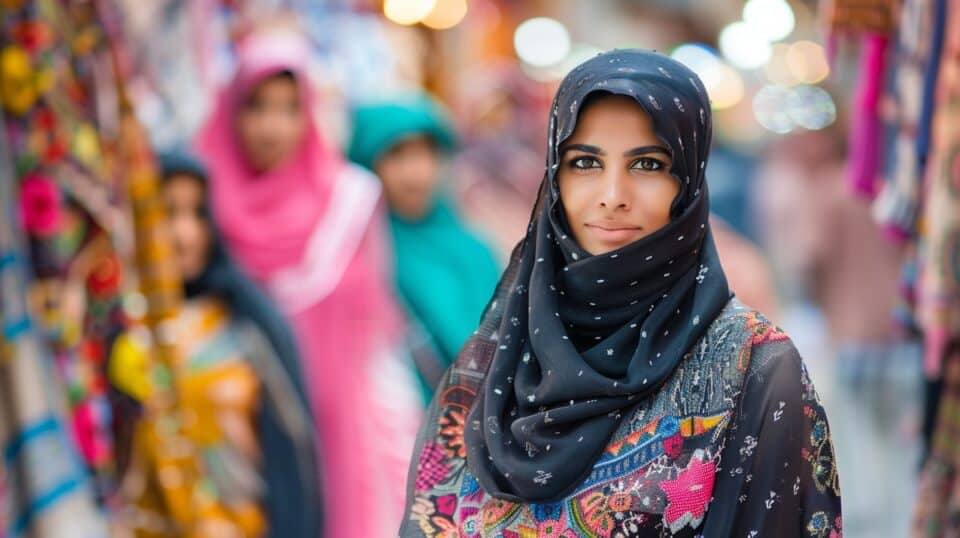
Dressing right in Saudi Arabia means learning their culture’s clothing rules. Before you fly with Saudi Airlines , know that wearing an Abaya and modest clothes is key.
Saudi cultural norms and attire requirements
Saudi Arabia values modesty in dress . Women usually wear long robes, known as Abayas, with headscarves called Hijabs outside their homes. The law changed in 2019, allowing foreign expats to skip the Abaya, but still advises dressing modestly.
This means outfits should cover arms and legs and avoid showing too much skin or having inappropriate images or text.
Breaking the dress code might just get stares, not legal action.
Visitors must respect these norms everywhere— from Riyadh’s busy streets to Jeddah’s Red Sea coast . While religious police can’t enforce rules on tourists, it’s wise to follow local customs for a smooth visit.
Essentials include loose-fitting pants, long skirts, maxi dresses for women, ensuring shoulders and knees are covered.
Essentials of wearing Abayas and modesty
Wearing Abayas shows respect for Saudi culture. Women find them in various colors like dark green, blue, purple, and gray, besides the traditional black. Online platforms like Modanisa offer them internationally .
Yet, buying locally at Saudi malls gives good deals with prices no more than 100 SAR (~£20.00). They are practical too; one Abaya is enough for a 2-3 week trip since they wash easily.
Under an Abaya, normal clothes such as jeans or a t-shirt work fine. This flexibility means comfort does not have to be sacrificed for modesty. Abayas blend tradition with modern needs seamlessly—providing both coverage and style while respecting local customs.
Dress Code Variations Across Saudi Regions
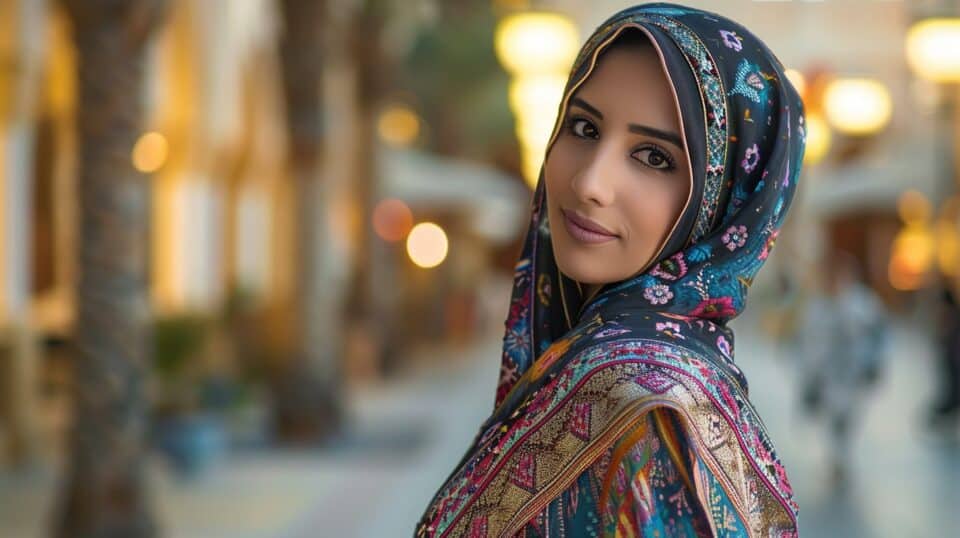
Saudi Arabia’s dress code changes from place to place. What you wear in Riyadh might not fit in Jeddah or the coastal areas, and AlUla asks for different styles too.
Attire recommendations for Riyadh
In Riyadh, women often wear long tunics or shirts that cover their hips with long sleeves. Pair these with loose trousers for a respectful and comfortable outfit. Black abaya s are common; however, you can choose ones in other colors too.
Always opt for modest clothing that doesn’t show your shape too much.
I found wearing an abaya easy to blend in at places like malls and restaurants. Shoes should be comfortable—flats work best, since you might walk a lot on uneven pavements. For visiting government buildings or religious sites, cover your hair with a scarf out of respect.
It’s less about strict rules and more about showing respect for local customs .
Suitable outfits for Jeddah
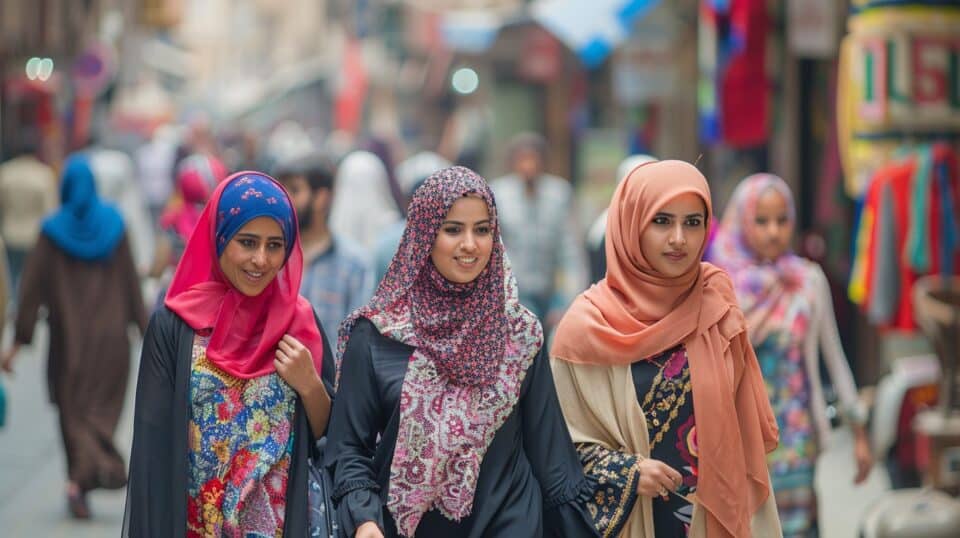
Jeddah’s vibe is more relaxed, making it okay for female tourists to wear loose, long dresses or skirts that go past the knees. Abayas are common, but not always a must. Light fabrics like linen keep you cool in the heat.
Tops should cover shoulders and be modest. Jeans and T-shirts are fine if they’re not too tight.
For footwear, sandals work well because of the warm weather. Just remember to stay respectful with what you choose to wear outdoors. Beaches near Jeddah allow swimsuits within private resorts or women-only beaches; a burkini is a good choice for public spots.
Fashion adapts to culture and climate—Jeddah’s relaxed dress code embraces both.
Next up: Choosing clothes for Dammam and Khobar brings another layer of cultural insights.
Choosing clothes for Dammam and Khobar
In Dammam and Khobar, women have options beyond the traditional black Abaya. You can wear long-sleeved tops and baggy pants or skirts that reach your ankles. Dark green, blue, purple, and gray are all good color choices for Abayas here.
While in these cities, I noticed many locals and tourists opting for vibrant hues , showing a bit more personality through their attire.
Shorts are not common for both men and women in Dammam and Khobar – it’s best to leave them at home. For footwear, comfortable shoes like flats or sneakers work well since you might walk a lot during your visit.
Remember to dress modestly to respect local customs, but feel free to incorporate some color into your wardrobe.
Appropriate wear for AlUla and Abha
In AlUla and Abha, it’s all about dressing smartly for the weather while respecting local customs. Lightweight, long-sleeved tops and loose pants work best. The heat can be intense, but these clothes keep you cool and fit right in with the cultural norm of modesty.
Always carry a shawl or scarf; they’re handy for covering your hair if needed.
Exploring these areas showed me that choosing breathable fabrics makes a huge difference. Outfits like maxi skirts paired with blouses are perfect. They offer freedom to move and keep you comfortable during long walks through historical sites or when enjoying the cool highland air in Abha.
Remember, comfort pairs well with respect here—opting for modest clothing shows understanding of Saudi customs.
Appropriate Attire for Specific Contexts
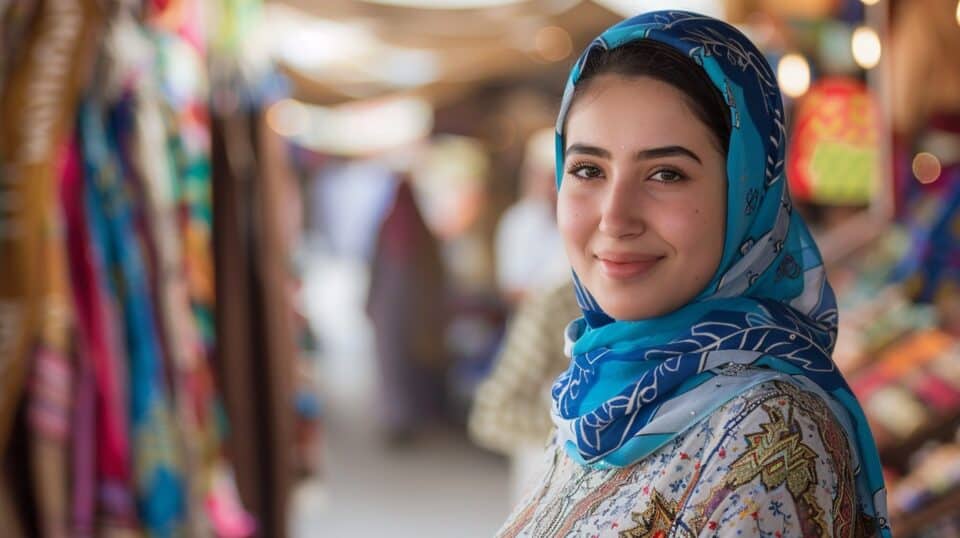
Knowing what to wear matters a lot in places like mosques, airports, and offices… Keep reading to get smart with your outfit choices.
Dress codes for religious sites
Covering your hair is a must at mosques. You should also skip wearing any religious symbols that aren’t Islamic. This shows respect and follows the rules. Outfits need to be modest, covering arms and legs fully.
Think long sleeves and pants or skirts that go down to the ankles. These small steps ensure you honor local traditions and can visit these sacred places without issues.
Choose clothes that are loose and made from breathable fabric , especially during hot months. Light colors are better as they don’t absorb heat like dark ones do. For women, wearing a scarf or shawl can easily cover your hair when entering a mosque.
Men should wear long trousers with shirts covering their shoulders.
What to wear at Saudi airports
At Saudi airports, women must dress modestly . Long tops, pants or skirts that cover the knees are ideal. Abayas are not required for non-Saudi females but wearing one shows respect for local customs.
Always choose light, breathable fabrics due to the country’s hot climate.
From my experience flying into Jeddah airport, pairing a loose-fitting long sleeve shirt with ankle-length trousers worked well. It kept me comfortable and aligned with cultural norms.
Shoes should be easy to remove, as you might need to do so at security checks. Flip-flops or slip-on shoes are smart choices. For those wondering about headscarves, they’re not mandatory in public spaces for non-Muslim women but keeping one handy is wise in case it’s needed at certain sites connected to the airports.
Office attire for expatriate women
In Saudi Arabia, expatriate women often wear long dresses or skirts paired with blouses for work. These outfits cover the arms and legs well, respecting local customs. Choosing black Abayas is traditional but now, colors like grey and navy are also popular in offices.
For meetings or formal events, adding a jacket over your dress can polish your look. My colleague always pairs chic trousers with modest tops for a professional vibe. Remember to select shoes that are both smart and comfortable for long workdays.
Accessories like simple jewelry elevate the office attire while keeping it respectful of cultural norms.
Tips for Female Tourists on Clothing and Etiquette
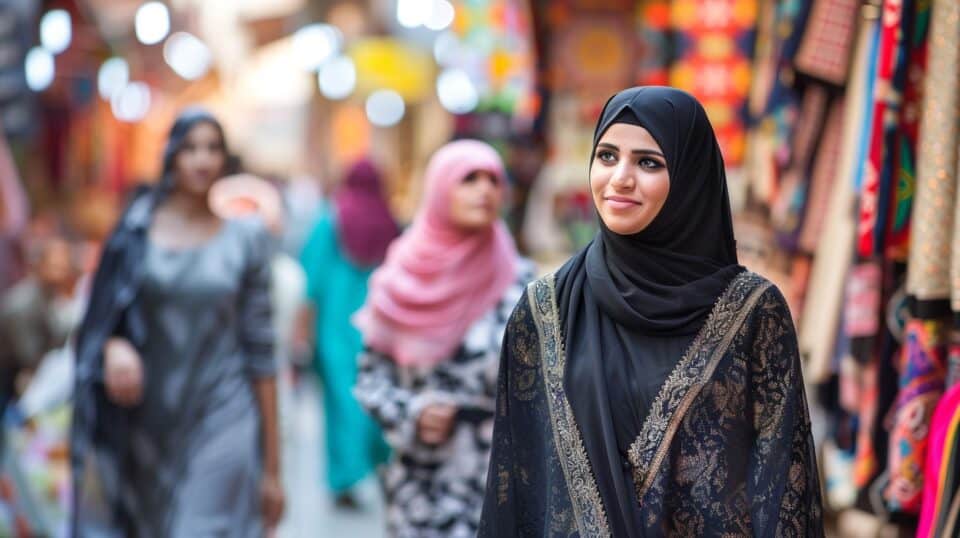
Dressing right shows respect for Saudi culture…and, well, it keeps you out of trouble. Think simple: Abayas outside, comfy clothes inside—plus a headscarf always handy.
Deciding on hair coverage
Foreign women can choose not to cover their hair in Saudi Arabia. This rule is clear—no need for a headscarf unless visiting a mosque. Always carry a shawl or scarf , just in case you decide to enter religious sites .
Next, think about what shoes to wear in this country.
Selecting footwear in Saudi Arabia
In Saudi Arabia, choose light, breathable shoes because of the heat. Closed-toe options work best for formal places. Stay away from casual flip-flops in public. This advice comes from my own trips there.
I found walking in markets and visiting museums more comfortable with sturdy sandals or sneakers.
Next up, we talk about guidelines for wearing jewelry and accessories .
Guidelines for wearing jewelry and accessories
Keep jewelry simple and minimal. Avoid flashy or large pieces. Small earrings, a watch, or a thin bracelet work well. This aligns with local customs and shows respect for Saudi norms.
Avoid religious symbols from any faith other than Islam.
From personal experience, blending in means choosing accessories wisely. Neymar faced criticism for his earrings and crucifix necklace—it’s clear, conspicuous religious symbols can draw unwanted attention.
Stick to understated items that don’t stand out too much.
Considerations for Wearing an Abaya
Picking the right Abaya depends on comfort and style… Don’t forget, wearing something beneath that keeps you cool is key.
Choosing styles and tips for Abayas
For Abayas, light fabrics work best in Saudi’s heat. Look for choices that breathe well, like cotton or linen. They keep you cool and fit the modesty rule. Markets sell them for less than 100 SAR (~$27).
I found long-sleeve tops perfect underneath to stay respectful yet comfortable. Mixing styles is okay too. You can wear colorful scarfs or belts with a plain Abaya to add some flair without breaking rules.
Comfort is key, so pick an Abaya size that allows easy movement. Tight ones are not only hot, but also restrict walking or sitting. Many shops offer various sizes and cuts – A-line shapes tend to be airier and more flattering for different body types.
Wearing baggy clothes under your Abaya isn’t just about following customs; it’s about feeling good while exploring Saudi Arabia’s rich culture and landscapes.
Options for undergarments with an Abaya
Under an Abaya, wear 3/4 length pants, jeans, or a T-shirt for comfort and modesty. Choose lightweight undergarments to stay cool in the hot climate . Bulky layers don’t work well; they add discomfort.
I find that leggings and simple cotton tops keep me comfortable and covered under my Abaya.
Avoid too many layers. A single layer of clothing is enough for both modesty and heat management .
Managing comfort and style in the heat
In Saudi Arabia, the summer heat demands clever clothing choices to stay cool and look good. Lightweight, breathable fabrics like cotton and linen are essential. They allow air to circulate, helping your body keep a comfortable temperature.
Long-sleeved tops and loose-fitting clothes not only respect local customs but also shield your skin from the sun.
I always choose light colors because they reflect the sun’s rays better than dark ones. A lightweight fleece or cardigan is a must-have for indoor places with air conditioning—from April to November, these can be real lifesavers against sudden chills.
Pairing an abaya with airy undergarments ensures comfort without compromising on style or modesty. Shoes that slip on and off easily make navigating through mosques and traditional homes hassle-free, while keeping feet cool in sandals is smart for beach areas like Jeddah.
FAQs About What Female Tourists Should Wear in Saudi Arabia
What should female tourists wear in saudi arabia.
In Saudi Arabia, women must dress modestly: long dresses or abayas that cover the body, and a headscarf for public places. It’s not just about following the law; it’s respecting local customs.
Can I wear Western clothes in Riyadh or Jeddah?
Yes, but with caution. Opt for loose-fitting items that cover knees and shoulders. Cities like Riyadh and Jeddah are more lenient, especially in private resorts where swimwear is allowed.
Do I need to wear a niqab or burka during my visit?
No, you don’t have to wear a niqab or burka. A headscarf suffices for most places except religious sites like Mecca and Medina where more conservative attire is expected.
How can I stay cool while dressing conservatively in the heat?
Choose breathable fabrics like cotton or linen for your abaya or dress. Light colors reflect sunlight, helping you stay cooler under the hot sun.
Is there any clothing item absolutely off-limits?
Yes, avoid anything too tight, transparent, or revealing such as miniskirts and tank tops to respect local norms and laws on modesty.
What happens if I don’t follow these dress codes?
Not adhering to the dress code could attract unwanted attention from locals or even lead to intervention by morality police (mutaween), emphasizing the importance of dressing appropriately.
ORIGINALLY PUBLISHED ON

The Complete Guide: Adapting Your Practice to Include Virtual Medical Assistants
Is Spanish Hard to Learn? 5 Challenges & Tips for English Speakers
Leave a Comment Cancel reply
Tidbits of experience.
We have plenty of life lessons that we’ve learned throughout our lives that we feel can help you make your life better.
Get Acquainted
Terms of Use
Privacy Policy
© 2024 Tidbits of Experience. All rights reserved.

What To Wear in Saudi Arabia As a Foreign Woman in 2024?
Categories Middle East , Packing , Saudi Arabia
Working out what to wear in Saudi Arabia as a woman, and what to wear in Saudi Arabia as a tourist and foreigner is a bit difficult as you may have heard, seen, and can imagine.
Many Muslim women in Saudi Arabia outside of their homes wear an Abaya to cover their body, a Head Scarf to cover their hair, and often a Niqab to cover their face. And in many cases, a full Saudi Arabia Burqa covering everything but their eyes, which I know as a tourist and foreigner to Saudi Arabia doesn’t seem that appealing!
So I bet you are thinking – what do female tourists wear in Saudi Arabia 2024?? and what do female expats wear in Saudi Arabia in 2024?
Well, I’m going to help you using my experience in Saudi Arabia as a foreign British woman and people who I’ve seen travel to Saudi recently.. because things have changed a lot even since I went in 2020!
What To Wear in Saudi Arabia As a Woman

Still need to book a flight??
I use Skyscanner to book all of my flights! I’m a huge fan of Skyscanner because I love how easy it is to compare different destinations and different dates for the best price and route!
For example, I type in ‘everywhere’ in the destination if I have fixed dates and want to find the best flights on those dates on Skyscanner .
And if I have a set destination I’ll look at the ‘month view’ to check the cheapest days to fly in that month!
Open Skyscanner by clicking here and search for the best flights as you read this post!
Find What You're Looking For Easily Here!
What Saudi Women Wear vs Foreigners
The biggest thing to note is that there is a BIG difference between what a woman from Saudi Arabia wears and what a foreign woman in Saudi Arabia wears , and there’s even more of a difference depending on whether the foreign woman is Muslim or non-Muslim .
Since 2019 it is no longer compulsory for women to cover their hair and wear an Abaya in Saudi Arabia which means that foreign women do not need to wear an Abaya or cover their hair.
This change in law is really good for non-Muslim woman visiting Saudi Arabia because it means you are more free to wear what you want.
However, from my 6+ weeks as a tourist in Saudi Arabia, I realised that there is a big difference between the Saudi Arabia laws of what to wear and the Saudi Arabia customs meaning that although I didn’t cover my hair and I felt totally fine in Saudi Arabia not covering my hair (except for Medina ).
I felt more comfortable wearing an Abaya in Saudi Arabia and I still wore one every day!
Using my experience, I will help you work out what to pack for Saudi Arabia, what women wear in Saudi Arabia and what to wear in Saudi Arabia as a tourist. Yalla!
- To help you with the rest of your trip to KSA, check out my other blog posts:
- Things to do in Riyadh, like a local!
- My Riyadh Travel & City Guide!
- Guide to the Diplomatic Expat Quarter in Riyadh!
- Visiting Medina as a Non-Muslim.
- Tourists Guide to Old Jeddah!
- How To Get a Sim Card in Riyadh Airport!
- How To Travel Saudi Arabia on a Budget!
Do Tourists Need to Wear an Abaya in Saudi Arabia?
Let’s start with the main question around what do women have to wear in Saudi Arabia and what should a woman wear in Saudi Arabia – Abaya’s!
In late 2019 it was announced that women do no longer need to wear an Abaya in Saudi Arabia . This was at the same time that the tourism e-visa for Saudi Arabia came into place.
I have met foreign women, ex-pats specifically, who stopped wearing an Abaya in Saudi Arabia at that time in Jeddah and Riyadh .
During my time in Saudi in 2020 and my experience as a foreign woman and tourist in Saudi Arabia, I always wore an Abaya outside of my accommodation .
However, Saudi is constantly changing and I have seen a few of my travel blogger friends go to Saudi in 2022 & 2023 and they didn’t wear an Abaya . They wore a fairly modest dress instead, covering most of their arms, legs and chest in Jeddah, Al-Ula and Riyadh and they were comfortable doing so.
Related Post: Here is my Riyadh Travel Guide and all the things I wish I had known about Riyadh before arriving!
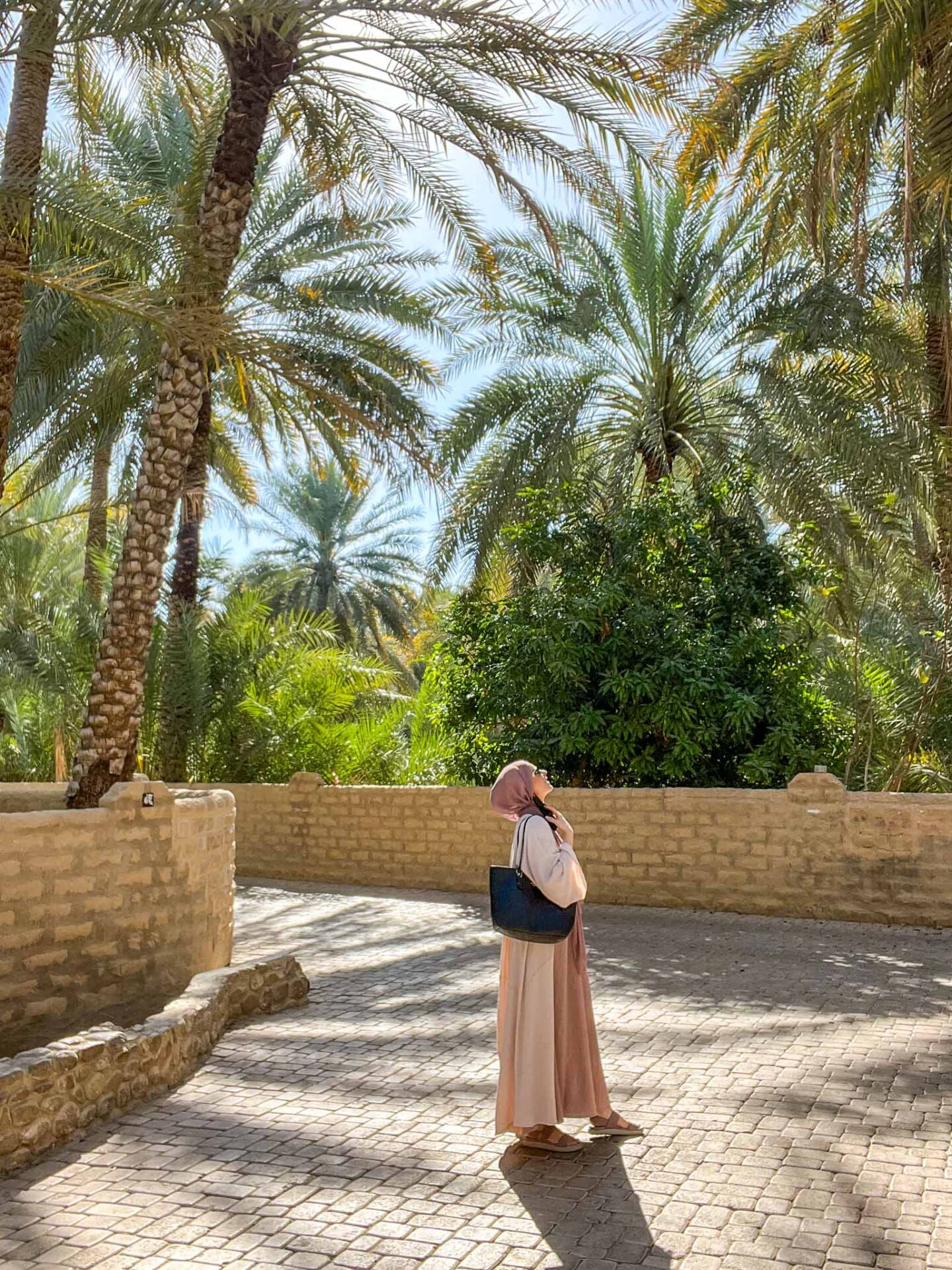
Why I wore an Abaya in Saudi Arabia ?
Personally, I got a lot of stares and looks from people here as a blonde, white, western woman in Saudi Arabia, which is understandable, but I feel that if I was not wearing an Abaya I would get even more looks .
Before I arrived in KSA I thought that an Abaya might make me stand out because it was obvious this is not my usual dress sense, but that is far from what happened .
If you are a foreigner, you will stand out MORE without an Abaya than with one . And you will definitely stand out if you show a lot of skin in an outfit that isn’t an Abaya, even nowadays in 2023!
If you do not wear an Abaya, legally, no one can tell you off. You may have heard of the religious police in Saudi Arabia, the Religious Police lost a lot of control a few years ago and are no longer around . However, you still need to dress conservatively whether you decide to wear an Abaya or not.
Dressing conservatively and working out what should a woman wear in Saudi Arabia and what do female tourists wear in Saudi Arabia, means that you should have little skin on show and not wear anything that is too tight .
Can I wear anything in Saudi Arabia?
If you do not want to wear an Abaya in Saudi Arabia, I recommend on your Saudi Arabia packing list you include tops that cover your arms, chest, are a bit baggy and are longer to cover your bum .
Long sleeved kimono’s are a great choice instead of an Abaya too, especially in Jeddah where local women tend to wear different styles of Abaya because Kimono’s are easier to purchase for many, lighter in material and shorter so you might get on better with one than an Abaya.
Jeans are fine but I would suggest you have a top that covers your bum and hips if they are tight.
Saudi Arabia gets extremely hot in the summer months but that doesn’t mean you can put shorts on or a dress that is revealing .
This is why, in my opinion, it is easier to wear an Abaya as a female in Saudi Arabia because you can’t go wrong. You put it on and you know you’ll be covered!
It is also the local custom to wear an Abaya here. Often when we travel we want to dress like the locals and wear traditional clothes, well here in Saudi Arabia, that means wearing a black Abaya and personally, I enjoyed wearing it.
I didn’t feel oppressed, I actually felt quite glamorous! And if black is too much for you, get a pink or cream one!
What to wear in Jeddah
Jeddah is the one city you will feel more comfortable in without an Abaya or wearing an open Abaya, because people in Jeddah are used to ex-pats and foreign workers and it has a much more relaxed atmosphere.
What to wear in Dammam and Khobar
Damman and Khobar which are coastal cities close to Bahrain are also cities that are pretty relaxed and used to foreign ex-pats wearing different clothes to locals.
What to wear in AlUla
If you are visiting the popular place of AlUla you will also feel comfortable without an Abaya and potentially more revealing clothes due to how many foreigners visit AlUla and the type of modern vibe they are creating there.
What to wear in Riyadh
Riyadh is getting more progressive and modern as each month goes on.
I personally did wear an Abaya in Riyadh and I liked wearing one there but aside from Jeddah and AlUla you will probably feel most comfortable not wearing an Abaya in Riyadh.
The only time I didn’t wear an Abaya in Riyadh personally was when I did the Edge of the World Tour and the Red Dunes Tour because pretty much everyone on them were tourists, expats or young Saudi’s who had obviously travelled a lot and the Saudi women weren’t wearing Abaya’s either.
Plus, walking around at the Edge of the World or up Sand Dunes in an Abaya if you’re not used to it is very tricky! lol.
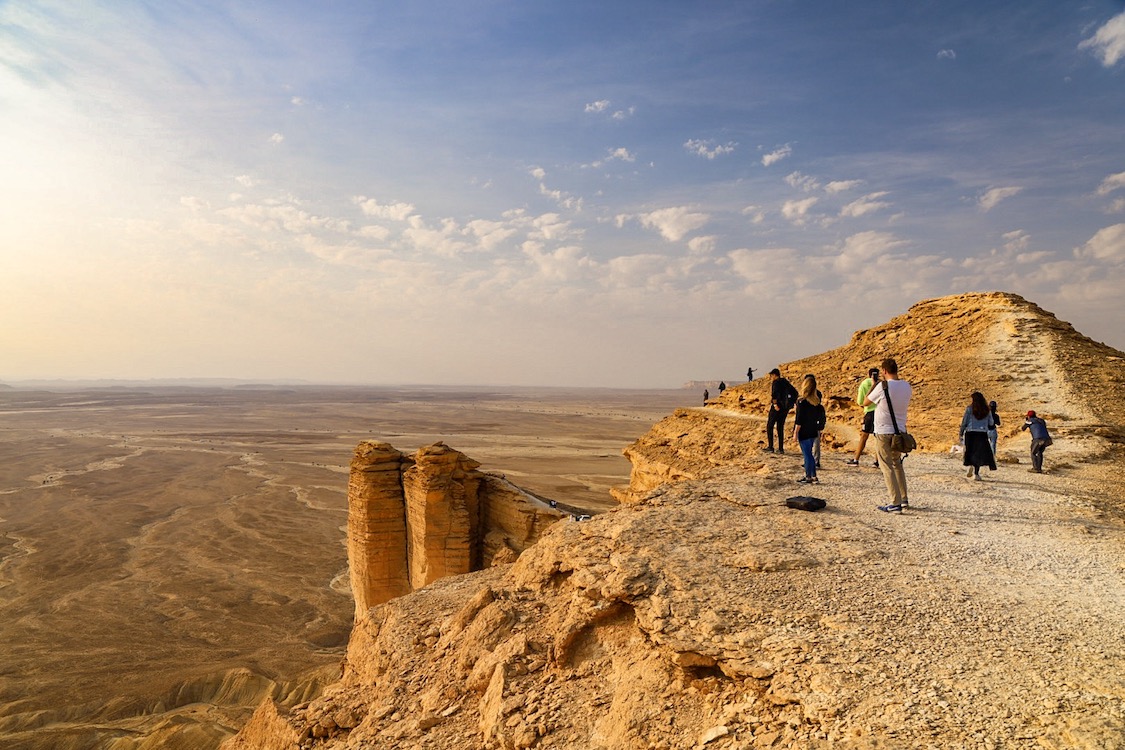
What to wear in Abha
The other cities and towns in Saudi Arabia may find it very strange that you are not wearing one, for example, I went to Abha and I didn’t wear one in a restaurant complex one night and I had a lot of people staring at me! But legally you do not have to, so you cannot get in trouble for not wearing one.
However, places like Abha are a great chance to try on and buy Abayas that are local to the region with bright colours like mine below, and they make for great photos!
What to wear in Saudi for work as a foreigner?
I know many people read this blog post because they are visiting Saudi for work , sometimes to move there permanently but sometimes for just a few days for a meeting or event.
If you are moving to Saudi permanently you have time to speak to your company and get advice on what to wear.
If you are visiting for a meeting or event for just a few days, you may be given an idea of what to wear but you may not. I get many comments on this post from ladies who have decided to buy an abaya to wear in Saudi for a business event which I think is a nice idea.
Depending on who you are meeting or who is running the event, i t is very respectful to wear an Abaya as a visitor in Saudi and i t will no doubt impress those you are visiting .
I would say, unless you have been told you have to wear an Abaya, you won’t be expected to wear one as a foreign guest in Saudi, however, you will probably be expected and it will definitely be respectful of you to wear a long dress or skirt and top with the majority of your legs, arms, back and chest covered.
What Abaya To Wear in Saudi Arabia?
The most common Abaya colour in Saudi is Black and most Saudi women will be wearing a black Abaya.
There are no rules on what colour Abaya to wear in Saudi and these days women do wear different colours like dark green, blue, purple and grey, especially in Jeddah and AlUla.
Depending on where you live or travel before Saudi Arabia, you may be able to buy an Abaya before you get here . I visited Kuwait before Saudi. I didn’t have to wear an Abaya in Kuwait but they did have plenty on sale in the Souk I visited so I got one and was able to put it on on the plane and wear it when I landed.
This will be the same in Turkey, Bahrain, Oman and the UAE so if you visit any of these Middle Eastern countries first, buy one there so you can put it on when you arrive in Saudi Arabia.
It’s also worth finding Muslim areas near where you live , you’ll probably be surprised how many Abaya’s are about, for example if you’re in London to go Arab areas of London like Whitechapel and you’ll see so many shops to buy an Abaya from!
Websites like Modanisa based in Turkey ship internationally and are reasonably priced so they are good to use to buy Abaya’s and modest clothing, although check shipping times as if your trip is coming up soon they might not arrive on time.
View this post on Instagram A post shared by modanisa (@modanisa_uk)
What should I wear to Saudi Airport?
If you can’t get an Abaya before arriving, that’s ok. You are completely fine arriving in Riyadh Airport, or Jeddah Airport with no Abaya .
Related Post: How To Get a Sim Card in Riyadh Airport! It’s really easy to get a tourist prepaid Saudi Arabia sim card in Riyadh Airport!
If you arrive in Saudi without an Abaya and want to get one, all Malls in Saudi Arabia will sell Abayas. Some Abaya shops can be expensive so keep an eye on the prices in shops, but if you go to a mall with a local looking market inside it, you will get a cheaper one.
If you buy one in Saudi Arabia you will be able to get a basic Abaya for under 100SAR very easily.
What Abaya should I wear in Saudi?
If you decide to buy an Abaya for Saudi, from my experience, you should look for an Abaya that:
Is Black, or another colour of your choice.
Has buttons. Some Abaya’s do not have buttons and are more like a long dress that goes over your head and cover all your chest, they are ok but without buttons, they will be hot to wear.
Some have a zip but again, they will be hotter. The buttons give a breeze and give you the option to have the Abaya open or closed.
Has buttons all the way down. I have one Abaya with a button just at the top and in the wind, it blows open which is annoying so I prefer my Abaya with buttons all the way down it as I can keep it fully closed or open it more depending on where I am.
Goes all the way to your feet. This isn’t a must and it doesn’t need to touch the floor but if you want to do as the local ladies do, it should be as long as possible.
Is a light material . Saudi Arabia is cold in the winter months and you’ll actually want a thicker Abaya then but outside of winter in the Spring, Summer, and Autumn, you will want an Abaya that is light and not too thick or heavy so that you do not get too hot.
Isn’t too cheap. If you are visiting Saudi Arabia for a short time, you don’t want to spend too much money on an Abaya but be sure that the material is not too cheap as it could make you very hot.
Is no more than 100SAR / £20.00.
Even if you are in Saudi for 2-3 weeks, I’d say you only need 1 Abaya , they are easy to wash and clean and from my experience, they don’t get too dirty so don’t worry about getting more than one.

What to Wear Under an Abaya in Saudi Arabia?
Normal clothes!
Of course, this will depend on the temperature and how well you cope with wearing clothes in the heat, I do not cope well with this!
You can’t wear shorts under an Abaya for example, but you can wear baggy 3/4 length pants or a skirt underneath with a small, lower, part of your leg showing.
You can wear jeans.
You can wear a jumper, t-shirt, or if it’s hot, you can wear a tank top which will keep you cooler. Just be careful not too show too much chest skin if you wear less clothes underneath.
I really like H&M for long dresses to wear under an Abaya or 3/4 bags trousers. Click here to have a look at options!
Do Tourists Need to Cover Their Hair in Saudi Arabia?
This law also changed recently but before the Abaya law. Covering your hair in Saudi Arabia and wearing a Hijab in Saudi Arabia is NOT needed unless you go inside a Mosque and unlike the Abaya culture and law, you will feel fine with your hair out in public as a tourist and non-Muslim in Saudi Arabia.
The only place I covered my hair in public was in the holy city of Medina .
It is a good idea to have a shawl or scarf on you most of the time , just in case, or just in case you feel like you’re being stared at a lot and you can put it on because when it comes to what do women wear in Saudi Arabia, most women here do cover their hair, and face, in public.

FAQs about what to wear in Saudi Arabia:
Here are answers to frequently asked questions about what to wear in Saudi:
What do tourists wear in Saudi Arabia?
Tourists do not need to wear the same clothing as local Saudi’s wear but both women and men must wear clothing that doesn’t show too much skin. Not only are you being respectful by doing this, you will also feel more comfortable.
No. Although there is much more flexibility and openness on what men and women who are tourists in Saudi Arabia can wear, you must still wear clothes that look respectful and cover most of your skin, especially your legs for both men and women.
What do men wear in Saudi Arabia?
You’ll see most men in Saudi wearing a white Thobe, also known in the Middle East as a Kandura. As a male tourist in Saudi, you do not need to wear one of these (although they are extremely comfortable and light to wear so you should try it at least once!), instead you can wear any type of long trousers, t-shirt, shirt, jumper etc.
Can I wear shorts in Saudi?
In many countries, especially in Muslim countries, it’s best to do as the locals do and in Saudi Arabia, men do not wear shorts outside their house. This means that as a tourist in Saudi Arabia you should avoid wearing shorts too so you respect the local custom and don’t make yourself stand out. This applies to women too, even under an Abaya, unless you definitely can’t see you legs, it is not a good idea to wear shorts in Saudi Arabia because it isn’t what most people are used to seeing and you will get more stares.
Can I wear ripped jeans in Saudi?
The fashion in Saudi Arabia is changing dramatically. Whilst once you might get told off for wearing ripped jeans in Saudi, this is definitely not the case now, but also, it’s not really common for local Saudi men or women to wear ripped jeans as they do look messy. Small rips are ok but don’t take your biggest ripped jeans on a trip to Saudi Arabia!!
What happens if you break the dress code in Saudi?
As a tourist in Saudi, nothing happens if you break the dress code. There is no one there to officially tell you off so please do not worry about that. If you dress definitely to the locals you will get more stares as they are not used to seeing this and you may get denied access into mosques or some religious places if not properly covered but no-one should actually tell you off.
What do Women in Saudi wear?
Many of the Muslim women in Saudi Arabia outside of their homes wear an Abaya to cover their body, a Head Scarf to cover their hair, often a Niqab to cover their face. And in many cases, a full Saudi Arabia Burqa covering everything but their eyes.
I hope this helps you work out what Saudi Arabia dress for females is like and what do tourists wear in Saudi Arabia.
To SEE my time in Saudi Arabia, have a look at this YouTube video and the others on my channel !
- A Complete Tourists Guide to Old Jeddah!
- ALL MY SAUDI ARABIA BLOG POSTS
If you liked this please share it! 🙂
- Click to share on Facebook (Opens in new window)
- Click to share on Twitter (Opens in new window)
- Click to share on Pinterest (Opens in new window)
- Click to email a link to a friend (Opens in new window)
By using this form you agree with the storage and handling of your data by this website. *
Monday 29th of January 2024
Thank you for the great advice on what to wear! What about shoes? Can you wear Sandler or do they have to be closed shoes like running shoes? Black I’m assuming?
TheWanderingQuinn
Wednesday 7th of February 2024
Hello, I'm glad you found it helpful. You can wear whatever shoes and sandals you like. They can be open toed with no problem and any colour. You'll probably see local ladies in high heels and abayas :)
Wednesday 6th of December 2023
This was really helpful. I was born and raised up in Dubai but I can understand the rules of Sharjah and Jeddah are similar. &definitely I was a bit confused on knee length clothing. Ill keep in mind to get more coords with longer tops, or jackets to either tie it on my waist. And also I'll get more longer tops - Im not forgetting to carry my shawls and 1 abaya - to be on the safer side. Thankyou again.
Monday 11th of December 2023
I'm glad it was helpful! :)
Sunday 15th of October 2023
I would love some opinions on the subject of abayas. I visited Saudi Arabia earlier in the year and packed two beautiful abayas bought in London and several western long button through shirts to wear over jeans and dresses. I travelled to Riyadh, Jeddah, Red Sea and Alula, and other cities and towns, I was respectfully dressed at all times but did not wear the abayas. I felt too shy and wondered if it might be seen as cultural appropriation. I am returning to Saudi soon and I would be very interested to know people's thoughts.
Monday 16th of October 2023
Hello, I'm glad you bought some Abaya's they are lovely aren't they. I know what you mean by thinking it could feel like cultural appropriation however you'll see many foreigners wearing them as this is the 'standard dress code' (although less now as you might have seen), I also believe that cultural appropriation should be worried about more when countries / cultures were subject to colonialism / were overpowered which isn't the case in Saudi so there isn't that sensitivity around cultural dress there :)
Thursday 7th of September 2023
Hi, and thank you for the very useful information that you shared! What is not clear for me is the 'role' of abaya. I'm going for a 1-week business trip, and will work in an office environment. I like the idea of wearing an abaya, so i'd like to wear one while there. But how is it in an office? Do women wear the abaya the whole day in the office (meaning they have a lot of abayas as we have trousers/skirts/dresses) or do they take it off when entering the office, so it is more like a coat above their dresses? So, shall i buy let's say 2 abayas, and wear those for the whole weak and bring only stuff for under it, or shall i pack Western style business clothes for each day because they will be visible?
Hello, very good question!
The abaya is designed to be kept on even inside (when men are present). It's not treated as an outside garment that gets taken off once you are inside.
However, as a foreigner and tourist you can really do as you please. I'd say to take western business style clothing as you will be fine to wear these and better to have them just in case you feel more comfortable in them.
However, if you wish to try an Abaya, you can and should, taking 1 will be fine for 1 week and you can dress it stylishly over your work clothes, more like a kimono having it open and taking it off as and when you please, or you can have casual comfy clothes under neath it and do it up and keep it on. I hope that helps :)
Monday 26th of June 2023
Hi! Any updated advice about visible tattoos on arms/wrists/hands? Trying to figure out just how relaxed their getting in 2023.
No need to worry at all. I have tattoos on my lower arms and wrist and no one said anything. Even now that I'm Muslim, no one says anything as it's not a problem :)

What to wear in Saudi Arabia dress code advice

Are you wondering what to wear in Saudi Arabia and what the official Saudi Arabia dress code is? Obviously Saudi is a conservative Muslim country located in the Middle East . As such and as you would expect there’re strict rules about what you can and can’t wear. In this guide we answer your most burning Saudi Arabia dress code questions to make sure you know what you can wear and where and any location specific requirements to make sure you stay culturally appropriate.
Important Note : This post may contain affiliate links which means if you click through and make a purchase I will make a small commission at no extra cost to you.
Table of Contents
How do Locals Dress in Saudi Arabia?

Before we get into how to dress as a tourist in Saudi Arabia (or Kingdom of Saudi Arabia or KSA as it is sometimes known) it is worth looking at how local people dress in Saudi Arabia. The Saudi Arabian National Dress is commonly worn by Saudi Nationals in KSA and you will definitely see it as you wonder around the cities and many tourist attractions.
Men in Saudi largely dress in national attire which usually consists of a long white dishdasha (thobe) with a headdress. This headress is often red and white in color and is called a ghutra and is usually acocompanied by a long black cord to hold it in place and is known as an iqal.
For special occasions and events of importance men may also wear a bisht, a black cloak with gold trim which you may have seen being bestowed on Messi after the Argentinian World Cup win in Qatar .
But it is not only men who wear national dress in Saudi women do too. However you may find that the dress of women changes depending on what part of the country you are in. Most local women will wear a long black cloak over regular clothes called an abaya along with a Shayla which is a traditional head covering.
However you may also find women in Saudi wearing a niqab. Niqabs are commonly worn in Saudi Arabia but aren’t as commonly seen in other gulf places such as Dubai , Abu Dhabi and Qatar . A Niqab is a full face veil where just a woman’s eyes are visible. But you will also find women wearing a burqa which covers the whole face including the eyes.
However others will just wear a loose hijab. It really will depend wear you are in the country or what type of attraction you are at as to what you commonly see. However overall I would surmise the Saudia Arabian dress code for women as conservative.
Things to consider for What to Wear in Saudi Arabia
When you are putting together your what to wear in the Saudi wardrobe there are a few things you want to consider.
Dress code requirements
The Saudi Arabian dress code requires conservative dress where everyone covered knees and shoulders – more on this later.
But this should really heavily influence what you pack to wear in Saudi Arabia. Everything you pack should adhere to the dress code rules except for clothing that you are planning to wear in the 5* hotels and resorts where the dress code is not as strict.
After the modesty required by Islamic law, the next thing that will influence your Saudi Arabia packing list is the heat. Saudi Arabia in summer gets very hot so you will need to pack lots of light and natural fabrics.
Therefore whenever you are traveling to the Saudi Arabia you need to make sure you pack lightweight and breathable clothing whatever time of year you are there.
However having said that I would also advise anyone traveling to Saudi Arabia to always pack a pashmina or top layer. A pashmina is the perfect pick as it can be used to add some extra modesty to the outfit, but also provide an added layer when you are indoors where the air conditioning can be very very strong.
What activities you are doing?

One of the things that we love about visiting the Saudi Arabia is the sheer range of activities and attractions that are available. From desert safaris, to the religious sites, KSA has many things on offer to tourists.
If you are visiting the Mosque or religious sites for instance you will need to be sure to pack an outfit that covers you from wrist to ankle swell as having a scarf for head covering.
While if you are planning on heading into the desert to see some of the amazing archaeological sites Saudi Arabia has on offer you would need to have long loose clothing that will keep you cool. However if you are staying out overnight in the desert you will need some layers as the temperatures will drop at night.
We recommend trying to plan out at least some of your Saudi Arabia itinerary in advance to be sure you pack correctly for your whole trip.
Slogans and Graphics
You should avoid wearing items of clothing that have political statements or slogans or graphic that could be deemed rude or offensive. For this reason I advise packing only plain or patterned clothing items over graphics and slogan wear.
What to wear in Saudi Arabia as a woman?
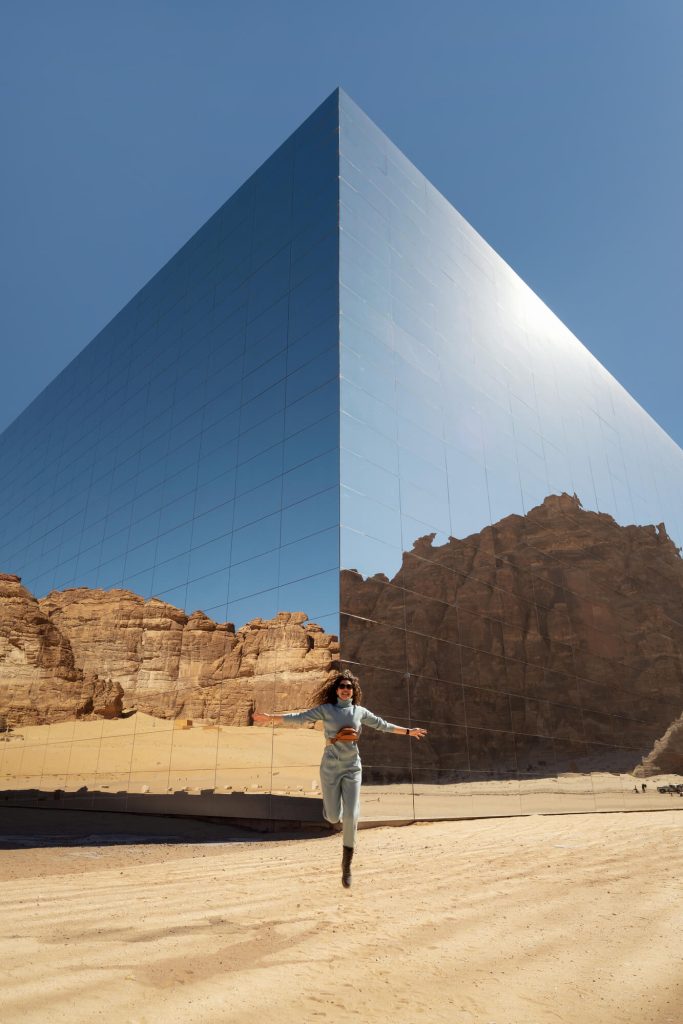
For a long time Saudi Arabia wasn’t a viable destination for western, non-Muslim travelers due to the Visa requirements for entry into the country. However since 2019, Saudi Arabia has introduced a new type of tourist visa and is fast trying to position itself as a tourist destination in the Middle East.
Alongside the introduction of the new tourist visa came a relaxation with the rules regarding what to wear in Saudi Arabia as a female tourist.
However although there was a relaxation in what clothes tourists can wear in Saudi Arabia, it does not mean you can wear exactly what you would in the west.
It is important to remember that the Saudi Arabia dress code for women means females have to:
- keep their shoulders covers
- Keep their knees covered
- Not show Cleavage
- Wear nothing tight, revealing or see through.
Therefore when I am looking to pack for Saudi Arabia I would put the following on Saudi Arabia packing list for women:
Maxi Skirts
A Maxi skirt is always on my Saudi Arabia packing list as they are both modest and cool. You just need to make sure that the skirt doesn’t have a slit that reveals your knee or thigh as this would be against the Saudi Dress code rules.
A Maxi skirt is always on my Saudi packing list as they are both modest and cool. Again as piece of clothing providing that there isn’t an overly high slit that reveal your knee if you are going to religious sites.
A Maxi dress is another staple of my Saudi packing lists. I try and pick one made of a natural fabric such as cotton so it is more breathable.
I would advise picking a dress that has at least some cap sleeves to make it more appropriate for the Saudi Arabian dress code.
Click here to shop Maxi Dresses
Blouses and T unics
Blouses and tunic that covers the shoulder and arms are great wherever you are heading in Saudi Arabia.
I advise picking tops as well that cover your bum so blouses and tunics are your best bet.
Cardigan
It might sound strange to be heading to a country that has daytimes temperatures in the 30s even in the winter but listen.
The reason is because the indoor venues such as the mall and cinemas the air conditioning is very strong so you will want an extra layer.
I will talk more about swimwear requirements below but you will want to have a one piece with you for swimming in hotel pools.
Beach Cover
It is definitely not appropriate to walk around anywhere in Saudi in swimwear, Make sure you have a modest beach cover for as soon as you leave the water.
For any trip to the Saudi Arabia no matter the time of year you are traveling we recommend taking a pashmina. This is for several reasons:
- The air conditioning can be very strong so you may want to have a pashmina as an extra layer for some indoor locations
- It can be used to make an outfit more modest when required.
- Can be used as a head scarf if you are visiting religious sites where this is a requirement.
This goes without saying.
A light weight pair will suffice.
The sun is very strong in the Saudi Arabia so you need to protect your face from the sun while walking around the city and for hanging out on the beach. Having a sun hat that can work on the beach and in the towns is best as this will reduce the amount you need to pack.
Click here to shop sun hats
As I said sun safety should be your top priority when traveling around Saudi Arabia. One of the best ways of protecting yourself is to pack a good pair of sunglasses that have good UV Protection.
Do I have to wear an abaya as a female tourist in Saudi Arabia?
Up until 2019 female tourists in Saudi Arabia had to wear an abaya. However this is no longer the case.
The only place it is compulsory for female tourists in Saudi Arabia to wear an abaya is at religious sites such as mosques and other holy places.
However I would always add an abaya to my Saudi Arabia packing list as you never know when you may need one or feel more comfortable wearing one than Western clothing.
You can buy this online in advance on places such as amazon or pick up one at the airport.
Do I have to wear an hijab in Saudi Arabia?
As with the rules on abayas, the rules on hijabs also changed in 2019. While it used to be compulsory for females in Saudi Arabia to wear hijabs everywhere, not you only have to wear one at religious sites.
However I would always carry a pashmina, in case you find you need to cover your hair somewhere. Pashminas are also handy for indoor places in Saudi Arabia that have strong air conditioning.
It is worth pointing out that if you are visiting other countries in the region be sure to check out our what to wear in the Middle East post which offers a helpful country comparison on which places head scarves are required.
Can you wear jeans in Saudi Arabia?
Yes you can absolutely wear jeans in Saudi Arabia but with some caveats. Firstly I don’t recommend it especially if you are visiting Saudi in summer when the temperatures skyrocket unless you are staying indoors in places such as malls.
Also if you wear jeans you will need to team them with a longer length top that covers your bum such as a tunic.
Can you wear ripped jeans in Saudi Arabia?
The question of can you wear ripped jeans in Saudi Arabia is a controversial one but I would say that you should avoid wearing ripped jeans in Saudi Arabia. Ripped jeans reveal more flesh than regular jeans so it is best to play it safe and leave these at home.
Can you wear skinny jeans in Saudi Arabia?
Anything tight fittings is a big no no in Saudi so leave the skinny jeans at home.
I personally would opt for jeans other than skinny.
Can I wear leggings in Saudi Arabia?
As leggings are tight I would advise leaving the leggings at home when packing for Saudi Arabia.
Can I wear a bikini in Saudi Arabia?
Unless you have your own private villa with pool it is not recommend to wear bikinis. If you are swimming at a resort then we recommend a one piece over a bikini and having a cover for as soon as you leave the water.
And in some places you will feel more comfortable in a burkini over western swimwear.
What is the Saudi Arabia dress code for men?
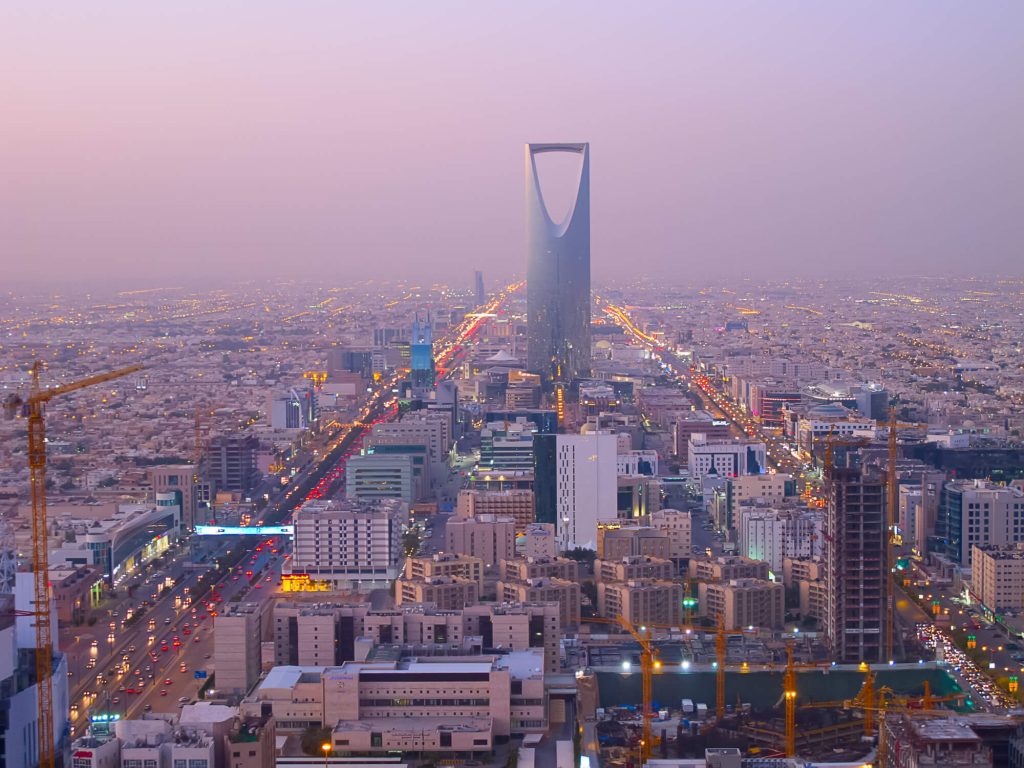
If you are wondering what the Saudi Arabia dress code for men is the answer is that it is very similar to the Saudi dress code for women.
For some reason many people think that the Saudi Arabia dress code rules and conservative dress only applies to women in Islamic countries (check out our guides on what not to wear in Qatar and what not to wear in Dubai for comparison), however this simply isn’t true.
The Saudi Arabia Dress code for men says that
- Men must keep their shoulders covered
- Men must keep their knees covered
Can men wear shorts in Saudi Arabia ?
Bearing the above in mind any short a man wears in a public place should cover the knee. However if you are in the 5* hotel resorts then this is an exception to the rule.
I would advise men traveling to Saudi Arabia ait to stick to lightweight cotton chinos and linen trousers instead of shorts.
And if you do pack shorts make sure they cover the knee. Cargo shorts are the most popular style that usually meet this requirement but I would always say trousers are a safer choice.
What to wear in Saudi Arabia for Children
If your children have not yet hit puberty the dress code rules do not apply. However I try and keep my kids well covered for sun protection.
Best Shoes for Saudi Arabia
When I am thinking about the best shoes for visiting Saudi Arabia sandals have to be top of the list.The sun is hot in the Saudi Arabia no matter the time of year you travel and these can be used in a variety of places such as the mall and the beaches.
However if you are going to the desert or to see archaeological sites you may also want to consider a closed toe shoe to protect your feet from hot sand in summer.
While my go to shoe for Saudi Arabia has to be a sandal, I would also advise taking a sneaker. Although there are lots of indoor things to do in Saudi Arabia this doesn’t mean that there isn’t any walking to be done.
Also if you head out to the desert and want to do some desert sports you will want to have a closed toe shoe.
Our go to brands are:
- Sketchers Go Walks or
Click here to shop good sneakers
Although the most important shoes for Saudi Arabia are definitely sandals and sneakers, you may also want to pack a pair of flip flops with you for wondering around the pool and beach. However I do not recommend them for the desert as the sand will get in your shoes and you will have no protection from hot sand in summer.
Click here to shop flip flops
And remember if you are visiting religious sites you will need shoes that are easy to slip on and off.
FAQs About Saudi Arabia Dress Code?
Can i wear make up in saudi arabia.
Yes you can wear make up in Saudi however if should be more neutral rather than heavy bright colors.
Can I wear jewellery in Saudi Arabia?
Yes you can wear jewelry in Saudi Arabia but you should keep it to a minimum so it isn’t over the top.
What to wear in Saudi Airports?
I would advise dressing modestly at Saudi Arabian airports whether you are transiting or entering the country.
What to wear in Saudi Arabia in Winter?
Although the desert, Saudi Arabia can be cool in Winter. Therefore we recommend packing some layers such as cardigans and jumpers for winter alongside jackets and top layers for those heading out to the desert.
Tales of our life in Saudi Arabia
The Expat Adventures
- Oct 3, 2023
The Ultimate Guide to What to Wear in Saudi Arabia
For those of us that weren't familiar with modest fashion prior to moving to the Kingdom, figuring out how to combine our personal style with the unwritten rules and dress codes in Saudi Arabia can be challenging to navigate at best, stressful and anxiety inducing at worst. I decided to finally tackle it and write a comprehensive guide on how I approach the topic.

There is a big difference between what Saudi women wear and how foreigners dress. There is even a difference between what locals and expat muslim women wear. Saudi women often choose a niqab to cover their face, while a lot of muslim expat women opt to wear a hijab and abaya or similar to cover their hair and body whereas some of us Westerners eventually decide to hang up our everyday abayas as we become more confident and comfortable with the culture and customs.

No Need to Cover up From Head to Toe

One of the most prevalent misconceptions about Saudi Arabia is the outdated view that it's compulsory for all women to cover their face and hair or wear an abaya when going outside.
Women nowadays have a lot more freedom to decide what to wear and we can no longer be legally stopped for not conforming to the traditions of dressing very conservatively.
As a blonde Western woman I know I won't blend in but I seldom feel uncomfortable and I'm no longer self-conscious when I have to leave the house or go to an area less frequented by expats, but I always actively try to avoid attracting unwanted attention.
Saudi is constantly changing, but it's still advisable to remain modest and cover arms, legs and chest and avoid overly tight fitting clothing when leaving the house, out of respect for local tradition and customs.
Any Colour Goes

There's always a sea of black niqabs in public places, but women, especially foreigners, are not at all expected to conform to wearing this traditional garment. I even notice more and more muslim women (primarily from younger generations) choosing to wear fashion forward, intricately adorned or colourful abayas.
Creams and pastels appear to be very popular, but when the Barbie movie came out in August, I frequently spotted groups of young girls in coordinated pink outfits as well. There is no limits to what colours women are allowed to wear.
Let's take a moment to praise the abaya
"celebrate the abaya as a garment of style and modesty much like the kimono and sari [...] with Japanese and Indian cultures. In my view, the abaya is a garment of expression rather than of oppression." - Farheen Allsopp
Abayas are basically a cheat code to always looking appropriate and stylish. They're perfect for layering over t-shirts or vests or more tight fitting clothing. They're not practical with shorts as the bottom is open to help facilitate movement. Depending on the setting and occasion most of the time I no longer wear an abaya when leaving the house, however, I always have one in the car just in case. And when I want to immediately elevate my look, I just throw one on and off I go.

Abayas come in an endless variety of fabrics, all colours of the rainbow and intricate patterns such as embroidery or tulle details so women don't have to compromise their personal style and restrict self expression while staying modest and respectful. There are abayas with pockets, zippers, or buttons, adorned with rhinestones or tassels. Trends also change from one season to another and can even be different in each region. For example, places like AlUla and Jeddah tend to be more relaxed and as such also more colourful. Open abayas appear to be more common, whereas Saudi/muslim women in Riyadh usually stick to black.
There are entire malls in the capital filled with abaya shops so everyone can find at least one to suit their preference and budget. Luxury brands like Gucci release their own takes on the traditional abaya for Ramadan. There are plenty of talented, young aspiring Saudi designers rethinking how women wear the abaya. Here's an article from Bazaar Arabia on the trendiest Saudi abaya designers. I love spotting different styles when out and about. Because abayas can be incorporated in any wardrobe, they also make a great souvenir.
The Rules Don't Apply to Western Compounds
Nothing I mentioned here about covering up or dressing modestly is applicable in a Western style compound setting. These are usually reserved exclusively for expat living and Saudis will seldom enter unless doing business or attending a special event. It's a safe space to wear whatever you want, including beach wear by the pool, shorts, mini skirts and dresses. Some compounds will go as far as to actually request women to remove their face covering while on their premises.

Top Tips on What to Wear During the Hot Summer Months
Natural fabrics are key to staying as comfortable as possible when the temperatures soar as high as 50ºC/120F in Riyadh. I love pure cotton, silk and cotton blend, linen – they are breathable, lightweight and comfortable. Linen is especially versatile as it can be dressed up or down and it suits relaxed or loose fitting styles so well. Unfortunately, it's not as easy to find products made of organic materials as it is in Europe. Clothing sold in high street shops in the region is primarily made of synthetic fabrics such as viscose and polyester, but the demand for natural fabrics is definitely gaining traction. One of my favourite brands that carry great quality cotton and linen clothes in a good variety of styles is COS .

Lately more and more women feel comfortable wearing short sleeve tops and bottoms that go just below the knee, and it's no longer an uncommon sight in Riyadh to see primarily expat women with their arms uncovered. I personally prefer at least a 3/4 sleeve, but I'd often roll up my shirt sleeve to just under my elbow.

During high Summer I still keep layering in mind when I leave the house. I primarily wear jumpsuits, flowy midi or maxi dresses or vests with higher necklines paired with trousers/long skirts and a button-up shirt or lightweight long sleeve cardigan/sweater on top such as this one . A second layer also helps to avoid catching a cold in the always heavily air-conditioned indoor areas.
Co-ordinated loungewear- or resort-type outfits ( like this one or this one , for example) are also popular. They're playful and comfortable – think pyjamas, but fashion. Satin, jacquard or similar tops with matching bottoms are an easy and stylish option that can be dressed up or down.
Formal Dressing and Workwear
When it comes to business or business casual attire in an office setting, Riyadh doesn't differ much from the West.

The advice around not showing too much skin and avoiding low necklines and very tight fitting clothing remain.
I personally love trouser suit combinations . They're a modern classic, practical, elegant and convey professionalism.
For a more casual environment long shirt dresses are another good option. These can be dressed up or down and styled in different ways to suit any style preference.
I touched on the heavy air-conditioning indoors already, so choosing the right fabrication and layering is important.
Learn Your Size
I was surprised to learn that a lot of stores don't have fitting rooms. Although more and more malls introduce them, it's still not uncommon to be unable to try on clothes before buying. In-store returns and exchanges are also often more restrictive than in Europe and vary from store to store, therefore it's useful to know the sizing for your preferred brands.
What Happens if I Break the Dress Code?
As an expat or tourist, there are absolutely no consequences to breaking the rules. You may get stares as locals aren't used to this, or at worst you might be denied entry to mosques, other religious or very conservative places but there aren't any religious or moral authorities to officially tell you off.
In light of the above, I hope I managed to convince you that it's absolutely possible to stay true to your unique personal style. I now offer complementary style analysis and consultations to help women find the balance between being able to express themselves through clothing while staying respectful to the traditions and adhering to the customs of modest dressing in the Kingdom. Head over to The Wardrobe Analyst to find out more and follow on Instagram for more tips.
Recent Posts
Essential Apps for Life in Saudi Arabia
Overcoming Homesickness - Part II
Five Brunch Spots to Try in Riyadh This Autumn
What to Wear in Saudi Arabia
Knowing what to wear in Saudi Arabia is even more important than it is in most other destinations. Not only do you have a tricky desert climate to deal with, but also a conservative male-dominated society that has a strict social etiquette as to what can and can’t be worn. But don’t worry, we’ll guide you through the difficult process of knowing what to pack. We also offer other advice on our article about whether Saudi Arabia is safe to travel to . Your trip to Saudi Arabia’s wonders won’t be remembered for all the wrong reasons!
Climate and Weather

In general, Saudi Arabia is hot, and sometimes humid too. Even during the winter months, temperatures hover around 20°C in most of the nation. In other countries, this sort of climate might well call for as few as clothes as possible.
We can’t overstate how improper this would be in Saudi Arabia. While foreign visitors are welcome in the kingdom, there are few special allowances for them, and they are expected to follow the same rules as those born and bred in the country.
To tackle the heat, follow the local lead by wearing flowing, even oversized, items of clothing instead. Avoid anything tight that clings to the contours of your body, both to help keep cool and for reasons of modesty. And read our article on when to visit Saudi Arabia to help beat the heat.
Tips on What to Wear in Saudi Arabia
To avoid offending local sensibilities, or be challenged by the powerful religious police, men and women should cover as much skin as possible. It will also help you blend in as a tourist in a country that is only beginning to welcome foreign travelers. If you’re planning on visiting the newest ancient attraction at Hegra, we provide a guide on travel there .
T-shirts reaching the elbow are generally acceptable. Overall it’s best to wear long baggy tops, long pants/trousers, or loose skirts and dresses that reach to the ankle. The only times you should stray from this rule is in your room, or on beaches clearly designated for swimwear.
Clothes for Women in Saudi Arabia

Women should also wear clothing with high necklines, to prevent any suggestion of cleavage. The good news is that women visiting the country are no longer obligated to wear the abaya. As of 2019, this law has been relaxed for foreign visitors.
That said, many female visitors find that travel in the country is easier when they do wear the abaya. It’s a neck-to-ankle cloak or gown which billows out to hide the body shape of the person wearing it. Likewise, the use of a headscarf is now also down to personal choice, although you will find you stand out if you opt not to wear one.
Shoes are less of an issue, and as long as they are not overly ostentatious or could be seen as sexualized you won’t have any issue. If you’re doing a lot of walking as part of your tour of Saudi Arabia, you’ll probably want to choose a comfortable pair of sneakers/trainers or unpretentious sandals in any case. Jewelry should also be reduced to a minimum, such as a wedding band or stud earrings, and must not contain symbols from religions other than Islam, which is against the law.
Clothes for Men in Saudi Arabia

Knowing what to wear in Saudi Arabia as a man is decidedly simpler than it is for women. Choose items that cover the shoulder, arms, and legs, in muted or natural tones. Avoid wearing jeans that hug your figure, which will be uncomfortable both climatically and culturally.
Men generally do not wear jewelry other than a wristwatch and wedding band, and doing so will be seen as immodest. Just as for women, no item of jewelry or clothing should contain religious iconography that isn’t Islamic.
Mosques and Religious Sites
It is still required for women to wear an abaya at mosques and other religious sites. As is the case the world over, both men and women will have to remove their shoes before entering any such place of worship or pilgrimage.
The Asir Mountains

Even though they are located in one of the world’s hottest countries, if you’re heading to the Asir Mountains at any time of year you should prepare in the same way you would if you were heading to the mountains in a cooler country.
Because temperatures drop as altitude increases, at the very least you will need the warmth of an extra layer. Base layers made from 100% merino wool are great for keeping your body’s own heat in, and take up minimal baggage space, especially when compared to a thick jumper or jacket. You might even want to consider a pair of gloves, and a wooly hat, since snow is an annual event in the Asir.
Modesty is the key when it comes to knowing what to wear in Saudi Arabia. Probably the most conservative nation on Earth, a lot of misunderstandings can be avoided if you cover bare skin. Or wear clothes that hide rather than accentuate your body shape, whether male or female.
Wrapping Up What to Wear
As always, exercise your best judgment. In this new tourist powerhouse, err on the side of caution. When in doubt, wear loose clothing that covers your body.
Subscribe for insider tips to Saudi Arabia Enter your email address to stay in-the-know of what's new in Saudi Arabia. We promise to only send you guides to the best experiences. Email Keep Me Updated
Related Articles

Celebrating the Saudi Seasons

Why More Christians are Taking Pilgrimage to Saudi Arabia

Saudi Arabia Culture Guide

Do I Need a Visa to Visit Saudi Arabia?

A Guide to the Saudi Arabia Dress Code for Female Tourists
May 2, 2023
Saudi Arabia is a unique and diverse country that attracts tourists from all over the world. However, as a conservative Islamic country, it has a strict dress code that visitors, particularly female tourists, must adhere to. In this guide, we will provide you with a comprehensive overview of the Saudi Arabia dress code for female tourists, including what to wear and what to avoid.
Table of Contents
What is the Saudi Arabia Dress Code?

The Saudi Arabia dress code is a set of guidelines that dictate what people should wear in public. It is based on Islamic teachings, which place an emphasis on modesty and decency. The dress code applies to both men and women, but it is more strict for women.
Dress Code for Female Tourists

Female tourists must adhere to the Saudi Arabia dress code when in public. This includes wearing loose-fitting clothing that covers the entire body, with the exception of the face and hands . Here are some specific guidelines to follow:
Headscarves

Female tourists are required to wear a headscarf in public. The headscarf should cover the hair and neck and should be worn at all times when in public. It can be any color or design, as long as it is not too tight or revealing.

An abaya is a long, loose-fitting robe that covers the entire body. Female tourists are required to wear an abaya when in public, over their regular clothing. The abaya can be any color or design, as long as it is not too tight or revealing.

Female tourists can wear any type of footwear they choose, as long as it is modest and does not reveal the feet. Sandals, closed-toe shoes, and sneakers are all acceptable.
Accessories

Female tourists can wear accessories, such as jewelry and sunglasses, as long as they are modest and do not draw too much attention. Hats are not permitted.
Bathing Suits

Female tourists can wear bathing suits at designated beaches and pools, but they must be modest and cover the entire body. Bikinis and other revealing swimwear are not permitted.
Dress Code for Religious Sites

When visiting religious sites, such as mosques, female tourists are required to wear an abaya and a headscarf. They should also remove their shoes before entering the mosque.
Dress Code for Non-Muslims

Non-Muslim female tourists are also required to adhere to the Saudi Arabia dress code. Although they are not required to wear an abaya, they should still dress modestly and cover their arms and legs. Headscarves are not required, but it is recommended to carry one in case the situation requires it.
Tips for Female Tourists

Here are some additional tips to help female tourists navigate the Saudi Arabia dress code for female:
When shopping for clothing, look for loose-fitting garments made of lightweight, breathable fabric.
Avoid clothing with loud patterns or bright colors, as these can draw unwanted attention.
If you are unsure about what to wear, observe the locals and follow their lead.
If you are visiting during the summer months, consider wearing a lightweight abaya made of breathable fabric to stay cool.
When traveling in a group, coordinate your outfits to avoid standing out.
The Saudi Arabia dress code is an important aspect of the country’s culture and society. Female tourists must adhere to the dress code when in public, including wearing an abaya and headscarf. Business travelers should dress professionally and conservatively. When visiting religious sites, tourists should dress modestly and remove their shoes before entering the mosque. By following these guidelines, female tourists can enjoy their visit to Saudi Arabia while respecting the country’s traditions and values.
Leave a Comment Cancel Reply
Your email address will not be published. Required fields are marked *
Save my name, email, and website in this browser for the next time I comment.
Latest Post

Subscribe to have the latest in fashion, beauty, art & more delivered directly to your inbox.
© Copyright 2024. Arabiandiaries.com
- EMIRATES MAN
- Emirates Man
- PRIVACY POLICY
What female tourists need to know about the dress code in Saudi Arabia
Not as strict as you think
Saudi Arabia is now officially welcoming tourists from 49 countries.
#WelcomeToArabia . Saudi opens its doors and heart to the world. pic.twitter.com/mhCQe6xflI — Visit Saudi (@VisitSaudiNow) September 27, 2019
The Kingdom has opened it’s doors on September 28 and announced that visitors can obtain a 90-day, multiple entry visa. The news marks a historic milestone in the implementation of Vision 2030.
“Opening Saudi Arabia to international tourists is a historic moment for our country,” said His Excellency Ahmad Al-Khateeb, Chairman of the Saudi Commission for Tourism and National Heritage.
“Generous hospitality is at the heart of Arabian culture and we look forward to showing our guests a very warm welcome. Visitors will be surprised and delighted by the treasures we have to share. Five UNESCO World Heritage Sites, vibrant local culture and breathtaking natural beauty.”
View this post on Instagram A post shared by Lesley • The Road Les Traveled (@lesleyannemurphy) on Mar 3, 2019 at 6:24pm PST
The female dress code
Women travelling to the Kingdom won’t require to wear an abaya, however their outfits need to be modest where the knees and shoulders are covered.
Applying for a visa can be done via visitsaudi.com or you can also contact your nearest Saudi embassy or consulate.
– For more about Dubai’s lifestyle, news and fashion scene straight to your newsfeed, follow us on Facebook
Media: Instagram, main image instagram.com/alma.sarhan


SAUDI ARABIA DRESS CODE FOR WOMEN
05 Jul 2023 || MIDDLE EAST | SAUDI ARABIA
I was a little nervous about travelling to Saudi Arabia. Not for any of the usual (often incorrect) reasons people might be fearful of travelling to the vast Gulf nation. It was because it felt like such an unknown to be visiting there as a woman, specifically what the Saudi Arabia dress code meant in practice.
Reports of women only recently being allowed to drive, tourism being a reasonably new concept and stricter conservative rules than previous countries I’ve visited made me feel a bit on edge.
Having spent about four months in the Middle East , including extensive time in countries like Oman , a traditionally conservative nation, I should have been comfortable with the idea of travelling to Saudi Arabia. For some reason though, I felt an unease.
Saudi Arabia has been a nation heavily inaccessible to the wider world for so long. I was concerned that my appearance would attract unwanted attention and that any attempt to wear anything but a black abaya would draw negative looks, disapproval or criticism.
These quick thoughts are my take on the Saudi Arabia dress code as a woman, after my 8000-kilometre, one month road trip across the country in 2023 and a second trip in 2024.
IN THIS GUIDE //
Saudi Arabia Dress Code
IS THERE AN ENFORCED SAUDI ARABIA DRESS CODE FOR WOMEN?
– WHAT IS ALLOWED?
RELIGIOUS POLICE IN SAUDI ARABIA
WHAT IS THE TRADITIONAL SAUDI ARABIA DRESS CODE?
– SAUDI ARABIA DRESS CODE REFORM
WHAT I WORE IN SAUDI ARABIA AS A WOMAN
– SAUDI ARABIA DRESS CODE FOR MEN
WHAT TO WEAR AROUND MOSQUES AND IN MADINAH
– WHAT IS HAYA?
WAS IT EVER UNCOMFORTABLE AS A WOMAN IN SAUDI ARABIA?
FINAL THOUGHTS
Is there an Enforced Saudi Arabia Dress Code for Women?
As of 2019, there is no specific Saudi Arabia dress code for women. Previously, women were expected to wear an abaya and head covering, enforced by the Saudi Commission of Virtue and Prevention of Vice (CPVPV) – the religious police. Iran has been all over the news recently due to the horrendous behaviour of their morality police, so is this also an issue in conservative Saudi Arabia?
I’ll write a little more on the CPVPV below, but it’s important to note that, although they do technically still exist, they have few powers now and there are no specific rules about the Saudi Arabia dress code for women.
As with any conservative country, there are unofficial expectations on how women should dress. There are also some official (though vague) instructions on how to behave and what to wear as a tourist, called the Public Decorum Charter . This, plus other (relatively obvious) conservative expectations, make up the Saudi Arabia dress code list of rules:
♦ No clothing with profanity or anything with ‘photos, figures, signs or phrases violating common decency’.
♦ Nothing revealing, only modest clothing below the knee and elbow
♦ No nightwear or underwear in public
♦ No bikinis
♦ No tight, skin-hugging or see-through clothing
♦ No visible religious symbolic jewellery that is not Islamic
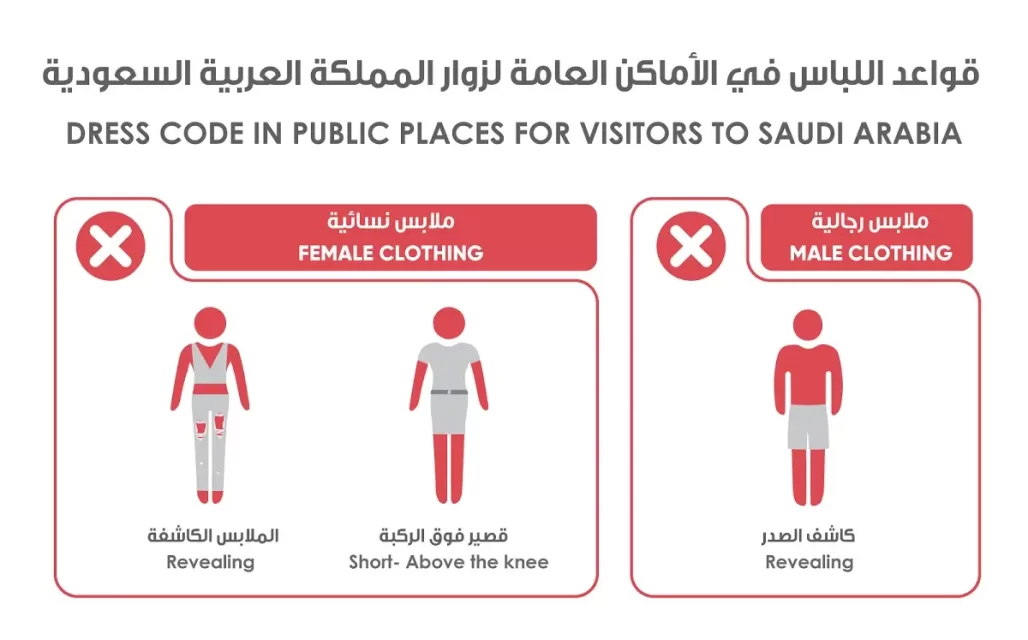
WHAT IS ALLOWED?
♦ Any kind of footwear – the Saudi Arabia dress code does not extend to feet! Don’t wear footwear in mosques though.
♦ Make-up – women often wear a lot of (really beautiful) make-up, especially arounds the eyes in Saudi Arabia. This is accepted, although I’d probably stay away from bright red lipstick and super bright colours.
♦ Patterns and coloured clothes – although traditionally women wear black, colours, decorations and patterns are becoming more popular, especially with younger women. Whether you wear an abaya or not, you do not need to wear black.
♦ Children’s clothing – not s ubject to a dress code, young children can dress however they want. Until early teenage years, girls can wear any kind of clothing. Customarily they start wearing an abaya, then a hijab follows. Some families start clothing children earlier in traditional dress.
The Saudi Commission for the Promotion of Virtue and Prevention of Vice (CPVPV), otherwise known as the Islamic morality or religious police, was established in Saudi Arabia in 1940. This organisation, still functioning today, was, in theory, to act as a spiritual guide for society and to enforce the moral code of Islam. The members were known as mutawa/mutaween (one who compels obedience). In 1976, the CPVPV developed into the controversial form of religious police known today, gaining increased power in government and a widening scope to include smaller towns across the country.
Their main duties were to police Islamic norms and immoral behaviour, by imposing the dress code for women in Saudi Arabia, enforcing prayer times and dividing gender-mixed socialising. These rules, in general, were implemented far more harshly on the women of Saudi Arabia.
Between 1960 and 1980, Saudi Arabia gradually saw the rise of the Sawha (awakening) movement, also named the Islamic Awakening movement. This pushed a ridged, puritanical form of Sunni Islam called Wahhabism. By 1979, after the Grand Mosque Seizure in Makkah, the CPVPV powers were almost unchecked. This led to the burning of books, the destruction of musical instruments, corporal punishment, attacks on beauty shops and more. Much of this was directed significantly more towards punishing women than men.
In more liberal circles, the CPVPV were viewed very unfavourably, but generally not fought. Criticism was rare, until a fire in a Makkah girls’ school in March 2002, where 15 schoolgirls died. This was allegedly due to the mutaweens preventing the students from leaving the building for not wearing proper attire.
Over the decade that followed, the powers of the CPVPV were gradually diminished, until 2016, when Crown Prince Mohammed bin Salman effectively removed their role in modern Saudi Society.
In the present day, the CPVPV still exists but does not have police-like powers, is unable to dish out penalties and can only report infractions to law-enforcement. Punishments for violations have been reduced, with fines replacing punishments like flogging.
What is the traditional Saudi Arabia Dress Code for Women?
Although there is no legal Saudi Arabia dress code for women, most still follow the previous expectations and wear an abaya and head scarf, a niqab or, rarely, a full burka. It is unusual to see a woman’s face or hair outside of the home in Saudi Arabia.
For reference:
♦ An abaya is a kind of loose, full-body robe, covering the arms, all the way down to the feet. The abaya can be open at the front, buttoned or zipped up, or a full over-the-head dress. It covers all but the head, feet and hands. They come in all colours and can also be very decorative, but darker colours and black are the most common in Saudi Arabia.
♦ A hijab can refer to modest dress in general, or specifically a type of headscarf, normally square in shape that covers the head and neck.
♦ A niqab is a face covering that leaves a gap for the eyes. This was a very common item of clothing for women when I visited Saudi Arabia.
♦ A burka is a full face and body covering, usually including the eyes, sometimes with a mesh to see through.
In Saudi Arabia, the vast majority of women wore a black abaya with a black niqab. Some women wore a hijab and an abaya, and few adorned any colour but black. I didn’t see any women in western clothing. Much of the time, the women I saw wearing a hijab instead of a niqab were in modern malls in places like Riyadh and Jeddah.
This is not the case for young children, who would wear clothes typical of children in the West.

SAUDI ARABIA DRESS CODE REFORM
The long-term effect of the infamous Grand Mosque Seizure at Masjid al-Haram in Makkah in 1979 was the strengthening of Islamic conservatism, resulting in the implementation of compulsory abayas for all women, residents and visitors alike. By the late 1980s, women were even banned from using swimming pools.
During the 1980s and 90s, the religious police became more extreme, harshly enforcing attendance at prayer, gender segregation and the Saudi Arabia dress code, especially for women.
In 2015, when King Salman was throned, he decided that the black abaya was no longer mandatory; any colour and pattern was allowed.
Between 2017 and 2019, significant societal reform was enacted. This benefitted women who were previously unable to drive, attend sporting and entertainment events with men present, or gain a passport without male permission. In 2018, Crown Prince Mohammed bin Salman explicitly said that women did not need to wear an abaya or hijab in public in order to follow Islam. This permitted many women to choose what outer clothing they wore for the first time.
SAUDI WOMEN’S FOLKLORE ARTFORM | BEAUTIFUL PLACES IN SAUDI ARABIA
What I wore in Saudi Arabia as a Woman
I did not wear an abaya, niqab or hijab while in Saudi Arabia, although I considered it.
It was a tricky thing to decide since I wanted to fit in and not be gawked at, but I also did not want to purchase an item of clothing I wouldn’t wear anywhere else. Plus, I’m an excessively warm person who doesn’t want to wear a long black dress in warm weather!
I chose to wear thick, black (very non-see-through) leggings, a flowy skirt that reached below the knee, a plain, loose black t-shirt that wasn’t low cut and a thin hoodie type jacket that covered my arms. For an entire month, I wore this exact outfit! I also carried a black scarf, often worn around my neck. Occasionally, I wore this scarf over my head in areas I felt to be a little more conservative.
When I arrived in Saudi Arabia I wore a headscarf until I felt comfortable enough to take it off, which was about a day into our trip.
Personally, I did feel stared at, but it was because I wore western clothing and I’m (very) white, not because my clothing was a concern to anyone. I felt like a curiosity, rather than an offence. Residents appeared to enjoy noticing us and would shout, wave and greet us kindly (sometimes from cars in precarious positions!). When I spoke to Saudi Arabian people (occasionally in depth) about clothing, it was suggested that I was dressed adequately for a female tourist in Saudi Arabia.
It’s interesting because although I wore western clothing for the entirety of my trip and was worried about seeming out of place, there were so many western clothing brands (like H&M) selling western outfits in the malls.
SAUDI ARABIA DRESS CODE FOR MEN
Just as conservative expectations are placed on women, similar, but less strict ones are also in place for men. Simply put: do not wear shorts, tight t-shirts, or sleeveless shirts.
Traditionally, in Saudi Arabia, men dress in a thobe (like a long smart, white shirt), or for more formal occasions, a ghutra (the traditional head cloth) or occasionally a kufi (a type of hat).
Nick wore reasonably loose, dark-coloured hiking trousers, a plain coloured t-shirt and a jumper for every day of our trip and didn’t feel he was being stared at (anymore than I did anyway!).
A COMPLETE SAUDI ITINERARY | HEGRA VS. PETRA
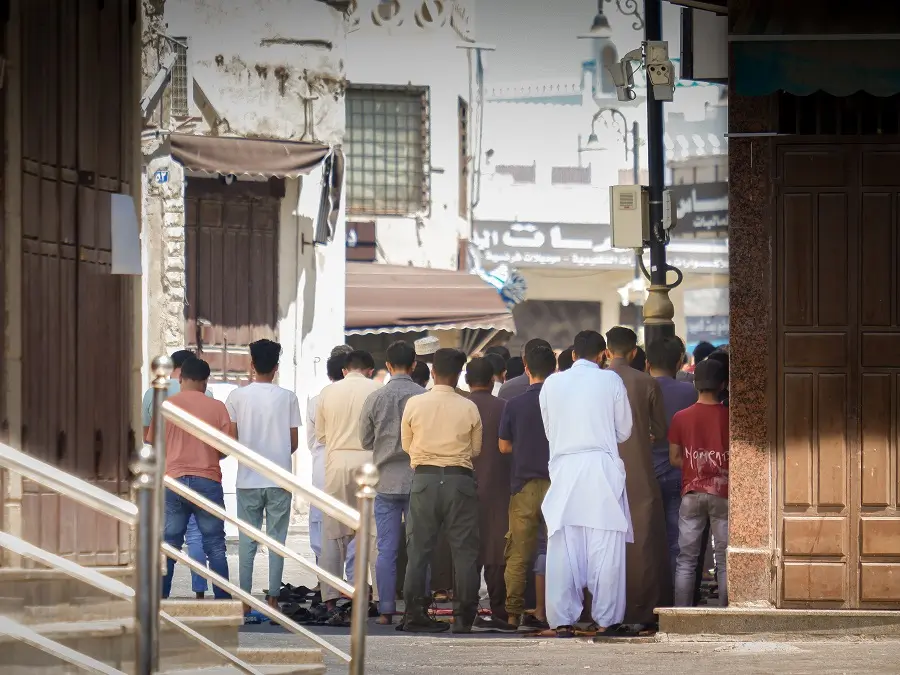
WHAT TO WEAR IN MOSQUES AND AROUND MADINAH
There are specific rules when entering mosques anywhere in Saudi Arabia (and across the world) and visiting the holy city of Madinah.
For women visiting mosques in Saudi Arabia, always wear a headscarf and ensure your clothing is fulling covering your entire body. Better yet, wear an abaya.
Although you can technically walk around the holy city of Madinah dressed however you like, out of respect, at minimum cover your head with a headscarf as a woman. The best option, as a female tourist, would be a headscarf and abaya. If you visit anywhere in the vicinity of Al Masjid an Nabawi, you should definitely heed this advice.
I’m sure others will contest this opinion, but I wouldn’t feel comfortable visiting one of the most holy sites in Islam, as a non-Muslim, not dressed in a way that was respectful for worshippers there.
Also, remove your shoes before entering any mosque.
WHAT IS HAYA?
In Islam, Haya corresponds to ‘healthy shame’ or ‘sense of modesty’. It’s more than just a visual thing or a dress code and relates to all the feelings that could deter a person from behaving indecently. In the Qur’an and hadith passages, the values of Haya require that women cover themselves but is also used as a term for shyness and bashfulness.
Haya applies to both men and women, encouraging respectful behaviour and modest dress.
So, although you can wear what you want in Saudi Arabia now (within respectable reason), there is also the idea that you should present yourself well. It is more likely that you will be stared at negatively for being scruffy, unclean and unkempt than for wearing western clothing.
RELATED POST | RIJAL ALMAA – SAUDI ARABIA’S GINGERBREAD VILLAGE
Truthfully, I didn’t feel uncomfortable at all. Both Nick and I felt we got stared at a bit, but it’s because we looked different, not because we were in some sense offensive.
The only place I felt that people were unpleasant to me, as a woman, was in Al-Balad, the old town area of Jeddah. There was definitely an odd vibe there which I didn’t enjoy (around midday on a Friday, a holy day), where it was only men and I felt very unwelcome. However, I know other tourists have not experienced this and I really rate the area as a beautiful site in Saudi Arabia , so would still encourage any female traveller to visit. I didn’t feel unsafe, just uncomfortable.
Having spent several months in conservative Oman (far from the modern areas of Muscat) and many, many weeks in the Maldives local islands , Tunisia , the U.A.E. and Jordan , we were used to being stared at a bit for being different. It is not offensive and people were always welcoming and inquisitive. The same goes for Saudi Arabia too.

If this Saudi Arabia dress code post has been helpful to you, and you are thinking of renting a vehicle for your trip, consider booking a rental car through our favourite company, Discover Cars . We love this company because they actually pay out on insurance policies (we can confirm this first hand!).
Booking through our links helps fund this blog at zero cost to yourself. Thank you!
FINAL THOUGHTS - SAUDI ARABIA DRESS CODE
To wear or not wear an abaya – it’s potentially contentious, I know.
I was ready to buy one if it felt necessary (shops are everywhere), but I never did during my month in Saudi Arabia. It was a topic I was focussed on before arriving in Saudi Arabia – this meant I was highly sensitive to how I was treated and perceived.
The judgement to dress as residents do is individual – after all, an abaya and headscarf are not technically religious garments, but cultural ones. It has been argued that they are to Saudi Arabia as a kimono is to Japan. I’m not saying that I necessarily agree completely with that analogy, but it’s certainly not the actual item of clothing that is religious – more the purpose of the item.
Another consideration is that if you are a non-Muslim visitor, this is often quite apparent. An unrelated, friendly conversation with a man in a Riyadh supermarket during Ramadan gave me some perspective. He said that he didn’t care if we ‘ate a burger’ in front of him because Ramadan is his holy holiday, not ours, and it ‘didn’t bother him in the slightest’ what we did. Similarly, as long as you dress modestly, most people are not likely to care if you do not wear an abaya as a non-Muslim.
The last comment I have is that it is illegal to take photos of people in Saudi Arabia. So, unlike my usual photography, you won’t see many street scenes, portraits or examples of clothing in this article! Also, I’ve found that generally, it is not a good idea to take photos of women in Muslim countries, many will refuse if you ask – so always ensure you get permission.
I hope this post of my thoughts on the Saudi Arabia dress code for women is helpful for you and clarifies the history and culture around it a little bit.
Let me know if there is anything I didn’t answer. Have a great day!
Hi, thanks for visiting our blog! If this post has been of help to you, or you’ve just enjoyed our random ramblings and musings, say thank you by buying us a coffee ! It helps keep The Restless Beans blog up and running without ads.
Thank you, Claire + Nick

7 thoughts on “The Saudi Arabia Dress Code for Women in 2023”
Yeah it was good reading, but still I’m worried as I need to go to Riyadh for work as a teacher. So would like to have some idea from you about the same. Do non Muslims who work there wear sarees. I’m really tensed to move on. Please suggest. I have packed some Indian wear Churidars is it ok. How about colour. I love black but wearing black every day ?? If possible please guide.
Hi Julie, have your employers given you any idea about dress expectations? Non-Muslims, from my experience, do not always wear traditional dress, however some do (I know some expats who do for ease). I’m sure that conservative Western dress would be fine if your employers and hosts are okay with it. I’d definitely check with them!
Black is definitely favoured by Saudi women from my experience, so that might help you blend in. I didn’t wear black every day though. If you are covered up appropriately, it is likely to be okay.
If you work in education, you’ll be in a walled-in, all female area. You can wear what you want there as long as it’s modest. I taught in Saudi for years. Riyadh is very modern for Saudi and abayas can be very colourful and use patterns. But you only wear them in areas with mixed gender. And if you are only going out to a mixed gender areas (going to the mall or a restaurant), you can wear anything underneath, modest or not. I wore skimpy pajamas under mine in the summer heat. No one could tell!
Hello, Thank you, this reading was very useful. I was wondering, Should it be better to cover my head (not my face) if I participate in a Zoom meeting with a Saudi Arabian company as a sign of respect? Thanks! All the best, Paula
I think in some cases I would, out of respect, but it would depend on the company and who you are talking to. I imagine if you were dealing with a progressive company that employs or communicates with people all over the world, they’d expect you to dress however you’d normally dress!
Lots of people travel to Saudi Arabia every day and do not cover their hair. I didn’t for the majority of my trip and nobody minded.
So, I think it’s potentially a nice thing to do, but not necessary nor expected 🙂
Would a v-neck t-shirt be unacceptable? I mainly wear summer dresses when I travel, but I do have a couple that are v cut. I am also going for a formula 1 race, would leggings be acceptable?
I think that as a visitor to the major cities, a V-neck would be okay if it isn’t low-cut. I wear a crop top thing under any t-shirt that is a little risky! I wear leggings in Saudi Arabia, but chuck a skirt or something over the top. For the Formula 1 race you’ll be fine – I assume that’s in Jeddah (I was there for it last year!). Jeddah is one of the most progressive cities in Saudi Arabia, I’m sure they’re expecting Westerners to turn up for the race wearing Western clothing. Just follow the rule to not show too much skin.
Have a fantastic time!
Leave a Comment Cancel Reply
Your email address will not be published. Required fields are marked *
Save my name, email, and website in this browser for the next time I comment.

11 Beautiful Places in Saudi Arabia

Rijal Almaa – Discovering Saudi Arabia’s Gingerbread Village

Hegra vs. Petra – Is Saudi Arabia’s Hidden City Worth It?
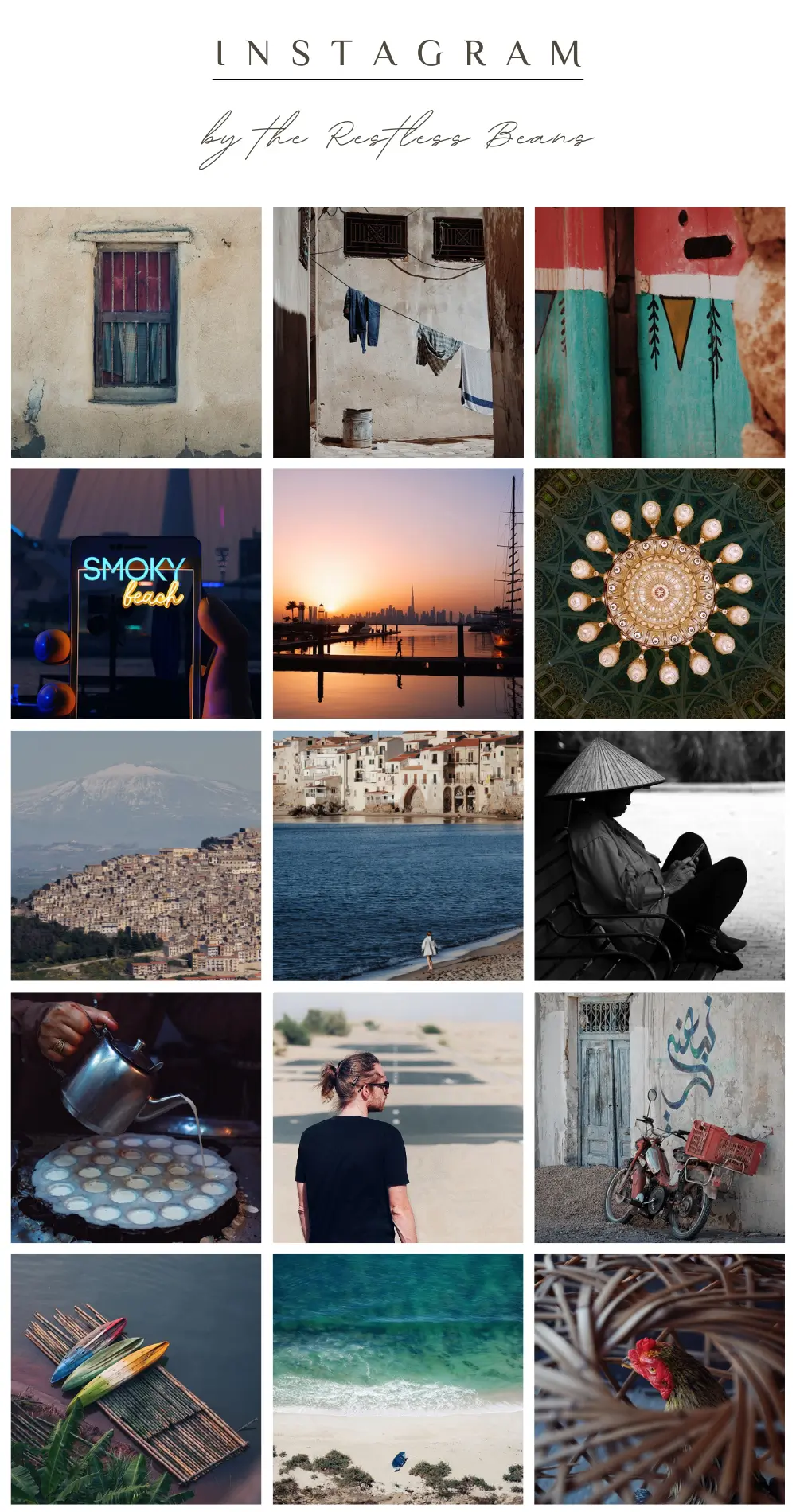
Privacy Policy

SUBSCRIBE FOR A MONTHLY UPDATE.
NEW POSTS + ROUND-UP + TRAVEL NEWS
Planning a Trip?
BARGAIN FLIGHTS
CHEAP CAR HIRE
DESTINATIONS
INTERNATIONAL LUGGAGE STORAGE
S.E. ASIA TRAVEL
CASHBACK ON HOTELS
PACKING LIGHT
ETHICAL TRAVEL
If you book through the links above, we make a small profit, at zero cost to you, which helps us write these posts with no advertising! We only endorse products and companies we *actually* use regularly. For more information, read our position on affiliates .
Copyright © 2024 The Restless Beans
Welcome to The Restless Beans!
Sorry for the annoying pop-up. Just click on out if it’s not for you.
Sign up for a monthly round up of new posts, travel updates, guides, tips and quirky travel news – never any junk or spam. We hate that stuff.
– Upcoming content from: Morocco, Oman, Sri Lanka & Saudi Arabia –
Thanks, Claire + Nick

DUBAI TRAVEL GUIDE
SHOP THE MAGAZINE
Life+Style , Saudi Arabia
What to wear in saudi arabia: a guide to dressing in the kingdom in 2024.
The complete handy guide to what you can, and can’t wear, when travelling to the Kingdom of Saudi Arabia
19 May 2024
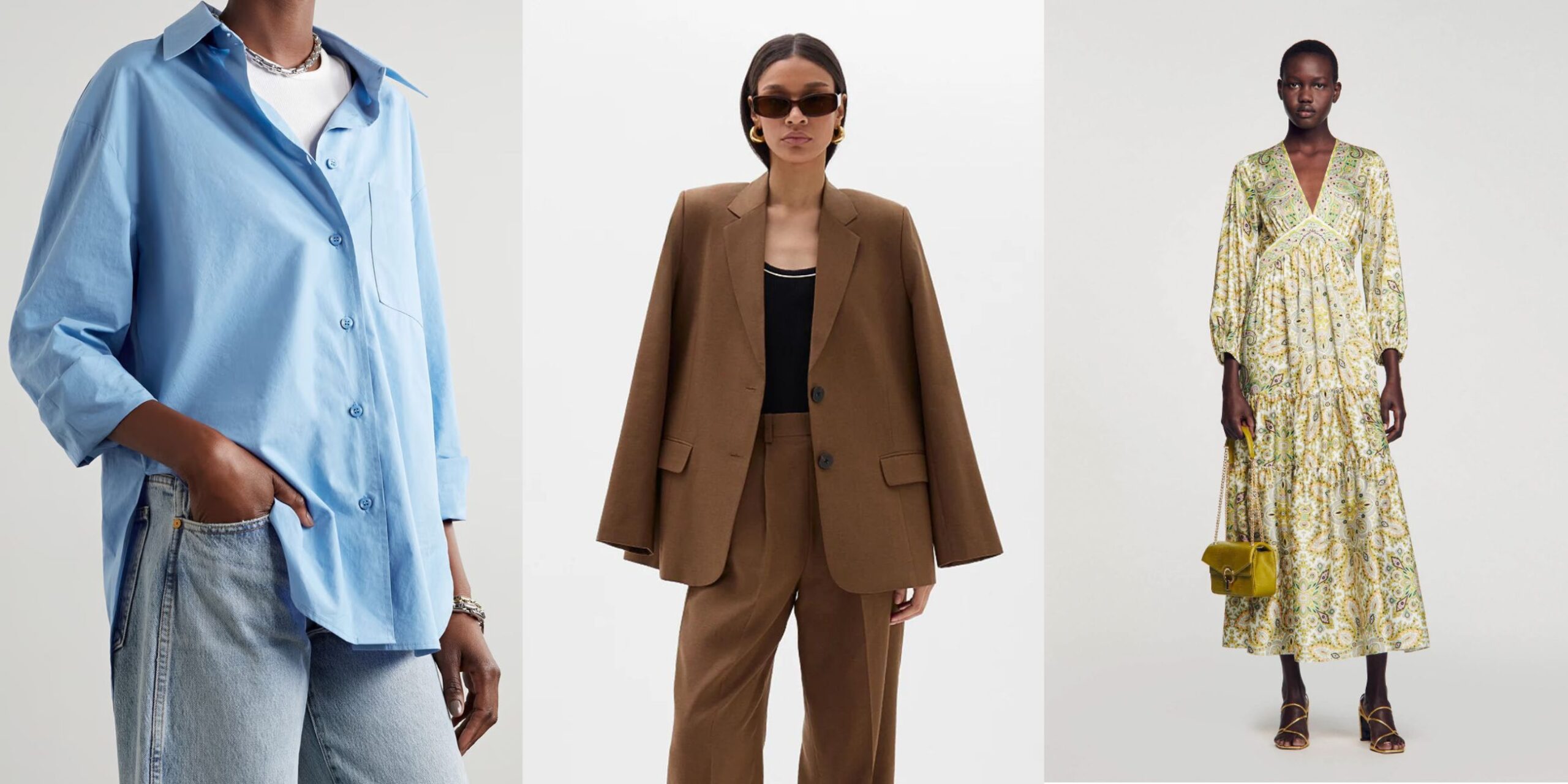
Latest reads
Sheikha mahra's favourite holiday destinations, the 2024 middle east hotel openings we’re excited for, the 8 best emirates skywards credit cards for 2024, the coolest cafés and coffee shops in dubai , the discerning traveller's guide to visiting dubai.
Never has there been a more exciting, or free, time to visit Saudi Arabia . Since launching its tourism e-visa in 2019, the Kingdom has opened its doors to the world to discover and enjoy its ancient heritage sites and thriving modern cities , not to mention its glorious Red Sea and Arabian Gulf coastline with its ample diving sites. But while the abaya and head coverings haven’t been mandatory for female travellers since 2019, packing for a holiday to Saudi Arabia can still be a little daunting. But it shouldn’t have to be. Luckily, the Kingdom’s new dress code is easy to follow, encouraging travellers to opt for loose, flowy clothes that cover the shoulders and knees but without the pressure of too much covering up. In resorts, however, feel free to take a little more liberty – and both swimsuits and shorts are welcome. Here’s what to wear in Saudi Arabia for women in 2024.
What to wear in Saudi Arabia
A loose cotton shirt.

Lui organic cotton-poplin shirt, The Frankie Shop, AED750 net-a-porter.com
A loose linen or cotton shirt, or a handful in different styles, colours and fabrics, are wardrobe staples when travelling to Saudi Arabia. They can be thrown over leggings, wide-leg trousers or a midi skirt for a day or exploring, or dressed up with some wide-leg trousers or a floaty maxi skirt and heels for the evening. Make sure your loose collared shirt is breathable to cope with the country’s hot and often very humid weather.
A flowy maxi dress
Scarf print maxi dress, Sandro, AED1,590, sandro.ae
Stand out against the sandstone and desert in a vibrant floaty maxi dress – a must-pack for anyone visiting Saudi Arabia. When packing your maxi dresses, go for ones with sleeves (no straps) that are generally on the looser, more floaty side. That said, things are becoming more leniant, and shorter sleeves and even lower necklines are all acceptable in 2024.

Maverick jumpsuit in linen, Mossman, AED555, ounass.ae
A jumpsuit is a perfect outfit choice for an evening out in Riyadh or Jeddah in one of its new and flashy restaurants – think LMP, Billionaire or Hakkasan. Dress up the jumpsuit with a pair of heels and remember not to go for anything too tight fitted or showing too much chest or your shoulders.
Flared front-split leggings, The Giving Movement, AED299 thegivingmovement.com
Forgo athletic shorts in favour of below-the-knee leggings for your trip to Saudi Arabia – the perfect thing to wear when exploring the cities, hiking or getting out and the country’s range of heritage sights. Leggings are completely acceptable to wear despite being tight – just pair them with a looser-fitting t-shirt or shirt that falls beneath the lower back.

Matisse Placée in Silk Twill (blouse and trousers), La DoubleJ, ladoublej.com
A loose-fitting co-ord is a must for looking glam and adhering to Saudi Arabia’s dress codes. Go for something minimalist in black or white for a sleek daytime look, and dress it up with colours and patterns for the evening. Bottoms can be tighter as long as the top is loose and untucked, or go for loose-fitting bottoms and tuck the top in.
Le Palazzo high-rise wide-legs jeans , Frame, AED1,238, net-a-porter.com
Jeans are a must-pack for any visit to Saudi Arabia. They’re warming, perfect for the cooler winters, particularly in the desert regions and can be dressed up or dressed down. When wearing skinny jeans opt for a top that covers your hips and bum or opt for a tucked-in t-shirt if wearing mum or a loose-fitting pair.

A swimsuit and beach gear

Antii One-piece Swimsuit, Andrea Iyamah, AED950, ounass.ae
Travellers to Saudi Arabia will find there are many rules and etiquettes for dressing – but the most reassuring is that travellers can largely wear what they want within the confines of their resort. When staying in AlUla’s luxurious desert resorts home to outdoor, mixed gender swimming pools, bikinis, swimsuits, shorts, strappy. Saudi even hosted its first-ever swimsuit fashion show this May at the Red Sea Fashion Week.
Any shoes you fancy
Melanie platform sandals, Loeffler Randall, AED1,820, levelshoes.com
Wood canvas and leather slides, Chloe, AED1,439, matchesfashion.com
There are no customs or dress codes when it comes to footwear in the Kingdom. Reveal or hide as much of them as you like – open-toe sandals, thong-strap flip-flops, sky-high stilettos, trainers, boots, anything goes.

Statements accessories

Botanique Earrings, Shashi, AED260, revolve.com
Mini Cydonia Leather Tote Bag, Medea, AED2,240, fabricofsociety.luxury
Expressing yourself with statement jewellery and accessories is a great idea for those feeling a little confined by the dress code. Dress up an outfit with eye-catching earrings or opt for a bright attention-grabbing handbag or tote – perfect for filling up to explore the city.
An abaya or kaftan
Beckett Satin Crepe Cape Dress, Alex Perry, AED8,300, bloomingdales.ae
Abayas are not mandatory at all, but some travellers will feel more comfortable packing one with them for days when they’re not sure on what to wear. They’re also incredibly chic and flattering, making deciding what to wear in Saudi Arabia much easier. There are hundreds of abaya shops in Saudi Arabia to browse through, at all price points, or you can purchase one beforehand in stores around the Gulf or online. Try brands like Aks, Nafs Designs, Anatomi, The Cape and Bleach for a modern and stylish take on the traditional garment.

Saudi Arabia travel guide
Thinking of booking a trip to the Kingdom? Saudi Arabia has much to explore. Its cities like Riyadh and Jeddah are teeming with cool coffee shops , restaurants , shops and hotels , while its hinterlands hide some of the world’s greatest wonders. The ancient desert city of AlUla is unmissable, the home of the Nebetean kingdom with ancient ruins, art galleries, cafes and luxury resorts , and its giga-projects like the Red Sea and NEOM’s Sindalah are starting to open. Discover Saudi Arabia using our dedicated Saudi Arabia travel guide here.
Sign up for the latest travel news, reviews, inspiration and so much more from the Middle East and beyond straight to your inbox.

News + Tips
Ultra-luxury Aman Group announces Janu Dubai
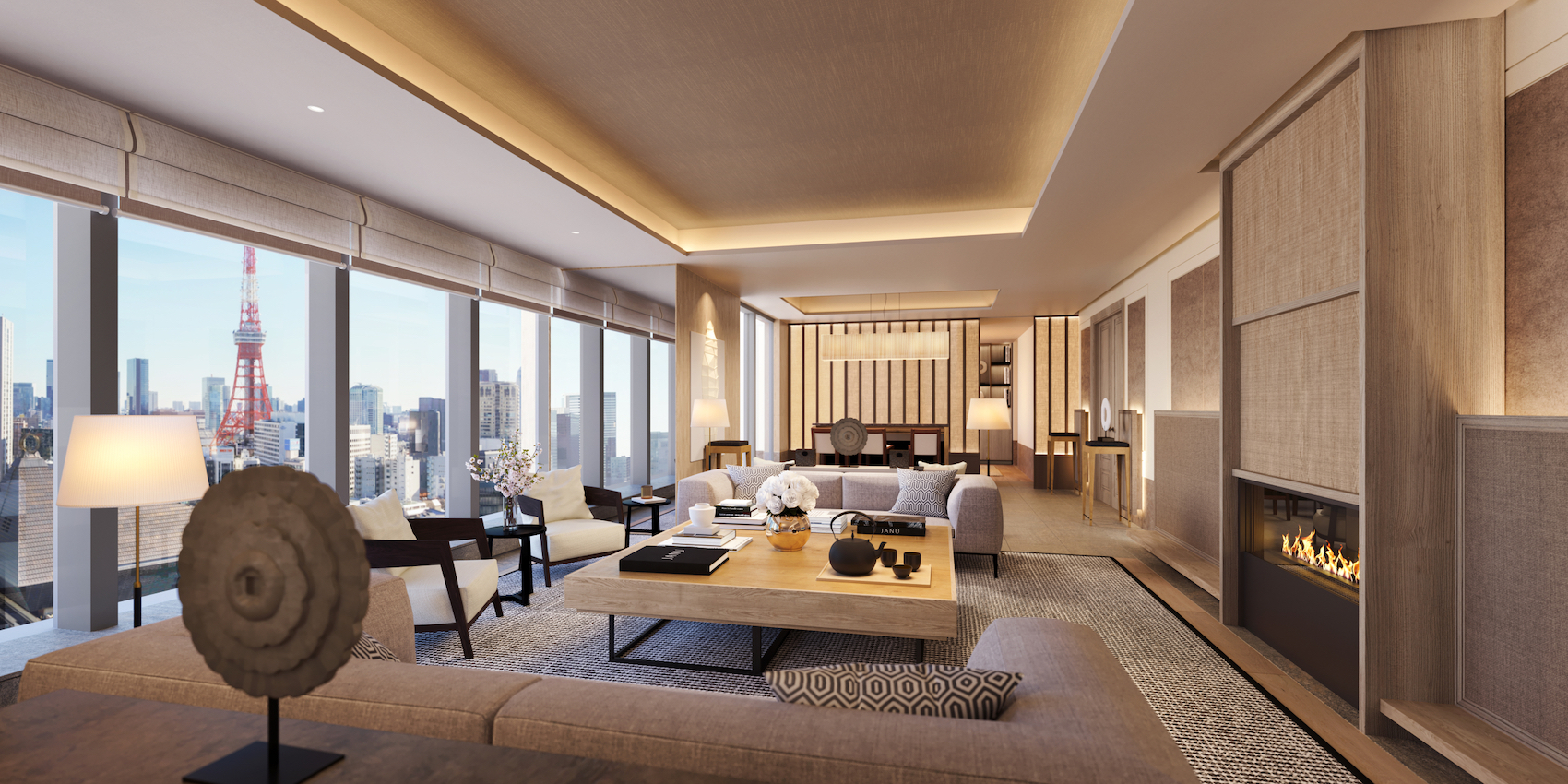
Where To Stay
What is Janu? Aman’s new soulful lifestyle brand focused on vibrant social spaces
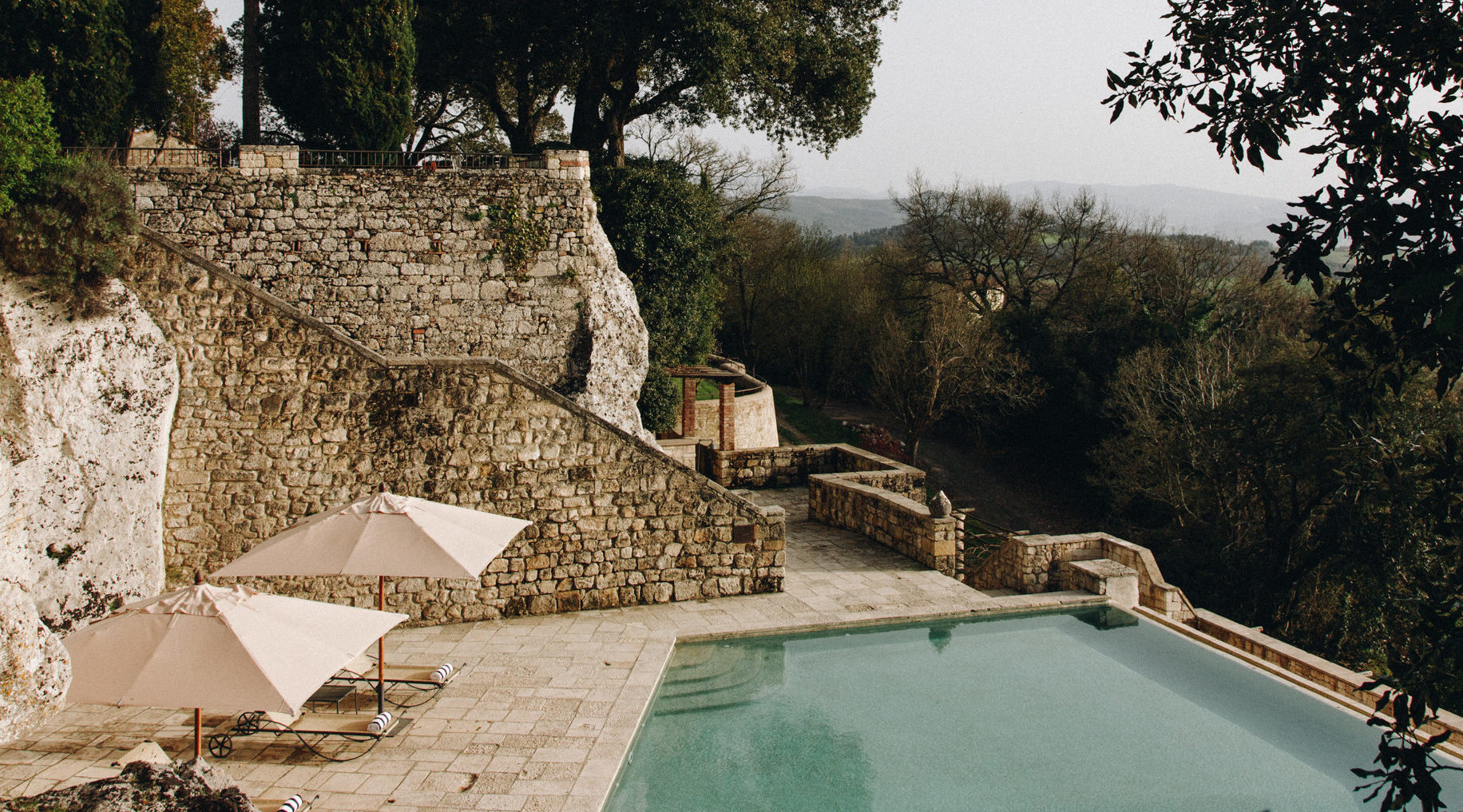
Italian agriturismos: The most chic and affordable farmstays in Italy this summer
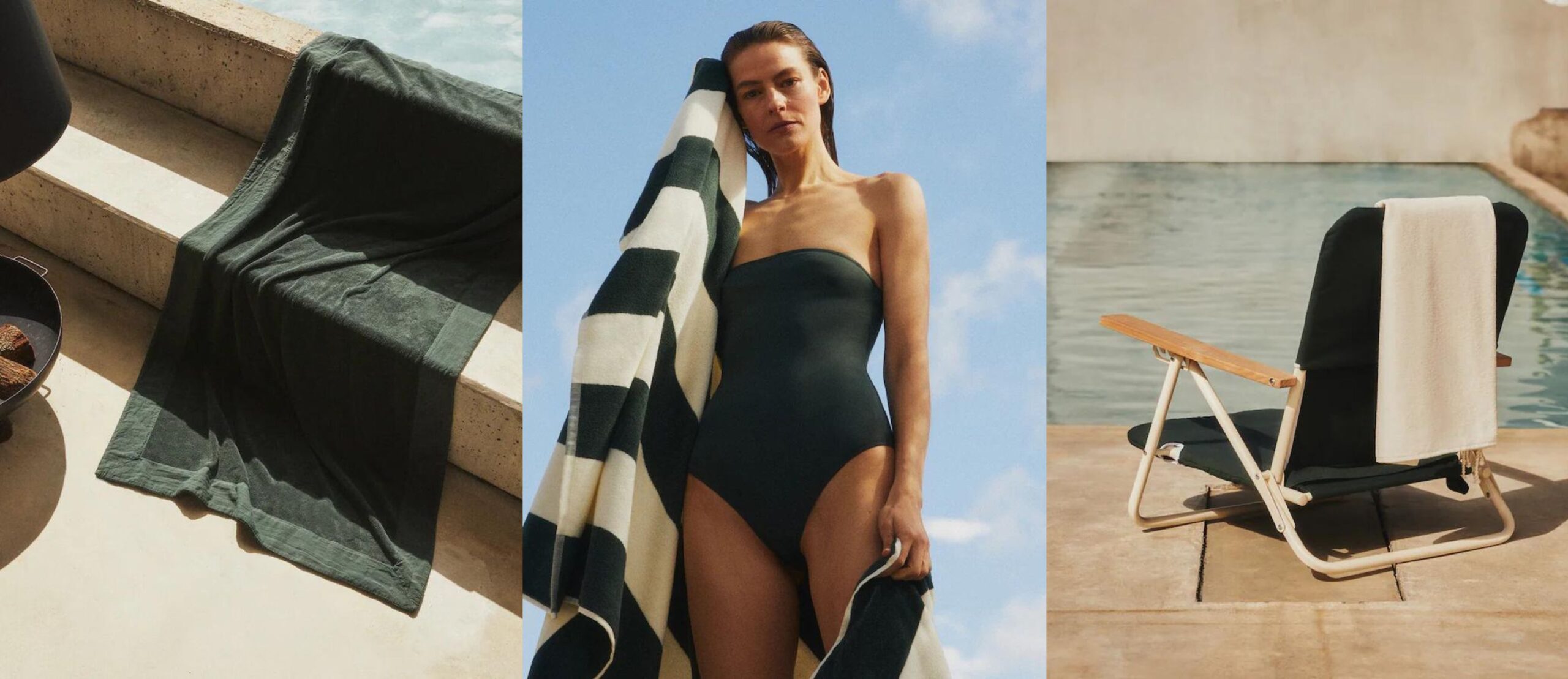
19 chic beach chairs and towels to snap up now
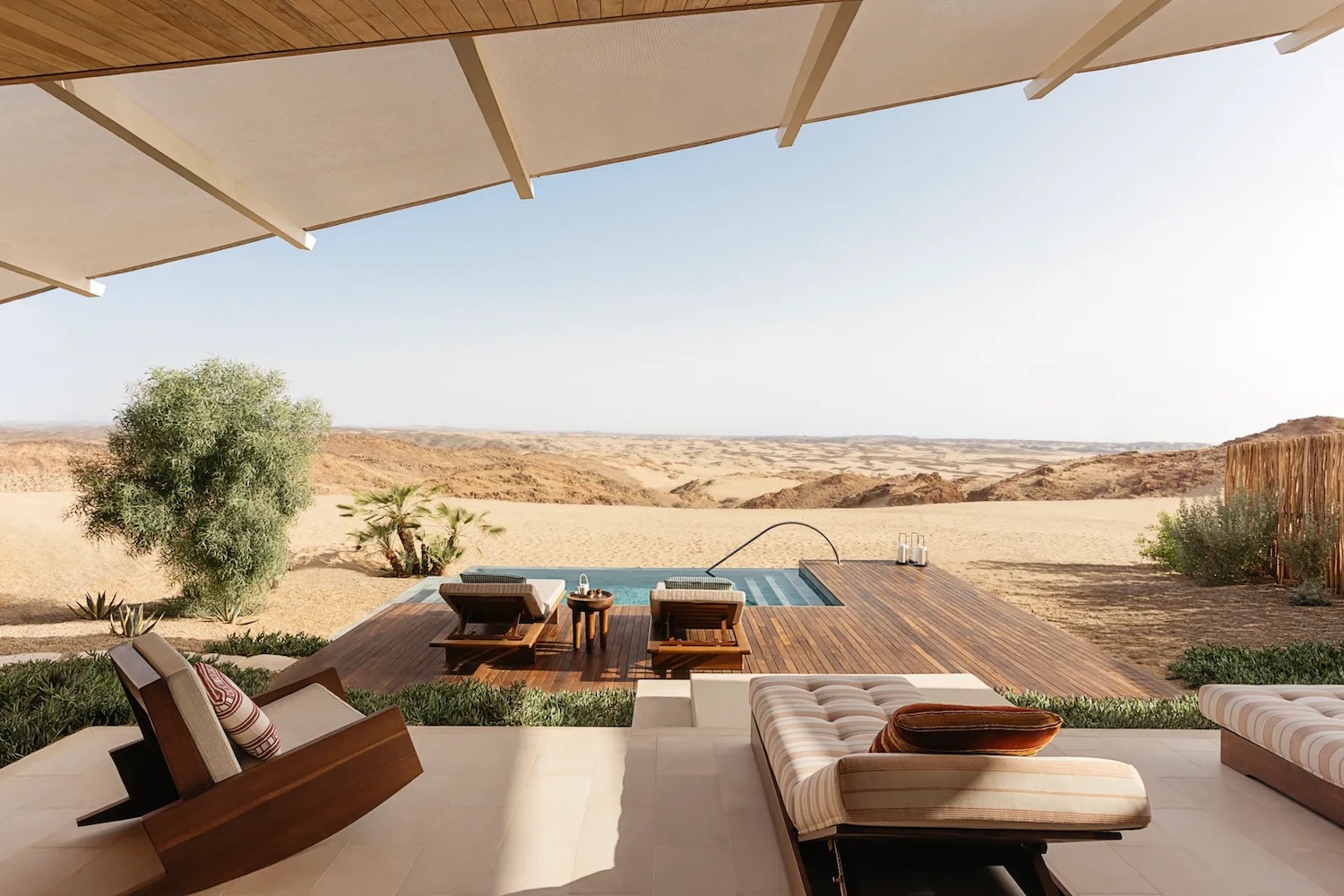
Inspiration
Short-haul flights from Dubai: 7 interesting destinations less than 4 hours away
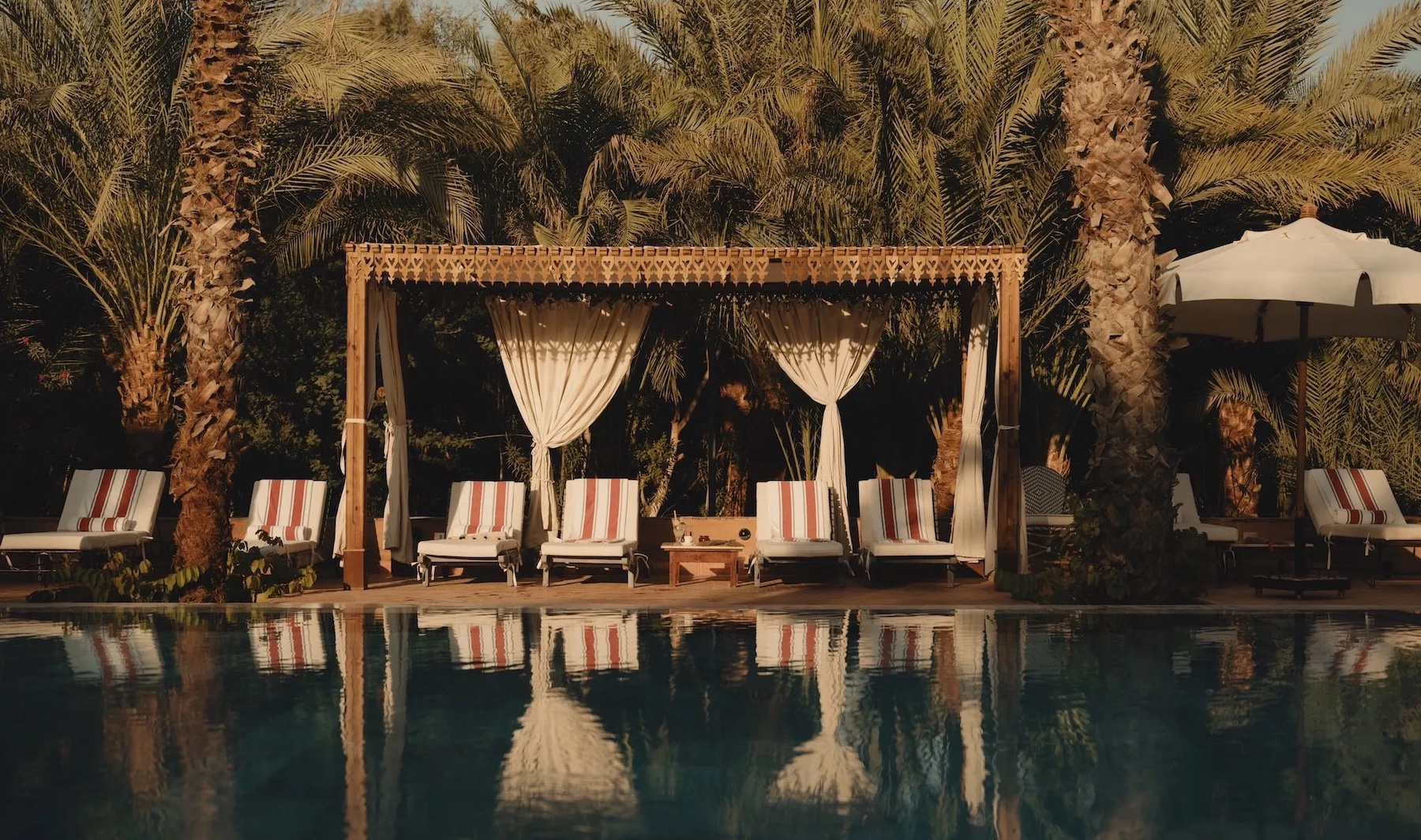
Middle East
The Luxor hotel reinstating Egypt’s bygone glamour and golden-age appeal
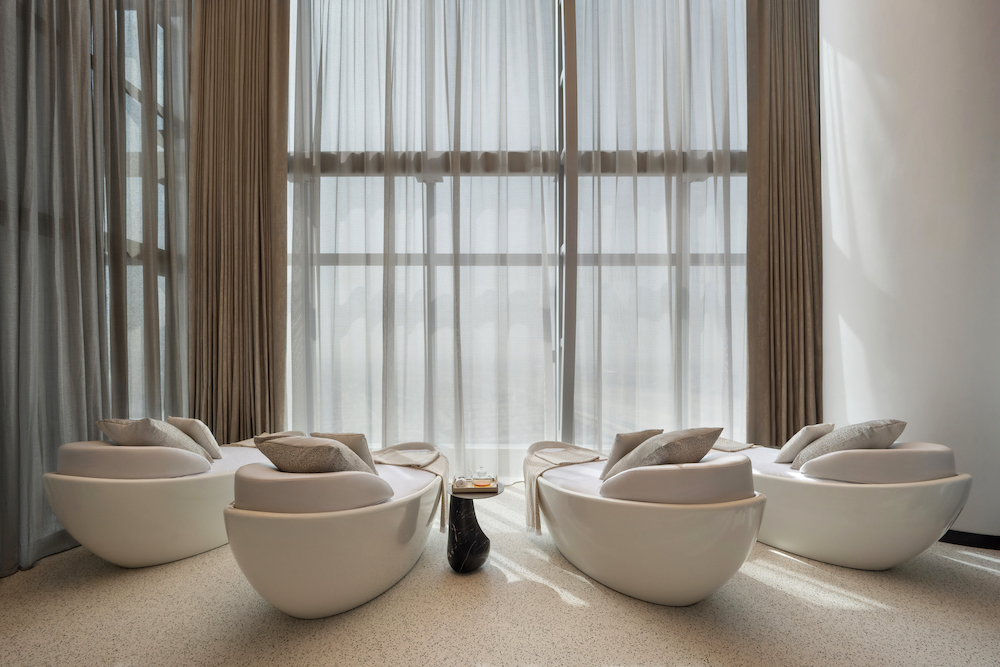
9 unmissable spa day deals in Dubai to enjoy right now
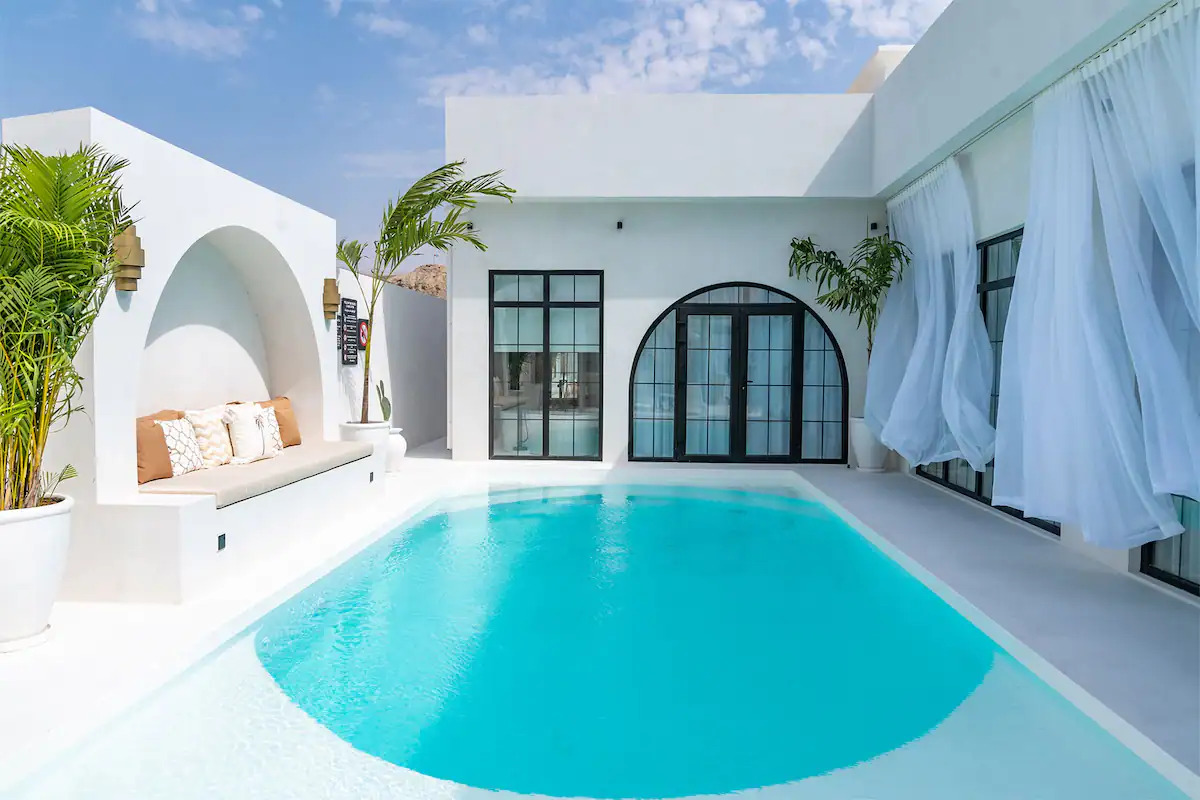
7 Unique Airbnbs In The UAE To Book For Eid 2024
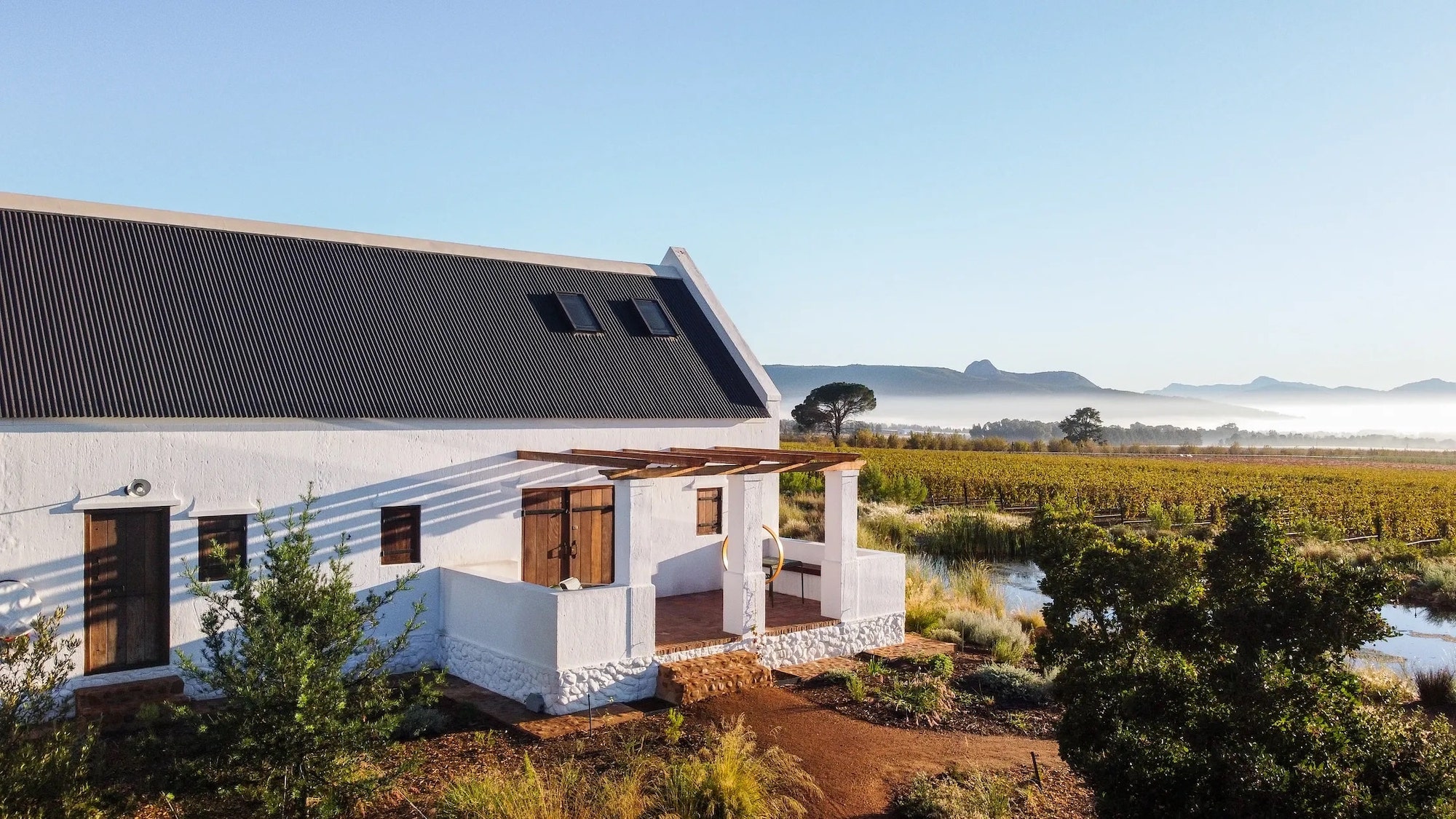
Hotel Reviews
Babylonstoren review: South Africa’s slice of heaven on earth
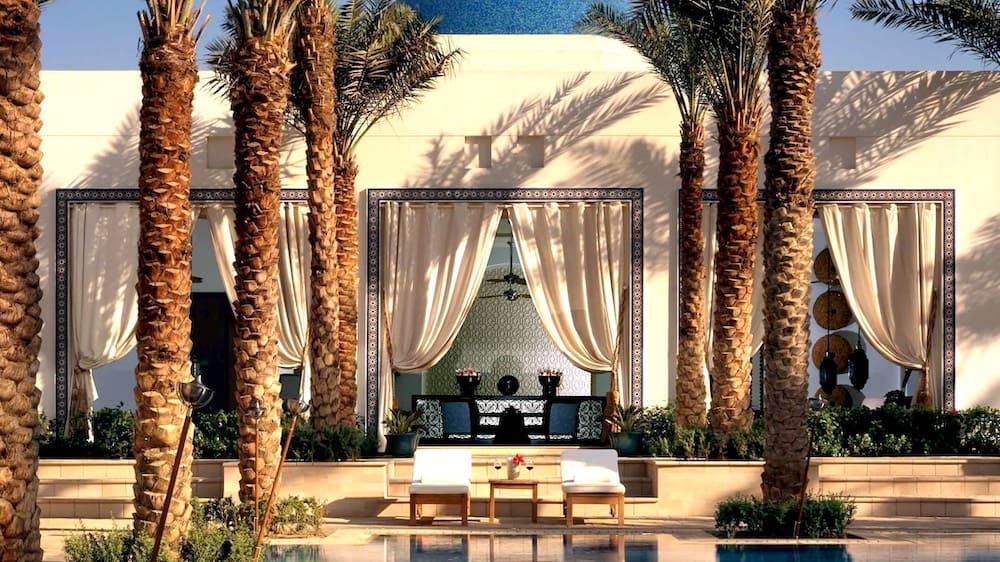
The 21 very best hotels in Dubai for 2024
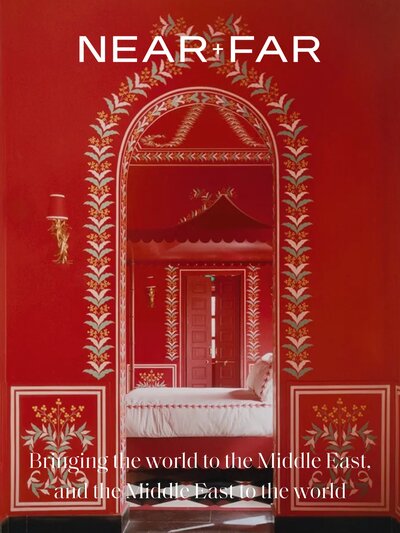
For the latest, relevant, news for the luxury-loving independent travellers, where to go now, unmissable travel offers, travel tips and what to do, buy and see, direct to your inbox...

@nearandfarmag
LIFE + STYLE
WHERE TO STAY
NEWS + TIPS
DESTINATIONS
INSPIRATION
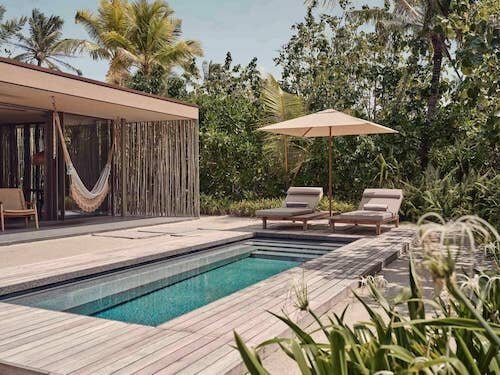
THE MAGAZINE
DUBAI GUIDE

Your Guide to Saudi Arabia Dress Code for Female Tourists 2024 Update
- Post author: Abdul Qadir
- Post published: January 1, 2024
- Post category: Informations
- Post comments: 1 Comment
Saudi Arabia, a land of rich history, colorful culture, and amazing landscapes, attracts travelers with its unique appeal. While planning your trip, understanding the dress code, particularly for female tourists, is important for a culturally respectful and comfortable experience.
Table of Contents
No more mandatory abayas: embracing new rules.
There was a time when an abaya (traditional black robe) was mandatory for all women in public. Following recent changes, female tourists are no longer legally obligated to wear the abaya or cover their hair . This empowers visitors to dress more freely, reflecting their own cultural standards and preferences.
Respecting Cultural Rights: Modesty Matters
However, modesty remains a central principle in Saudi Arabian society. While mandatory dress codes have been relaxed, showing respect for local sensibilities is highly recommended . This ensures a smooth and peaceful interaction with the community.
Here’s what “modest” translates to in practical terms:
- Covering Shoulders and Knees: Opt for clothing that covers your shoulders and keeps your knees covered. Long pants, flowy maxi dresses, skirts reaching mid-calf, and shirts with sleeves are ideal choices.
- Loose and Opaque Fabrics: Avoid overly tight or revealing clothing. Choose breathable, opaque fabrics that don’t show through, promoting comfort and cultural awareness.
- Sensible Cleavage Coverage: Plunging necklines and revealing tops are best avoided. Opt for modest necklines or layer with scarves for added coverage.
- Undergarments Matter: Underwear should be private and hidden under your clothing. Visible undergarment lines can be considered unfit.
Navigating Different Situations:
While the overall dress code has become more flexible, certain situations require a slightly more formal approach:
- Religious Sites: When visiting mosques or holy sites, wearing an abaya and headscarf is highly recommended as a sign of respect. Many mosques offer abayas for visitors to borrow.
- Conservative Regions: Some towns and villages hold onto more strict traditions. Wearing an abaya, even if it is not mandatory, is advisable for a more comfortable and respectful experience.
- Formal Occasions: If attending official meetings or formal events, a more dressed-up and modest approach is appropriate. Consider elegant long dresses, tailored pantsuits, or skirts paired with elegant blouses.
Embrace the Variety:
Remember, Saudi Arabia is a diverse country. Cultural standards and dress preferences can vary slightly between regions and cities. Watching how local women dress in your specific destination can offer valuable insights for adjusting your fashion choices accordingly.
Beyond the Clothes:
While dressing appropriately is important, true cultural respect goes beyond outward attire. Being mindful of local customs, manners, and social behaviors adds another layer of understanding and appreciation for the rich tapestry of Saudi Arabian culture.
Packing Tips:
- Pack a variety of loose, comfortable, and modest clothing that meets the guidelines above.
- Include scarves or lightweight shawls for layering and covering your head when required.
- Opt for natural fabrics like cotton and linen for breathability in the warmer months.
- Pack comfortable shoes suitable for walking on various surfaces.
Remember: Accepting cultural sensitivity while enjoying your freedom of choice is key to a satisfying and respectful experience in Saudi Arabia. By following these guidelines, you can navigate the country’s unique dress code with ease and immerse yourself in the beauty and wonder of this remarkable destination.
This article provides a comprehensive guide to the current dress code for female tourists in Saudi Arabia. Feel free to ask me any further questions you may have about specific situations or regional variations. Have a wonderful and culturally enriching journey!
Don’t miss out! Follow us on Facebook , Twitter , Threads , and Instagram for the latest Saudi travels news and community updates.
FAQs: (Frequently Asked Questions)
Do i have to wear an abaya or cover my hair in saudi arabia.
No, covering your hair and wearing an abaya is no longer mandatory for female tourists as of 2019. You have more freedom to dress according to your own cultural standards and preferences, as long as you keep it modest.
What does “modest” mean in terms of clothing?
Modesty generally translates to clothing that covers your shoulders and knees , avoiding too tight or visible outfits. Opt for loose, opaque fabrics, and keep the gap to a minimum. Remember, underwear should be discreet and hidden.
What if I visit religious sites?
When entering mosques or holy places, wearing an abaya and headscarf is highly recommended as a sign of respect. Many mosques offer abayas for borrowing.
Are there any regional variations in dress code?
Yes, some towns and villages might hold onto stricter traditions. Wearing an abaya, even if it is not mandatory, is advisable for a comfortable and respectful experience in these areas.
What should I pack for my trip?
Pack a variety of loose, comfortable, and modest clothing that meets the guidelines above. Include scarves or lightweight wraps for layering and covering your head when required. Opt for natural fabrics like cotton and linen for breathability, and choose comfortable shoes suitable for walking.
What about formal occasions?
If attending official meetings or formal events, a more dressed-up and modest approach is appropriate. Consider elegant long dresses, tailored pantsuits, or skirts paired with elegant blouses.
How can I learn more about local customs and etiquette?
Observing how local women dress in your specific destination can offer valuable insights. Be mindful of social behaviors and avoid public displays of affection as a sign of respect.
Is there anything extra I should keep in mind?
Remember, respecting cultural sensitivities goes beyond attire. Being polite, considerate, and open to learning about local customs will enhance your experience and foster meaningful connections.
Pro Tip: Download a language app and learn a few basic Arabic phrases; it goes a long way!
I hope these FAQs help you navigate the nuances of the Saudi Arabian dress code with confidence and cultural sensitivity. Embrace the adventure and enjoy your journey!
Image Source: Freepik
Please Share This Share this content
- Opens in a new window
You Might Also Like

Revealing Aramco Compound Facilities

Unveiling the Structure of Saudi Arabia Parliament

Top 10 Big Cities in Saudi Arabia 2024
This post has one comment.
Pingback: Gold Rush! Your Guide to Buying Gold in Saudi Arabia 2024
Leave a Reply Cancel reply
Save my name, email, and website in this browser for the next time I comment.
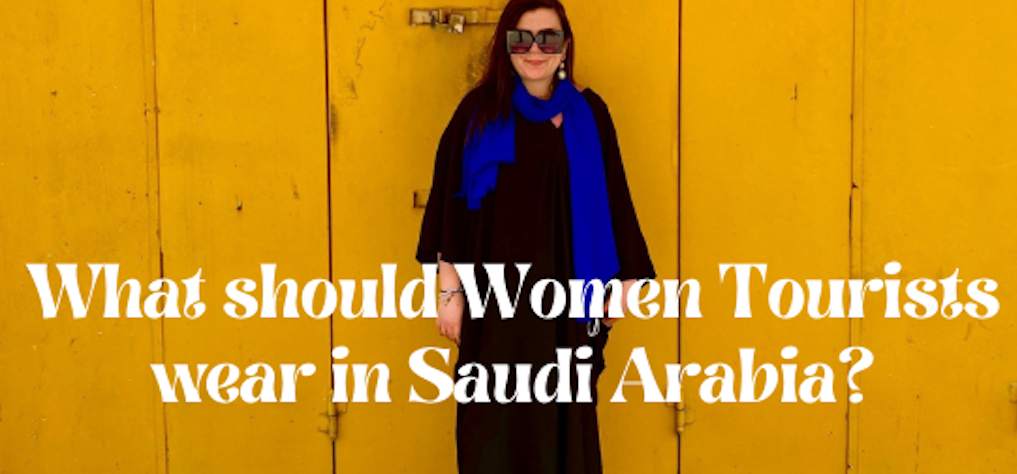
What Should Women Tourists Wear in Saudi Arabia?
When I had a flight booked from NYC to Riyadh, I was not only concerned with how I should dress on the plane, but how I should dress once I planned to exit the airport. I found conflicting information online; some sites saying to dress in the traditional hijab and abaya, while others saying women can dress in modern everyday clothes, so long as they are modest. Here’s what I learned about women’s attire in my short-time in Riyadh, Saudi Arabia.
Do Women Have To Wear An Abaya?
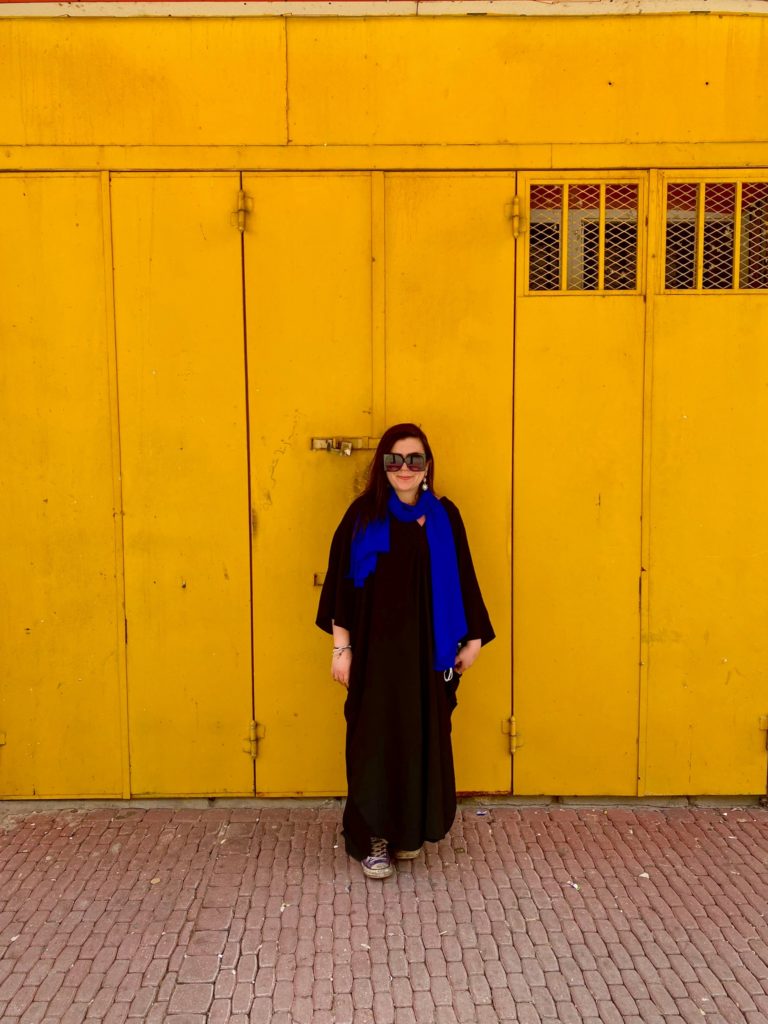
Women should definitely not be walking around in short-shorts and tank-tops, but do we have to wear an abaya? Nope. I bought this piece for my trip to Saudi Arabia, and my guide told me I didn’t need to wear it.
Though not a traditional abaya, I wore a Kaftan instead. I knew I could get future use of it as a beach cover-up. Plus, it was so comfortable to wear on the plane, and while walking around Riyadh!
You can purchase the Kaftan pictured above here.
What was even more convenient about this piece was I kept my fanny pack with all of my most valuables (travel credit card, headphones, passport, phone charger) underneath, and no one could see it, though it did make for an awkward encounter when I was randomly asked to show my passport at one point.
Do Women Have To Wear a Hijab?
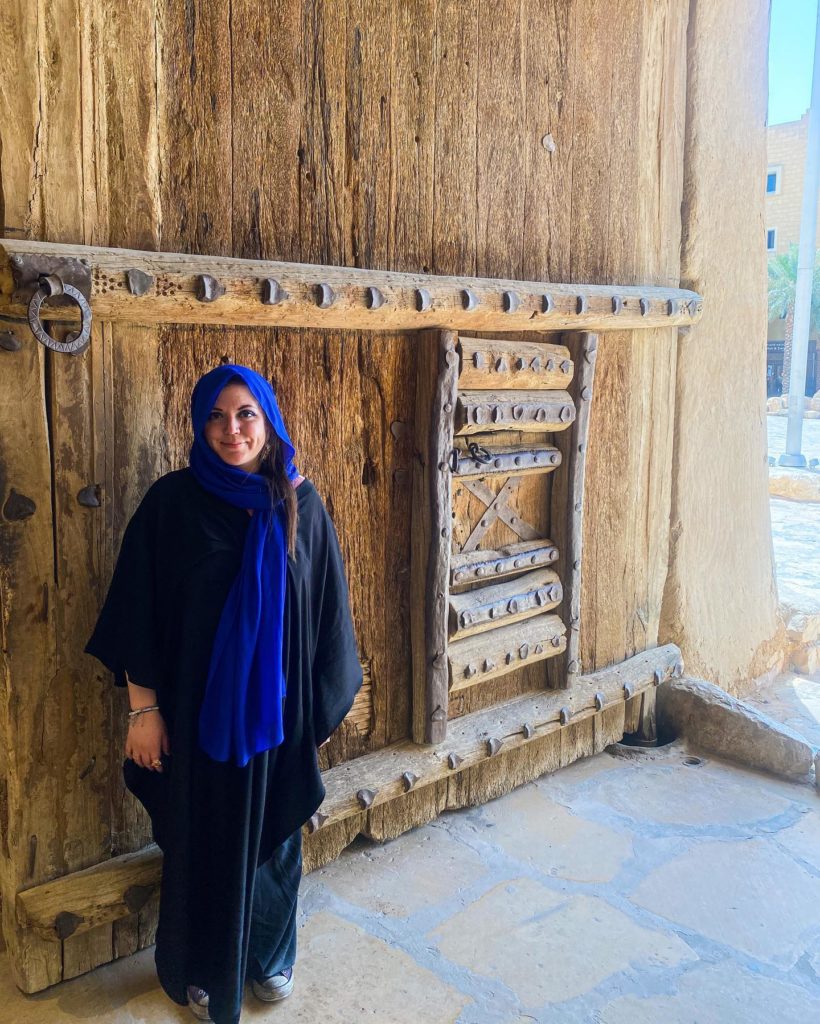
As you can see, I kept a blue scarf around my neck in case I was to visit any holy sites that required my hair to be covered. For the most part, however, I was able to just wear it as is. Underneath my kaftan, I wore black leggings and a light pink t-shirt that went up to my neck, as I did not want any of the skin on my chest/cleavage to be showing.
Even in this photo, you can see that I had my hair covered, but not fully in the proper way. That is because there were no rigid rules for tourists to dress the way local women do. I had hired a guide for the day, and he told me it was not necessary to keep an abaya on, and that I could wear more casual clothing if I so desired. I chose not to, because I think it adds to the experience to dress respectfully based on the local culture, and because I was traveling alone, I wanted to minimize my standing out.
Buy some colorful scarves for your trip to Saudi Arabia here.
What Should Women NOT Wear?
- Short shorts
- Shirts showing cleavage
- Anything that exposes your shoulders
- Dresses/skirts that are above the knee
- Bikinis on public beaches
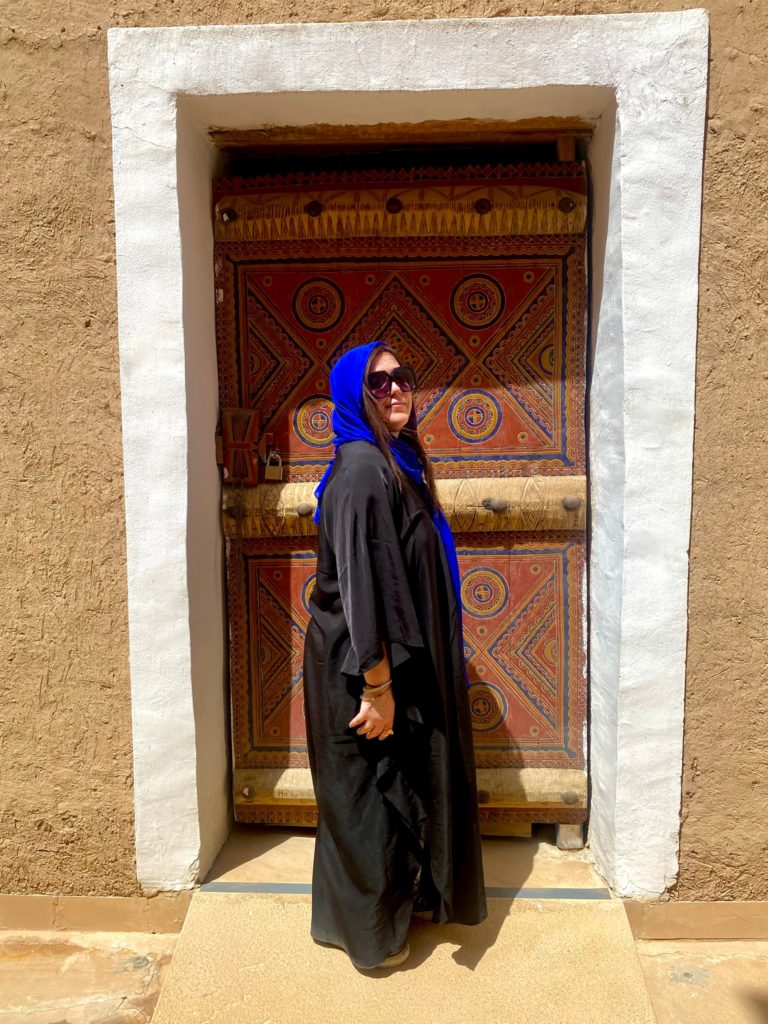
So… What Can Women Wear?
In short… women can wear almost anything they want , with the exception of those listed above.
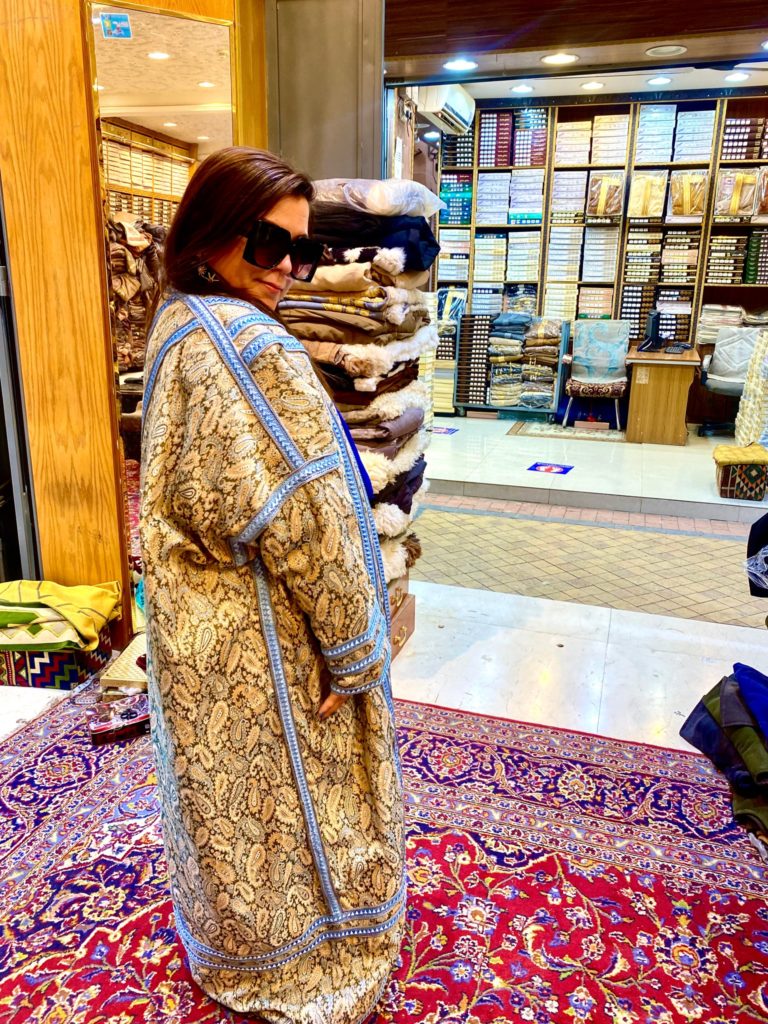
If I had seen this photo of myself even a few months ago, I would never guess it would be taken in Saudi Arabia. I always assumed the dress-code would be strict, that my hair must be covered at all times, and that there’s no fashion freedom. How very wrong I was! I saw women, mainly locals, with fabulous smoky makeup and designs on their abayas. Even in wearing their traditional clothing, they all found ways to make it fabulous. Inspired by them, I did a blue eyeshadow pop to go with my blue scarf.
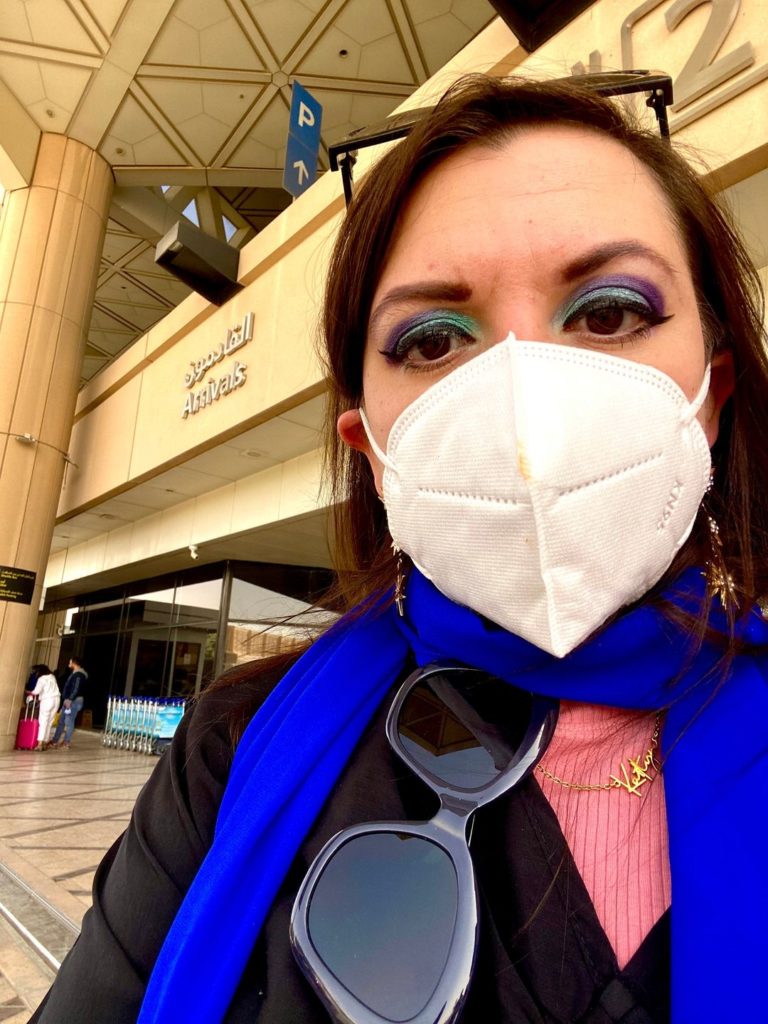
Have you ever traveled to somewhere with a rigid dress-code? Did you enjoy dressing like the locals? How did it add to your experience? Leave a comment and let me know!
DISCLAIMER: I might make a small commission from some of the links throughout this article, but the price is the same for you. This helps keep my business running so I can continue to provide free travel tips!
20 Comments
Many thanks for sharing these types of wonderful discussions. In addition, the ideal travel and medical insurance strategy can often relieve those issues that come with journeying abroad. Any medical crisis can rapidly become very expensive and that’s bound to quickly put a financial weight on the family’s finances. Having in place the best travel insurance program prior to setting off is definitely worth the time and effort. Thanks
Wonderful work! This is the type of information that should be shared around the web. Shame on Google for not positioning this post higher! Come on over and visit my website . Thanks =)
Haha thank you!
Youre so cool! I dont suppose Ive read anything like this before. So good to find anyone with some authentic ideas on this subject. realy thanks for starting this up. this web site is one thing that’s wanted on the internet, somebody with a bit of originality. useful job for bringing one thing new to the internet!
Nice i really enjoyed reading your blogs. Keep on posting. Thanks
Thank you for sharing indeed great looking !
Pingback: Can Women Tourists Travel to Saudi Arabia Alone? - No Man Nomad
Awesome blog! Do you have any tips and hints for aspiring writers? I’m hoping to start my own blog soon but I’m a little lost on everything. Would you suggest starting with a free platform like WordPress or go for a paid option? There are so many options out there that I’m completely overwhelmed .. Any recommendations? Thank you!
Please let me know if you’re looking for a article author for your blog. You have some really good posts and I think I would be a good asset. If you ever want to take some of the load off, I’d absolutely love to write some content for your blog in exchange for a link back to mine. Please blast me an e-mail if interested. Thanks!
Pingback: 8 Things To Do in Jaipur: India's Pink City - No Man Nomad
Hello there, just became alert to your blog through Google, and found that it’s really informative. I am gonna watch out for brussels. I’ll appreciate if you continue this in future. Lots of people will be benefited from your writing. Cheers!
I truly appreciate this article post. Awesome.
Really Appreciate this blog post, can you make it so I get an update sent in an email every time you publish a new post?
Great web site you’ve got here.. It’s hard to find excellent writing like yours nowadays.
I truly appreciate people like you! Take care!!
I was pretty pleased to find this great site. I need to to thank you for ones time just for this fantastic read!! I definitely enjoyed every bit of it and i also have you bookmarked to see new stuff on your site.
Very interesting topic, regards for posting.
Good post. I absolutely appreciate this website. Keep writing!
Leave a Comment Cancel
Your email address will not be published. Required fields are marked *
Email Address:
Save my name, email, and website in this browser for the next time I comment.
- Environment
- Road to Net Zero
- Art & Design
- Film & TV
- Music & On-stage
- Pop Culture
- Fashion & Beauty
- Home & Garden
- Things to do
- Combat Sports
- Horse Racing
- Beyond the Headlines
- Trending Middle East
- Business Extra
- Culture Bites
- Year of Elections
- Pocketful of Dirhams
- Books of My Life
- Iraq: 20 Years On
Saudi Arabia relaxes dress code for women tourists
Female visitors no longer need to wear an abaya - or cover their heads - as kingdom introduces a new era for tourism.
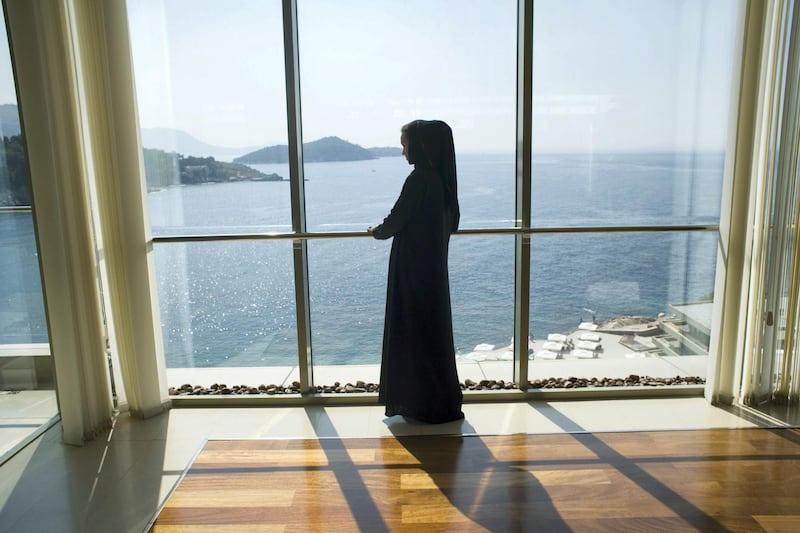
Women visiting Saudi Arabia will not have to wear an abaya. Getty

As Saudi Arabia announced a new tourist visa regime, the country also revealed a more relaxed dress code for women visitors.
Female tourists in Saudi Arabia no longer need to wear an abaya.
According to the Saudi Commission for Tourism and National Heritage, it is not mandatory for women visiting the country to wear an abaya or hijab.

Both men and women are advised to dress modestly in public and to avoid tight-fitting clothing. Women should cover shoulders and knees in public, but do not need to wear traditional clothing.
Championing the more relaxed dress code, the country’s president of tourism set the precedence at a session of memoranda of understanding signings in Riyadh on Friday.

Just hours after details of the dress code were released, His Excellency Ahmed AlKhateeb, the president of the Saudi Commission for Tourism and National Heritage, headed a session of memorandum of understanding (MoU) signings alongside an uncovered Gloria Guevara Manzo, president & CEO at the World Travel & Tourism Council.
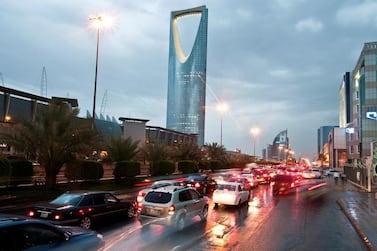
Guevara Manzo wore neither an abaya or a headscarf as she shook hands, posed for photographs and signed a memorandum with Mr AlKhateeb on stage at the Open Saudi conference at The Ritz-Carlton Riyadh.
The event was attended by several ministers and key authority figures as well as representatives from the Kingdom's Vision2030 tourism giga-projects. Many women attending the event were also uncovered.
The announcement also follows actions from several Saudi women who have recently opted not to wear the traditional attire.
Pictures of 33-year-old Mashael Al Jajoud recently went viral after the woman was pictured wearing an orange top and white trousers in a mall in Riyadh.
In March last year, the Saudi Crown Prince hinted that the country might relax the strict rules around women's dress code.

To attract tourists, Saudi Arabia is dropping its strict dress code for foreign women
Foreign women won't have to wear an abaya, the flowing cloak that's been mandatory attire for decades, but will be instructed to wear 'modest clothing'
Author of the article:
You can save this article by registering for free here . Or sign-in if you have an account.
Article content
(Bloomberg) — Saudi Arabia will drop its strict dress code for foreign women as it seeks for the first time to lure holidaymakers and the spending that could help develop the kingdom’s economy away from its reliance on oil.
Foreign women won’t have to wear an abaya, the flowing cloak that’s been mandatory attire for decades, though they’ll be instructed to wear “modest clothing,” said Ahmed Al-Khateeb, chairman of the Saudi Commission for Tourism and National Heritage and a key adviser to Crown Prince Mohammed bin Salman.
Enjoy the latest local, national and international news.
- Exclusive articles by Conrad Black, Barbara Kay, Rex Murphy and others. Plus, special edition NP Platformed and First Reading newsletters and virtual events.
- Unlimited online access to National Post and 15 news sites with one account.
- National Post ePaper, an electronic replica of the print edition to view on any device, share and comment on.
- Daily puzzles including the New York Times Crossword.
- Support local journalism.
Create an account or sign in to continue with your reading experience.
- Access articles from across Canada with one account.
- Share your thoughts and join the conversation in the comments.
- Enjoy additional articles per month.
- Get email updates from your favourite authors.
Don't have an account? Create Account
On Saturday, the government will open applications for online tourist visas for citizens of 49 countries, while others can apply at embassies and consulates overseas, Al-Khateeb told Bloomberg TV in Riyadh.
Saudi Arabia has long been one of the hardest countries in the world to visit, issuing visas only for business trips, religious pilgrimage or family gatherings. But in 2016 — as the oil-price rout wreaked havoc on the kingdom’s finances — the government vowed to develop tourism as part of Prince Mohammed’s economic transformation plan. Officials say it’s a promising non-oil sector that could help draw Saudi tourist dollars back home and bring in a new kind of foreign spending.
“We encourage the private sector and the investor to come and explore the massive amount of opportunity,” Al-Khateeb said, detailing plans to expand airport capacity, add hundreds of thousands of hotel rooms and develop restaurant and lifestyle offerings.
Yet opening to foreign tourists also means opening to their foreign ways — a major shift for a country where a rigid interpretation of Islam long governed all aspects of life from gender mixing to eyebrow plucking.
Get a dash of perspective along with the trending news of the day in a very readable format.
- There was an error, please provide a valid email address.
By signing up you consent to receive the above newsletter from Postmedia Network Inc.
A welcome email is on its way. If you don't see it, please check your junk folder.
The next issue of NP Posted will soon be in your inbox.
We encountered an issue signing you up. Please try again
The kingdom has already grappled with a slew of social changes over the past few years, and some Saudis are thrilled by the transformation. But others remain deeply conservative, and the sight of foreign tourists roaming the streets of Riyadh without abayas will be controversial.
I can imagine how many job opportunities there will be in the tourism sector, as well as food and retail
“These tourists are going to poison our society by bringing in their un-Islamic customs,” said Manal, a 35-year-old Riyadh resident who asked for her last name to be withheld so she could speak freely. “We will be exposed to sin.”
It’s also unclear how far the kingdom is willing to bend rules about alcohol and unmarried couples staying together — both banned — that could be off-putting to potential visitors. Some hotels have been told not to ask about the marital status of guests.
Plenty of Saudis are excited about the new opportunities tourism will bring.
“I can imagine how many job opportunities there will be in the tourism sector, as well as food and retail,” said Njoud Fahad, a 28-year-old travel blogger. “Society will be enriched by all the diversity of people coming in from all around the world with their culture and language.”
Al-Khateeb said the government is targeting 64 million visits by 2022 and 100 million per year by 2030 — up from 40 million today — though that includes both domestic and foreign tourists.
It’s unlikely that hordes of Western holidaymakers will flock to a country where bikinis are taboo and people brew wine illegally at home.
Saudi Arabia’s reputation abroad has also taken a hit since the murder of critic Jamal Khashoggi at the kingdom’s consulate in Istanbul a year ago, which triggered international outrage, and the arrest of prominent women’s rights activists accused by authorities of undermining state security.
The government also faces condemnation for its military campaign in Yemen, which has contributed to the world’s worst humanitarian crisis. Yemen’s Houthi rebels frequently send ballistic missiles over the border and have injured and killed people during attacks on the airport in the southern Saudi city of Abha, a popular tourist destination. The recent escalation of tensions with Iran following an attack on key Saudi oil installations could also deter visitors.
However, the new visas could attract more adventurous travelers, particularly those who want to visit pristine islands, see little-known historical sites or explore an oft-misunderstood culture.
- Inside Saudi Arabia's response to a raid on the heart of the oil kingdom
Tour guide Wael Alkaled, 34, said he often gets inquiries from foreigners about the photos he posts on Instagram showing off the untouched beaches and mountainous terrain of his northern region of Tabuk.
“People come to me to ask where is this place, we’d love to visit,” he said. “The launch of the tourist visa will create different work opportunities and more business.”
Al-Khateeb said he believes Saudis will embrace the influx of tourists.
“We have hundreds of thousands of Saudi students who studied outside and came back, and we welcome different cultures, different religions,” he said. “We are a very welcoming nation.”
He pointed out that the country has already gone through massive changes over the past few years, including an end to a ban on women driving and the introduction of cinemas and mixed-gender concerts.
“If you disagree with something, you have the right not to go for it or not to visit,” Al-Khateeb said. “Today most of the changes are behind us.”
Asked if Saudi women will be allowed to go out without abayas, he declined to comment. “Until now we’re not discussing this because it has never been a problem,” he said. “It is part of our culture.”
While abayas will be optional for foreign visitors and residents, they will be subject to rules requiring modest dress, he added.
Asked about potentially conflicting rulings from religious clerics, who for years had a major influence on government policy, he said: “The dress code will be published by the government and the government is the highest authority.”
“What the tourists can see here in Saudi Arabia and explore is the culture — the strong and great culture that we have,” said Al-Khateeb. “We remain authentic.”
Our website is the place for the latest breaking news, exclusive scoops, longreads and provocative commentary. Please bookmark nationalpost.com and sign up for our daily newsletter, Posted, here .
Postmedia is committed to maintaining a lively but civil forum for discussion. Please keep comments relevant and respectful. Comments may take up to an hour to appear on the site. You will receive an email if there is a reply to your comment, an update to a thread you follow or if a user you follow comments. Visit our Community Guidelines for more information.
Why Tessa Virtue and Morgan Rielly were reportedly ordered to stop painting their Toronto home
Jesse kline: 'independent' senators give themselves cover to block poilievre’s agenda, secret service threatened to tase travis kelce at white house, australia wants canadian permanent residents to join its military, mps demand more information on colleagues helping foreign powers because it 'reflects poorly on the rest of us', here’s where to buy glasses online in canada.
Plus, what you need to know before you start shopping
Top facial sunscreens for every skin concern
From drugstore to luxury SPF
Advertisement 2 Story continues below This advertisement has not loaded yet, but your article continues below.
Ooni’s new, giant oven is barely a pizza oven at all
The biggest Ooni yet opens the world of ultra-heat cooking to more than just ultra-flat dishes
The Acolyte's Lee Jung-Jae on Star Wars and his favourite things
Squid Game star on his new role as Master Sol in The Acolyte, which premieres on Disney+ June 4
Beauty buzz: Clarins Joli Rouge Nude, Blue Lizard Sensitive Mineral Sunscreen Stick, and Lancôme Hypnose Drama Extreme Volume Mascara k
Three buzzed-about beauty products we tried this week.
This website uses cookies to personalize your content (including ads), and allows us to analyze our traffic. Read more about cookies here . By continuing to use our site, you agree to our Terms of Service and Privacy Policy .
You've reached the 20 article limit.
You can manage saved articles in your account.
and save up to 100 articles!
Looks like you've reached your saved article limit!
You can manage your saved articles in your account and clicking the X located at the bottom right of the article.
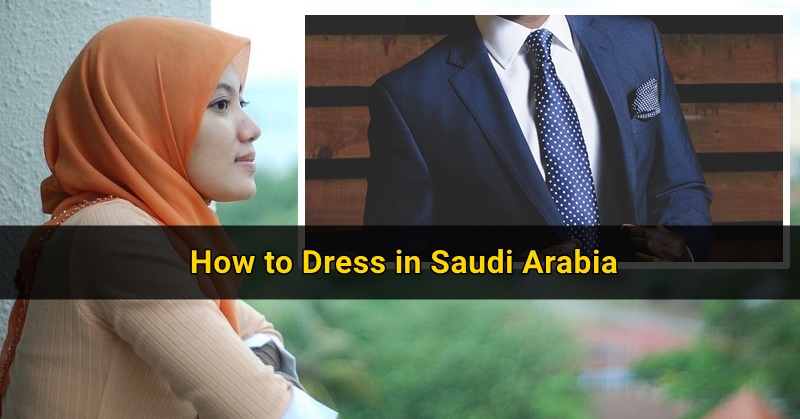
How to Dress in Saudi Arabia
If you are planning to live and work in Saudi Arabia, then you should start learning as much as you can about its culture. One of the things that you should definitely look into is the dress code , especially when going out in public or heading to work.
ALSO READ: Saudi Arabia Guide for First-Time Visitors
Today’s article presents some of the do’s and don’ts in the Kingdom when it comes to dressing up. Some places tend to be more strict than others in enforcing these rules. Still, it helps to be familiar with them, regardless of where you will stay in the country.
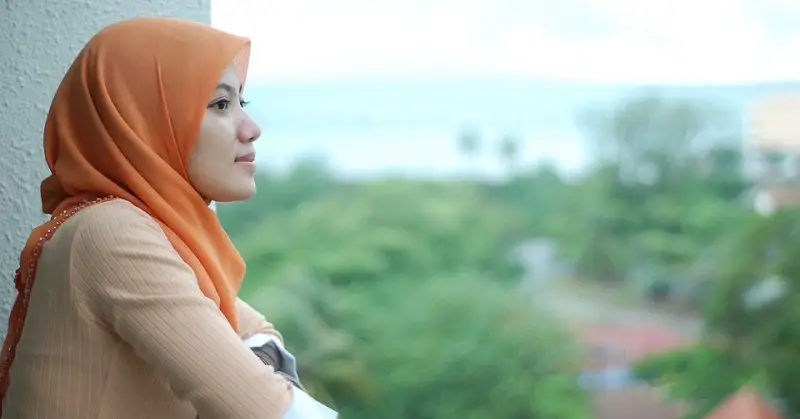
Saudi Arabia Guide: Dress Code
Here are some rules for men and women (foreigners) regarding the dress code in Saudi Arabia:
DO’s & DON’T’s for Men
DO… Dress modestly at all times. DO… Make sure that your shoulders and legs are covered . DO… Follow office rules for dressing up at work. A pair of pants, formal shirt, and tie are often acceptable, and of course you may have to wear a suit and tie for special occasions. DO… Remove your shoes when visiting a mosque.
DON’T… Wear shorts in public. DON’T… Wear skinny jeans . DON’T… Wear any jewellery other than your wedding ring (if married) and wrist watch.

DO’s & DON’T’s for Women
DO… Dress modestly at all times. DO… Make sure that your wrists, ankles, and chest are covered . DO… Wear an “ abaya ” when you are out in public. This is a long, black cloak (usually black) worn over your “normal” clothes. DO… Wear a “ hijab ” or headscarf when going out in public. DO… Remove your shoes when visiting a mosque.
DON’T… Wear tight-fitting clothes. DON’T… Wear “ see-through ” fabrics. DON’T… Wear “ too much ” make-up. Simplicity is the key!
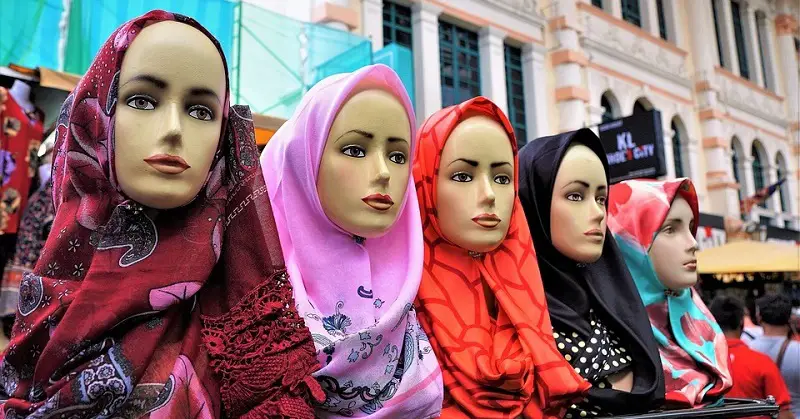
In recent years, there have been many changes pertaining to women in Saudi Arabia. They are now allowed to drive , join the army , and do many other activities. Even the Saudi Crown Prince himself stated that “ abayas are not necessary for women.” Nevertheless, it is still wise to wear an abaya and headscarf when you go out in public, just to be on the safe side!
ALSO READ: List of Prohibited & Restricted Items in Saudi Arabia
As you can see, the general rule of thumb is to dress modestly, wherever you may be in Saudi Arabia. By keeping in mind these rules, you are actually showing your respect towards the local culture, and you can expect to have a peaceful, trouble-free stay in the Kingdom.

- Saudi Arabia Tourism
- Saudi Arabia Hotels
- Saudi Arabia Bed and Breakfast
- Saudi Arabia Vacation Rentals
- Flights to Saudi Arabia
- Saudi Arabia Restaurants
- Things to Do in Saudi Arabia
- Saudi Arabia Travel Forum
- Saudi Arabia Photos
- All Saudi Arabia Hotels
- Saudi Arabia Hotel Deals
- Last Minute Hotels in Saudi Arabia
- Saudi Arabia
- Things to Do
- Restaurants
- Vacation Rentals
- Travel Stories
- Rental Cars
- Add a Place
- Travel Forum
- Travelers' Choice
- Help Center
Dress Code for Men - Saudi Arabia Forum
- Middle East
- Saudi Arabia
Dress Code for Men
- United States Forums
- Europe Forums
- Canada Forums
- Asia Forums
- Central America Forums
- Africa Forums
- Caribbean Forums
- Mexico Forums
- South Pacific Forums
- South America Forums
- Middle East Forums
- Honeymoons and Romance
- Business Travel
- Train Travel
- Traveling With Disabilities
- Tripadvisor Support
- Solo Travel
- Bargain Travel
- Timeshares / Vacation Rentals
- Middle East forums
- Saudi Arabia forum

As for Mecca and Medina can I wear T shirt in mosques and masjid Al Haram or it has to be for sure long sleeve shirts?

1. Yes, but best not to wear very short shorts. Locals usually wear ¾ length shorts
2. Not sure about t-shirts inside the masjid. They cover the 'awra' so should be ok but I didn't see many people wearing them.
Most common to see thobes or salwar kameez
- There's no such thing as a transit visa! Pay! 10:23 am
- Transport from Dammam to Bahrain 6:24 am
- KSA Transit Visa Problem Urgent help yesterday
- Showers to enter Ihram yesterday
- Arriving by cruise ship in Jeddah yesterday
- Carry on luggage yesterday
- Visa on arrival yesterday
- Family visit visa entrance on 15th june yesterday
- Umrah alone - Single woman Jun 03, 2024
- Uk Umrah Visa Waiver Jun 03, 2024
- Any expats living in Riyadh? Can a gay couple live here? Jun 02, 2024
- Flying Taxis between Jeddah Airport & Makkah 2024 Jun 02, 2024
- Nusuk Hajj - application keeps getting rejected unreasonably Jun 02, 2024
- How to book speed train or bus in mekkah to madinah? Jun 02, 2024
- Train from Dammam to Riyadh 19 replies
- Westerners, Women,and Life in Riyadh 82 replies
- Road trip to Saudi Arabia 10 replies
- Flying Saudi Arabian Airlines 105 replies
- Electric Plug converter required in Saudi and Bahrain? 2 replies
- Visitor visa for Saudi for Indian citizen :( 2 replies
- living in jazan 27 replies
- Saudi Airlines Domestic Flight! Help! 12 replies
- al jouf 7 replies
- Riyadh & Al Jouf 7 replies
Saudi Arabia Hotels and Places to Stay
- 24 Historical Ziyarat places in Makkah
- Drivers for Jeddah, Makkah & Madina & City Tours
- Zam Zam water carrying on airplane
- Solo trip to KSA?

Always Avoid These 10 Mistakes Tourists Make in Dubai
By: Author Ruben Arribas
Posted on June 4, 2024
Categories Uncategorized
Dubai, a city of architectural marvels and bustling markets, offers a unique blend of modernity and tradition. As a traveler, I’ve experienced the city’s dazzling skyscrapers, luxury shopping, and vibrant nightlife firsthand. In this guide, I want to help you with top tips on how to avoid the top 10 mistakes tourists make in Dubai.
Dubai demands respect for its cultural norms and rules, which can be quite different from those in Western countries. This guide aims to shed light on the common mistakes tourists make when visiting Dubai, helping you navigate the city’s customs with ease and enjoy its many wonders without any hiccups.
From understanding the local laws to navigating the climate and cultural expectations, this article will prepare you for a seamless and respectful visit to one of the most dynamic cities in the world. Let’s dive into the details to ensure your trip to Dubai is as enjoyable and trouble-free as possible.
📌 Additional Reads: – 5 Tourist Traps to Avoid in Dubai And How to Avoid Them – Dubai Breakfast – Top Breakfast in Dubai to Try When Visiting – What to do in Dubai – 7 Checklist to Mark In Your Luxury Trip – Getting a Dubai SIM Card in 2024: Prepaid SIM Card in Dubai – Travel Insurance You Need To Get When You’re in Dubai
Table of Contents
Mistake 1: Ignoring Dress Codes in Public Spaces | Mistakes Tourists Make in Dubai
Commonality and Risks:
Dubai maintains a conservative dress code compared to many Western countries. Tourists sometimes forget or ignore these norms, especially in malls, restaurants, and public streets, which can lead to uncomfortable situations or even official warnings from local authorities.
How to Avoid It:
• Research Before You Go: Before arriving in Dubai, familiarize yourself with the local dress code. Generally, clothing that covers shoulders and knees should be worn in public spaces.
• Pack Appropriately: Include a mix of modest clothing in your travel wardrobe. For women, this might mean packing long skirts or pants and tops that cover the shoulders. Men should avoid wearing shorts and sleeveless shirts in non-beach areas.
• Carry a Cover-up: It’s a good idea to carry a lightweight scarf or shawl. It comes in handy not just for a sudden need to cover up more thoroughly but also for entering places of worship or other sites requiring more conservative dress.
By respecting the local dress code, you not only avoid potential discomfort but also show respect for the cultural norms of Dubai, enhancing your overall experience.
Mistake 2: Misunderstanding Dress Codes at Beaches and Hotel Pools
Dubai’s dress code becomes more liberal at beaches and hotel pools, yet some tourists go to extremes by wearing overly revealing swimwear or behaving inappropriately, forgetting that Dubai is still a conservative city at its core. This can lead to discomfort among other guests or even reprimands from staff.
• Understand the Boundaries: While swimwear is acceptable at the beach and hotel pools, it’s important to cover up when you’re walking through the hotel or public areas. Beach cover-ups are not just fashionable but also in line with local customs.
• Choose Appropriate Swimwear: Opt for swimwear that is respectful of the local culture. For example, avoid thong bikinis or excessively skimpy swimsuits. Men should wear swim trunks instead of brief-style swimwear.
• Behavior Matters: Be mindful of your behavior while at the beach or pool. Public displays of affection, which are normal in many Western countries, can be frowned upon here.
By understanding the nuances of what is acceptable at beaches and in resort areas, you can enjoy Dubai’s beautiful watersides worry-free, respecting the local culture while having fun.
Mistake 3: Not Scheduling Around the Midday Heat
Dubai’s climate can reach extreme temperatures, especially during the summer months, when the midday heat can be particularly oppressive. Tourists often underestimate the heat, planning outdoor activities during peak heat hours, which can lead to heat exhaustion or more severe heat-related illnesses.
• Plan Outdoor Activities Wisely: Schedule sightseeing, shopping in outdoor markets, or walks along the marina during the early morning or later in the afternoon. Avoid outdoor activities between 11 AM and 3 PM, when the sun is most intense.
• Stay Hydrated: Carry a water bottle with you at all times, and drink more water than you think you need. Staying hydrated is key to avoiding heat stroke.
• Use Sun Protection: Wear a hat, sunglasses, and apply high SPF sunscreen regularly. Seeking shade wherever possible also helps reduce the risk of sunburn and heat stroke.
By adjusting your schedule to avoid the hottest part of the day, you ensure a more comfortable and safe experience as you explore all that Dubai has to offer.
Mistake 4: Overlooking the Importance of Travel Insurance | Mistakes Tourists Make in Dubai
Many travelers to Dubai might skip purchasing travel insurance, considering it an unnecessary expense. However, unexpected medical emergencies, cancellations, or lost luggage can significantly affect your travel plans and budget.
• Secure Comprehensive Coverage: Opt for travel insurance that covers medical emergencies, trip cancellations, and loss of personal belongings. This is particularly crucial in Dubai, where medical costs can be high.
• Read the Fine Print: Ensure you understand what your insurance covers. Some policies may not cover certain activities considered high risk, such as desert safaris or scuba diving.
• Consider the Cost of Not Having It: Weigh the small upfront cost of insurance against potential large expenses in emergencies. It’s a small price to pay for peace of mind.
Mistake 5: Relying Solely on Public Transportation
Dubai’s public transport system is efficient but doesn’t cover all areas extensively, especially more secluded tourist spots or some residential areas. Tourists often assume it’s comprehensive, which can lead to delays and inconvenience.
• Use a Mix of Transport Options: Combine public transport with taxis or rideshare services to cover areas not easily accessible by metro or bus.
• Plan Your Routes in Advance: Check the public transportation routes and schedules to ensure they align with your itinerary, especially if you plan to visit outlying areas.
• Consider Renting a Car: If you’re comfortable driving in a foreign country, renting a car can give you the flexibility to explore Dubai at your own pace, including less accessible sites like the desert or distant resorts.
Mixing different modes of transportation can lead to a smoother and more flexible travel experience in Dubai, helping you make the most of your visit without the stress of limited mobility.
Mistake 6: Ignoring Local Customs and Etiquette
Dubai has a rich cultural heritage that is closely intertwined with Islamic traditions. Tourists sometimes overlook local customs, which can lead to uncomfortable situations or even fines.
• Research Local Traditions: Before your trip, take some time to learn about Dubai’s cultural norms, especially those related to dress codes, public behavior, and etiquette.
• Dress Modestly: When outside of tourist resorts and beaches, dress conservatively to respect the local culture. This is particularly important in religious sites and older parts of the city.
• Observe Public Decorum: Public displays of affection are frowned upon, and behaviors like loud arguments or public drunkenness can lead to penalties.
By showing respect for local customs and etiquette, you enhance your interactions with locals and ensure a more welcoming experience throughout your stay in Dubai.
Mistake 7: Misunderstanding the Costs of Traveling in Dubai
Dubai is known for its luxury and opulence, but tourists often underestimate the cost of services and activities here, leading to budget overruns.
• Plan Your Budget: Before traveling, research the costs of accommodations, meals, transportation, and attractions in Dubai. This helps set realistic expectations and manage your finances better.
• Look for Discounts and Deals: Dubai offers various tourist passes and discounts, especially during off-peak seasons. Check for deals on dining, entertainment, and tours.
• Use Public Transport: While taxis are convenient, they can be expensive for longer distances. Dubai’s metro and buses are affordable and cover major attractions, helping save money.
Understanding and managing your travel expenses wisely ensures that you enjoy Dubai’s attractions without financial stress.
Mistake 8: Ignoring Local Customs and Etiquette
Dubai has a rich cultural heritage, and not respecting local customs can lead to uncomfortable situations or even fines.
• Learn About Local Etiquette: Educate yourself on the basic customs, such as greetings, dressing modestly, and rules about public behavior.
• Follow Dress Codes: Dress conservatively, especially in religious sites and older parts of the city. In more modern areas like shopping malls, while the dress code is more relaxed, it is still advised to avoid overly revealing attire.
• Be Mindful of Public Displays of Affection: Public displays of affection are frowned upon and can attract legal attention. It’s best to be conservative in public spaces.
Being aware of and respectful towards local customs not only enriches your travel experience but also helps maintain harmony and respect in interactions with locals.
Mistake 9: Disregarding Photography Regulations | Mistakes Tourists Make in Dubai
Tourists often get carried away by Dubai’s stunning architecture and vibrant street scenes, forgetting that not all places welcome photography, especially when it involves people or government buildings.
• Respect Privacy Laws: Always ask for permission before photographing people, particularly local women. Avoid taking pictures of government buildings, military sites, and other restricted areas.
• Use Discretion: In many attractions, photography is allowed, but it’s courteous to be discreet and respectful, ensuring you’re not disrupting others or capturing sensitive content.
• Check for Signs: Look for ‘No Photography’ signs in public areas or at tourist sites, and adhere to these regulations strictly.
Understanding and respecting photography rules will help you avoid legal issues and demonstrate respect for the local culture and privacy.
Mistake 10: Assuming Everyone Speaks English
Dubai is a cosmopolitan city with a large expatriate community, and while English is widely spoken, assuming it in every interaction can come across as insensitive. It overlooks the cultural diversity and the presence of many languages spoken by the local population and expats alike.
• Learn Basic Arabic Phrases: Gaining familiarity with common Arabic greetings and phrases shows respect for the local culture and can enhance your interactions.
• Use Simple English: When English is your only option, speak slowly and clearly using simple terms, especially with taxi drivers, small shop owners, and older locals who might be less fluent.
• Language Apps and Tools: Keep handy a translation app or a phrasebook that can help you navigate basic conversations, particularly in less touristy areas or when dealing with complex situations like medical emergencies or legal matters.
Adapting to the linguistic landscape of Dubai not only facilitates smoother communication but also enriches your travel experience by deepening your engagement with the local culture.
Wrapping up and Making Sure You Don’t Make these 10 Mistakes Tourists Make in Dubai
Reflecting on your trip to Dubai and the potential pitfalls you’ve navigated (or might encounter) underscores the unique blend of modern luxury and rich tradition that the city embodies. Remember, the key to a fulfilling visit to Dubai doesn’t just lie in exploring its opulent landscapes and architectural marvels; it also hinges on respecting its cultural norms and engaging with the local customs thoughtfully. Whether it’s dressing modestly, managing your photography etiquette, or haggling in the souks, each action contributes to a more respectful and enjoyable travel experience. Dubai offers an extraordinary adventure to those who are prepared—so take these tips to heart, and you’re set for an unforgettable journey in the heart of the UAE.
With these insights, your next visit to Dubai can be not only magnificent but also seamless, ensuring that you enjoy the best of what this dazzling city has to offer without any common tourist faux pas.
About the Author : Ruben , co-founder of Gamintraveler.com since 2014, is a seasoned traveler from Spain who has explored over 100 countries since 2009. Known for his extensive travel adventures across South America, Europe, the US, Australia, New Zealand, Asia, and Africa, Ruben combines his passion for adventurous yet sustainable living with his love for cycling, highlighted by his remarkable 5-month bicycle journey from Spain to Norway. He currently resides in Spain, where he continues sharing his travel experiences with his partner, Rachel, and their son, Han.
- Share full article

Stephen Hiltner/The New York Times
The sculpted facade of a 2,000-year-old tomb glows in the late-afternoon sun at Hegra, a UNESCO World Heritage site.
Crowds of Muslim pilgrims gather outside the Prophet’s Mosque in Medina.
Camels march through the desert on the outskirts of the Empty Quarter, the world’s largest sand sea.
For many years these Saudi Arabian scenes, including the lively open-air markets in Jeddah, were off limits to most travelers.
But not anymore. As it undergoes a profound transformation, Saudi Arabia is spending lavishly to lure tourists with its luxe new resorts ...
... its rich cultural heritage ...
... and its sublime natural beauty.
Can the Saudi government persuade would-be visitors to look past — or reconsider — its longstanding associations with religious extremism, ultraconservatism and human rights abuses?
Will the kingdom’s $800 billion bet on tourism pay off?
Supported by
Surprising, Unsettling, Surreal: Roaming Through Saudi Arabia
To witness the kingdom’s profound transformation and assess its ambitious tourism projects, a Times journalist spent a month on the road there. Here’s what he saw.

By Stephen Hiltner
An editor and photojournalist for the Travel section, Stephen Hiltner drove 5,200 miles and visited all 13 of Saudi Arabia’s provinces while reporting and shooting this story.
Wandering alone along the southern fringes of Saudi Arabia’s mountainous Asir Province, some eight miles from the Yemeni border, in a nondescript town with a prominent sculpture of a rifle balanced on an ornately painted plinth, I met a man, Nawab Khan, who was building a palace out of mud.
Actually, he was rebuilding the structure, restoring it. And when I came across him, he hadn’t yet begun his work for the day; he was seated on the side of the road beneath its red-and-white windows — cross-legged, on a rug, leaning over a pot of tea and a bowl of dates.
Two weeks earlier, on the far side of the country, a fellow traveler had pointed at a map and described the crumbling buildings here, in Dhahran al-Janub, arranged in a colorful open-air museum. Finding myself nearby, I’d detoured to have a look — and there was Mr. Khan, at first looking at me curiously and then waving me over to join him. Sensing my interest in the cluster of irregular towers, he stood up, produced a large key ring and began opening a series of padlocks. When he vanished through a doorway, I followed him into a shadowy stairwell.
This, of course, was my mother’s worst nightmare: Traveling solo, I’d been coaxed by a stranger into an unlit building in a remote Saudi village, within a volatile border area that the U.S. Department of State advises Americans to stay away from .
By now, though, more than halfway through a 5,200-mile road trip, I trusted Mr. Khan’s enthusiasm as a genuine expression of pride, not a ploy. All across Saudi Arabia, I’d seen countless projects being built, from simple museums to high-end resorts. These were the early fruits of an $800 billion investment in the travel sector, itself part of a much larger effort, Vision 2030 , to remake the kingdom and reduce its economic dependence on oil.
But I’d begun to see the building projects as something else, too: the striving of a country — long shrouded to most Westerners — to be seen, reconsidered, accepted. And with its doors suddenly flung open and the pandemic behind us, visitors like me were finally beginning to witness this new Saudi Arabia, much to Mr. Khan’s and all the other builders’ delight.

Few countries present as complicated a prospect for travelers as Saudi Arabia.
Long associated with Islamic extremism, human rights abuses and the oppression of women, the kingdom has made strides in recent years to refashion its society and its reputation abroad.
The infamous religious police, which upheld codes of conduct based on an ultraconservative interpretation of Islam, were stripped of their power. Public concerts, once banned, are now ubiquitous. Women have been granted new rights — including the freedom to drive and to travel without permission from a male guardian — and are no longer required to wear floor-length robes in public or to cover their hair.
These changes are part of a broad set of strategies to diversify the kingdom’s economy, elevate its status in the world and soften its image — the last of which is a tall order for a government that has killed a newspaper columnist , kidnapped and tortured dissidents , precipitated a humanitarian crisis in Yemen and imprisoned people for supporting gay rights , among a number of other recent abuses .
Central to the transformations led by 38-year-old Crown Prince Mohammed bin Salman, the kingdom’s de facto ruler, is a major push for international visitors. It represents a sea change in a country that, until 2019, issued no nonreligious tourist visas and instead catered almost exclusively to Muslim pilgrims visiting Mecca and Medina, Islam’s two holiest cities. In February, by contrast, my tourist e-visa was approved online in minutes.
Saudi Arabia has already transformed one of its premier destinations — Al-Ula, with its UNESCO-listed Nabatean tombs — from a neglected collection of archaeological sites into a lavish retreat with a bevy of activities on offer, including guided tours, wellness festivals, design exhibitions and hot air balloon rides.
Another project will create a vast array of luxury resorts on or near the Red Sea.
Still more projects include the development of Diriyah , the birthplace of the first Saudi state; the preservation and development of the coastal city of Jeddah ; an offshore theme park called the Rig ; and Neom , the futuristic city that has garnered the lion’s share of attention.
All told, the country is hoping to draw 70 million international tourists per year by 2030, with tourism contributing 10 percent of its gross domestic product. (In 2023, the country logged 27 million international tourists, according to government figures , with tourism contributing about 4 percent of G.D.P.)

At-Turaif, a UNESCO World Heritage site, was the birthplace of the kingdom of Saudi Arabia. It is now the centerpiece of the $63 billion Diriyah project, a new center of culture just outside Riyadh.
Nujuma, a Ritz-Carlton Reserve on a remote island in the Red Sea, opened in late May. (A one-bedroom villa costs about $2,500 per night, excluding taxes and fees.) It is one of 50 properties scheduled to open in the area by 2030.
The preservation and development of Jeddah, a coastal city famous for its historic district built largely from blocks of coral, comes with a price tag of some $20 billion.
Al-Ula is a cornerstone of Saudi Arabia’s tourism ambitions. Part of the city’s Old Town, long crumbling in neglect, has now being painstakingly restored.
To get a sense of these projects and the changes unfolding in Saudi society, I spent a month exploring the kingdom by car. I traveled alone, without a fixer, driver or translator. Per New York Times ethics guidelines, I declined the government’s many offers of discounts and complimentary services.
Much of the time I felt I’d been tossed the keys to the kingdom. But there were moments, too, when I faced a more complicated reality, one epitomized by a road sign that forced me to abruptly exit the highway some 15 miles from the center of Mecca. “Obligatory for Non Muslims,” it read, pointing to the offramp.
To me, the sign broadcast the lines being drawn to compartmentalize the country, which is now marketing itself to two sets of travelers with increasingly divergent — and sometimes contradictory — expectations: luxury tourists at ease with bikinis and cocktails, and pilgrims prepared for modesty and strict religious adherence. It’s hard to know whether the kingdom can satisfy both without antagonizing either.
My trip began in Jeddah, where, after spending two days exploring its historic district, I rented a car and drove eight hours north to Al-Ula, a benchmark for the new Saudi tourism initiatives.

Saudi Arabia
Reporter’s route
Dhahran al-Janub

Wadi al-Disah
Red Sea Resort
The name Al-Ula refers to both a small city and a broader region packed with attractions: Hegra , the kingdom’s first UNESCO World Heritage site and its biggest archaeological draw, is a 30-minute drive north of Old Town, a maze of crumbling mud-brick buildings now partly restored. Between the two, and fanning out to the east and west, are several other archaeological sites, as well as a smattering of resorts, event spaces and adventure outfitters. Farther northeast, beyond Hegra, is the Sharaan Nature Reserve , a vast protected zone used for conservation efforts.
My first priority during my five-day stay in Al-Ula was a visit to Hegra.
Like Petra , its better-known counterpart in Jordan, Hegra was built by the Nabateans, an ancient people who flourished 2,000 years ago. The site contains more than 100 tombs that were carved from solid rock, their entrances adorned with embellishments. Most impressive among them, set apart and standing some 70 feet tall, is a tomb colloquially called the Lonely Castle.
Not long ago, visitors could hire private guides and wander the area on foot, climbing in and out of — and no doubt damaging — the many tombs. Not anymore: I boarded an air-conditioned tour bus and zipped past most of them, stopping at just four locations.
At the penultimate stop, we exited the bus and trudged several hundred feet along a sandy path to the front of the Lonely Castle. Even in the late afternoon, the heat was stifling. I craned my neck to take in the details of the sculpted facade, which emerged like a mirage from one side of a massive boulder: its four pilasters, the rough chisel marks near the bottom, its characteristic five-stepped crown. Ten minutes evaporated, and I turned to find my group being shepherded back onto the bus. I jogged through the sand to catch up.
A few miles north of Hegra, I hopped in the back of a Toyota Land Cruiser — accompanied by an Italian graduate student and his mother — for a drive through the sandy expanse of the Sharaan Nature Reserve.
The scenery was sublime: Slipping through a narrow slot canyon, we emerged into a vast, open desert plain, then settled into a wide valley enclosed by an amphitheater of cliffs. Occasionally our guide stopped and led us on short hikes to petroglyphs, some pockmarked by bullet holes, or to lush fields of wildflowers, where he plucked edible greens and invited us to sample their lemony tang.
Gabriele Morelli, the graduate student, had first come to Al-Ula a few years ago — a different era, he said, given how quickly the place had transformed. He described a version that no longer exists, rife with cheap accommodation, lax rules and a free-for-all sensibility.
Some of the changes, of course, have been necessary to protect delicate ecosystems and archaeological sites from ever-growing crowds. But several people I met in Al-Ula — Saudis and foreigners alike — quietly lamented the extent of the high-end development and the steady erosion of affordability. Many of the new offerings, like the Banyan Tree resort, they pointed out, are luxury destinations that cater to wealthy travelers.
These hushed criticisms were among my early lessons on how difficult it can be to gauge the way Saudis feel about the pace and the pervasiveness of the transformations reshaping their society.
I got a taste of Al-Ula’s exclusivity — and of the uncanniness that occasionally surfaced throughout my trip — at a Lauryn Hill concert in an event space called Maraya . To reach the hall, I passed through a security gate, where an attendant scanned my e-ticket and directed me two miles up a winding road into the heart of the Ashar Valley, home to several high-end restaurants and resorts.
Rounding the final bend, I felt as if I’d stumbled into a computer-generated image: Ant-size humans were dwarfed by a reflective structure that both asserted itself and blended into the landscape. Inside, waiters served hors d’oeuvres and brightly colored mocktails to a chic young crowd.
The surreality peaked when, midway through the show, I left my plush seat to join some concertgoers near the stage — only to turn and see John Bolton, former President Donald J. Trump’s national security adviser, seated in the front row.
Where else, I wondered, could I attend a rap concert in the middle of the desert with a longtime fixture of the Republican Party — amid a crowd that cheered when Ms. Hill mentioned Palestine — but this strange new corner of Saudi Arabia?

The mirrored facade at Maraya, a vast event space in Al-Ula, warps and reflects the surrounding desert landscape.
The building is in some ways a precursor to the kingdom’s most ambitious architectural design: the project at Neom called the Line, a 106-mile linear city that will also feature a mirrored surface.
Lauryn Hill performing in front of a large crowd at Maraya.
After Al-Ula, I drove to another of the kingdom’s extravagant schemes: the Red Sea project, billed as the “world’s most ambitious regenerative tourism destination.” After weaving through a morass of construction-related traffic, I boarded a yacht — alongside a merry band of Saudi influencers — and was piloted some 15 miles to a remote island, where I disembarked in a world of unqualified opulence at the St. Regis Red Sea Resort .
I was chauffeured around in an electric golf cart — past 43 beachside “dune” villas and onto two long boardwalks that connect the rest of the resort to 47 “coral” villas, built on stilts over shallow turquoise water. Along the way, I listened to Lucas Julien-Vauzelle, an executive assistant manager, wax poetic about sustainability. “We take it to the next level,” he said, before rattling off a list of facts and figures: 100 percent renewable energy, a solar-powered 5G network , plans to enhance biologically diverse habitats.
By 2030, he said, the Red Sea project will offer 50 hotels across its island and inland sites. Citing the Maldives, he mentioned the kingdom’s plans to claim a share of the same high-end market.
Another prediction came by way of Keith Thornton, the director of restaurants, who said he expects the resort to legally serve alcohol by the end of the year. (While a liquor store for non-Muslim diplomats recently opened in Riyadh, the Saudi government has made no indication that it plans to reconsider its broader prohibition of alcohol.)
The hotel was undeniably impressive. But there’s an inescapable irony to a lavish resort built at unfathomable expense in the middle of the sea — with guests ferried out by chartered boat and seaplane — that flaunts its aspirations for sustainability.
Toward the end of my several-hour visit, I learned that every piece of vegetation, including 646 palm trees, had been transplanted from an off-site nursery. Later, reviewing historical satellite images, I found visual evidence that the island — described to me as pristine — had been dramatically fortified and, in the process, largely remade. Its footprint had also been significantly altered. It was, in a sense, an artificial island built where a smaller natural island once stood.
Something else struck me, too: The place was nearly empty, save for the staff and the Saudi influencers. Granted, the resort had just opened the month before — but the same was true at the nearby Six Senses Southern Dunes , an inland Red Sea resort that opened in November. Fredrik Blomqvist, the general manager there, told me that its isolated location in a serene expanse of desert — part of its appeal — also presented a challenge in drawing customers. “The biggest thing,” he said, “is to get the message out that the country is open.”
Since the country began issuing tourist visas, influencers have been documenting their experiences in places like Jeddah and Al-Ula, their trips often paid for by the Saudi government. Their breezy content contributes to the impression that the kingdom is awaiting discovery by foreign visitors with out-of-date prejudices. To an extent, for a certain segment of tourists, that’s true.
For many travelers, though, the depiction of the kingdom as an uncomplicated getaway could be dangerously misleading.
Speech in Saudi Arabia is strictly limited; dissent is not tolerated — nor is the open practice of any religion other than the government’s interpretation of Islam. In its travel advisory , the U.S. Department of State warns that “social media commentary — including past comments — which Saudi authorities may deem critical, offensive, or disruptive to public order, could lead to arrest.” Punishment for Saudi nationals has been far worse: In 2023, a retired teacher was sentenced to death after he criticized the ruling family via anonymous accounts. As of late 2023, he remained in prison.
Other restrictions are harder to parse. L.G.B.T.Q. travelers are officially welcome in the kingdom but face a conundrum: They might face arrest or other criminal penalties for openly expressing their sexual orientation or gender identity. As recently as 2021, an independent U.S. federal agency included Saudi Arabia on a list of countries where same-sex relationships are punishable by death , noting that “the government has not sought this penalty in recent years.”
When asked how he would convince a same-sex couple that it was safe to visit, Jerry Inzerillo, a native New Yorker and the group chief executive of Diriyah, said: “We don’t ask you any questions when you come into the country or when you leave.”
“Maybe that’s not conclusive enough,” he added, “but a lot of people have come.”
Female travelers might also face difficulties, since advancements in women’s rights are not equally distributed throughout the kingdom.
The changes were more visible in big cities and tourist centers. Ghydda Tariq, an assistant marketing manager in Al-Ula, described how new professional opportunities had emerged for her in recent years. Maysoon, a young woman I met in Jeddah, made extra money by occasionally driving for Uber. Haneen Alqadi, an employee at the St. Regis Red Sea, described how women there are free to wear bikinis without fear of repercussions.
Outside such places, though, I sometimes went for days without seeing more than a handful of women, invariably wearing niqabs, let alone seeing them engaged in public life or tourism. My photographs reflect that imbalance.
As an easily identifiable Western man, I moved through the country with an array of advantages: the kindness and cheery curiosity of strangers, the ease of passage at military checkpoints, and the freedom to interact with a male-dominated society at markets, museums, parks, restaurants, cafes. Not all travelers could expect the same treatment.
Roaming in the far north and south, I often found the earlier version of the kingdom — with lax rules and less development — that had been described to me in Al-Ula.
I trekked to the northern city of Sakaka to see an archaeological site promoted as the Stonehenge of Saudi Arabia: a set of monoliths called the Rajajil Columns thought to have been erected some 6,000 years ago but about which little is definitively known.
My heart sank when I pulled into the parking lot after a five-hour drive and found the columns blocked by a tall fence. Approaching on foot, though, I noticed that a section of the fence had been peeled back and that visitors were wandering freely among the stones, which protruded from the earth like isolated clusters of crooked teeth. I joined the small crowd, if hesitatingly, and was surprised to find no footpaths, nor anything to keep us a safe distance from the columns. In the end I wondered if our access had been officially approved or informally arranged.
My travel experiences were sometimes awkward in other ways, too.
Standing just outside the grounds of the central mosque in Medina, where the Prophet Muhammad is buried, I was detained by a stern member of the Special Forces. (Even after 2019, non-Muslim tourists remained barred from Mecca and Medina, Islam’s two holiest cities. The ban was relaxed in parts of Medina in 2021.)
The guard interrogated me and, after calling a colleague to confer, demanded that I leave the area. “Go,” he said threateningly. Another traveler who witnessed the encounter scurried away to avoid a similar fate.
The unsettling exchange cast a pall over my time in the city, which few non-Muslims have seen. As far as I knew, I’d abided by the rules by staying outside the grounds of the Prophet’s Mosque — a boundary line that I’d confirmed with tourism officials beforehand.

Peering through the perimeter fence — the boundary line for non-Muslims — at the Prophet’s Mosque in Medina.
The Mosque of Al-Ghamamah, one of the oldest in the holy city.
A sprawling maze of ramshackle residential buildings sits less than a mile from the Prophet’s Mosque.
A guide speaking to a group of visitors near the Hejaz Railway Museum, visible in the distance. (The museum was closed for renovations at the time.)
A group of young men, most of whose families emigrated from Sudan, playing soccer in a field just outside the center of Medina.
More than anything, family and friends wanted to know if I felt safe on my trip — and I did, almost without exception. Petty crime in Saudi Arabia is exceedingly rare. And while parts of the country are under a Level 4 “Do Not Travel” advisory , even my rambling itinerary was approved by a security expert.
Instead of fearing for my safety, I was often preoccupied with how I’d fairly portray a place that elicited such a range of conflicting emotions: joy and distress, excitement and apprehension, sincerity and doubt. So much lay hidden from public view — like the collective anguish over the war raging in Gaza . And so little was easy to categorize, in part because the warmth of everyday Saudis was strikingly at odds with the ruthlessness of their authoritarian government.
In Riyadh, a young man warned me not to speak openly with strangers. “People get arrested here for a tweet ,” he said. “Can you imagine?”
I could, actually. The Saudi columnist Jamal Khashoggi had chronicled his government’s increasingly draconian responses to criticism. “Repression and intimidation are not — and never should be — the acceptable companions of reform,” he wrote in The Washington Post in 2018, just months before he was killed and dismembered at his country’s consulate in Istanbul.

Were we to travel only where we feel comfortable and unchallenged, we’d all be poorer for it. But the question of whether to travel to Saudi Arabia is thornier than that.
It’s easy to see one response, “No,” as yielding to closed-mindedness at the expense of ordinary people — like the kindly vendor Abdullah, who served me local honey at his shop in the southern mountains.
But it’s easy, too, to see “Yes” as an affirmation that might makes right, that amusement outweighs morality, that princely wealth can wipe a stained slate clean.

Sunrise over the mountainous village of Fayfa, some six miles from the Yemeni border.
Abdullah Ghaleb Zaid, a honey vendor, at his shop atop a mountain pass near the southern city of Abha.
Sunset near Jabal Soudah, the kingdom’s highest peak.
Ten days into my trip, I ventured to Wadi al-Disah, a steep-walled valley where I’d booked a tent at a campsite I found on Airbnb. For an additional 300 riyals ($80), my host, Faisal, led me on a four-wheel-drive tour, departing the paved road and weaving through a path along the bed of an ephemeral river. Continually jolted by the uneven terrain, we eased past thick reeds, lofty palms and small bands of visitors who’d nestled into clearings.
As we left, I met a group of young men gathered for a picnic, their sandals scattered around a carpet on which they were preparing their dinner. Delighted to meet an American with a camera, they asked if I’d take a group portrait, then exchanged information with me so I could send them a copy — a scenario by then so familiar that I hardly thought anything of it.
A full day later, some 200 miles away, I was cruising along a lonely highway near the Jordanian border when a Land Cruiser blew past me at an astonishing speed. I felt my compact car rock from its turbulence — and then I watched with a twinge of dread as the car abruptly braked, slowing hard in the left lane until our front ends were aligned. It held steady there.
For a moment I stared straight ahead, hoping to avoid a confrontation. When I finally turned to look, I saw a group of boys grinning wildly and waving through an open window. Then I realized: Improbably, it was three of the young men I’d met the day before. Somehow we’d all followed the same route. And somehow, in the split second it took them to fly past, they’d recognized me. I lifted my camera from the passenger seat and snapped a photograph.
The picture shows three young Saudis on a precipice: endearing, erratic, captivating. I have a sense of where they came from but no certainty about where they’re going. Two are flashing peace signs, and none appears to be wearing a seatbelt. No one is watching the road as their car drifts out of its lane, careening a little recklessly into a hopeful and uncertain future.
Stephen Hiltner’s recent work includes a photo essay about his childhood in Budapest , an examination of A.I.-generated guidebooks and an investigation into the deaths of Russian soldiers in Ukraine . You can follow his travels on Instagram .
Got a question about this story? Drop a note in the comments section. Got a tip? Send him an email .
Stephen Hiltner is an editor, writer and photographer for the Travel section of The Times. More about Stephen Hiltner
Advertisement
- Search Please fill out this field.
- Manage Your Subscription
- Give a Gift Subscription
- Newsletters
- Sweepstakes
If you click on links we provide, we may receive compensation.
- Travel Products
- Trends + Deals We Love
The Wrinkle-free Wrap Dress I Own in 3 Colors Is the Most Versatile Style in My Closet — and It’s on Sale
It takes up little to no space in your carry-on.
:max_bytes(150000):strip_icc():format(webp)/Screenshot2023-07-19at4.22.21PM1-5bbb3a2d42e443d38b5fe21d4aede125.png)
Travel + Leisure / Marcus Millan
I might not be the most strategic packer on the planet (let’s just say I’m never too far from the weight limit), but when it comes to choosing versatile pieces that I can mix and match and restyle on vacation, I’m a pro.
This Supesu Tulip Wrap Dress , which I own in three different colors, is one of the most versatile pieces in my wardrobe and a staple in my suitcase anytime I travel. I might even add a fourth to my collection now that we have an exclusive discount code for 20 percent off, DDM2404 . And trust me, you should too.
Supesu Tulip Wrap Dress
The classic wrap silhouette is timeless. It pairs perfectly with more elevated accessories for an evening out but can just as easily be dressed down with sneakers and a denim jacket for a daytime look. The tie cinches my waist in the most flattering way and can be adjusted for a comfortable fit.
The material itself — aka the brand’s “Supesu Satin” made of 100 percent polyester — is lightweight, silky to the touch, and effortlessly moves with me. The front is tailored just a little bit shorter to show off more leg, however, the back and sides have a longer cut for the right amount of coverage for sitting, walking, and bending down.
While I’m typically a sweatsuit loyalist when it comes to travel outfits, I wore the black version of the wrap dress on a recent flight so I could casually roll off the plane to lunch with my family. I paired the style with my trusty Adidas Gazelles for a sporty-yet-polished look and was surprised that when we hit the tarmac, my dress looked just as fresh as when I put it on that morning. It didn’t have so much as a wrinkle during the two hours I was in flight nor was it the slightest bit uncomfortable.
Shoppers are equally enthralled with the versatile dress that comes in six colors. In fact, one customer, who has “come back” four times to purchase different shades, said that it’s “so soft” with a “very flattering” fit. Other reviewers said it is “beautifully made” and gets them “compliments every time [they] wear it.” A third person added that they “didn’t have to worry about spillage” even at a wine tasting.
Keep scrolling to browse more versatile travel-ready pieces from Supesu , or head straight to the site to start filling up your online cart. Don’t forget to use code DDM2404 for 20 percent off your purchase.
Supesu Eden Mini Slip Dress
Supesu serena mini slip dress, supesu waist slimming ankle pants , supesu sunflower skirt, shop more t+l-approved picks.
:max_bytes(150000):strip_icc():format(webp)/flight-attendants-share-baggage-mistakes-passengers-make-tout-3063fd3c65fa41fa9ccf06aefbf18889.jpg)
Related Articles

IMAGES
VIDEO
COMMENTS
A head scarf is no longer compulsory for women in Saudi Arabia, but still recommended in most public settings. Skirts below the knee are technically allowed for tourists, but we would still suggest wearing long skirts, a long dress or loose-fitting trousers. Blouses and tops should also be loose-fitting, with long sleeves and high necklines.
The Saudi Arabian dress code for outsiders, particularly ladies, has been eased to promote tourism. However, despite recent modifications in the law, the Kingdom of Saudi Arabia remains an exceptionally conservative country with a strict dress code. If one intends to travel or relocate with their family in the country, it is critical that they ...
Navigating Dress Code Norms for Female Tourists in Saudi Arabia. Dressing right in Saudi Arabia means learning their culture's clothing rules. Before you fly with Saudi Airlines, know that wearing an Abaya and modest clothes is key. Saudi cultural norms and attire requirements. Saudi Arabia values modesty in dress. Women usually wear long ...
In late 2019 it was announced that women do no longer need to wear an Abaya in Saudi Arabia.This was at the same time that the tourism e-visa for Saudi Arabia came into place. I have met foreign women, ex-pats specifically, who stopped wearing an Abaya in Saudi Arabia at that time in Jeddah and Riyadh. During my time in Saudi in 2020 and my experience as a foreign woman and tourist in Saudi ...
Spring. Spring in Saudi Arabia is from the middle of March through the middle of June and is often the country's rainiest season. Travelers should make sure to pack a selection of sweaters, shawls or pashminas to stay warm, as well as a raincoat and umbrella. Temperatures are colder in the north and warmer in the south.
Dress code requirements. The Saudi Arabian dress code requires conservative dress where everyone covered knees and shoulders - more on this later. But this should really heavily influence what you pack to wear in Saudi Arabia. Everything you pack should adhere to the dress code rules except for clothing that you are planning to wear in the 5 ...
There is even a difference between what locals and expat muslim women wear. Saudi women often choose a niqab to cover their face, while a lot of muslim expat women opt to wear a hijab and abaya or similar to cover their hair and body whereas some of us Westerners eventually decide to hang up our everyday abayas as we become more confident and ...
Knowing what to wear in Saudi Arabia as a man is decidedly simpler than it is for women. Choose items that cover the shoulder, arms, and legs, in muted or natural tones. Avoid wearing jeans that hug your figure, which will be uncomfortable both climatically and culturally. Men generally do not wear jewelry other than a wristwatch and wedding ...
The Saudi Arabia dress code is an important aspect of the country's culture and society. Female tourists must adhere to the dress code when in public, including wearing an abaya and headscarf. Business travelers should dress professionally and conservatively. When visiting religious sites, tourists should dress modestly and remove their shoes ...
The female dress code. Women travelling to the Kingdom won't require to wear an abaya, however their outfits need to be modest where the knees and shoulders are covered. Applying for a visa can ...
This, plus other (relatively obvious) conservative expectations, make up the Saudi Arabia dress code list of rules: ♦ No clothing with profanity or anything with 'photos, figures, signs or phrases violating common decency'. ♦ Nothing revealing, only modest clothing below the knee and elbow. ♦ No nightwear or underwear in public.
A loose-fitting co-ord is a must for looking glam and adhering to Saudi Arabia's dress codes. Go for something minimalist in black or white for a sleek daytime look, and dress it up with colours and patterns for the evening. Bottoms can be tighter as long as the top is loose and untucked, or go for loose-fitting bottoms and tuck the top in.
By embracing the Saudi Arabian dress code, tourists can forge meaningful connections, immerse themselves in the culture, and enrich their travel experiences in this captivating land. If you have ...
No More Mandatory Abayas: Embracing New Rules. There was a time when an abaya (traditional black robe) was mandatory for all women in public. Following recent changes, female tourists are no longer legally obligated to wear the abaya or cover their hair. This empowers visitors to dress more freely, reflecting their own cultural standards and ...
Saudi Arabia tourism is rapidly changing. Now that women can finally travel solo to Saudi Arabia, just how conservative do we have to dress? ... I would never guess it would be taken in Saudi Arabia. I always assumed the dress-code would be strict, that my hair must be covered at all times, and that there's no fashion freedom. How very wrong ...
The Saudi dress code has been relaxed however as the country looks to market itself as a major tourist destination by 2030. "Vision 2030" is a project which saw the traditionally conservative country aim to grow not just as a major tourist spot, but also as an economic powerhouse with less reliance on oil money, which has dominated the ...
Getty. As Saudi Arabia announced a new tourist visa regime, the country also revealed a more relaxed dress code for women visitors. Female tourists in Saudi Arabia no longer need to wear an abaya. According to the Saudi Commission for Tourism and National Heritage, it is not mandatory for women visiting the country to wear an abaya or hijab.
Reply to: Female Tourist Dress Code. Your message. Read our community guidelines. Get notified by e-mail when a reply is posted. Preview. Saudi Arabia forums . Saudi Arabia forums . ... Vaccination Query for Umrah Travel to Saudi on the 28th 9:06 pm; Umrah after many yrars 7:25 pm; Makka to Jeddah airport 7:17 pm; Transit Visa Application 4:26 pm;
Make sure you bookmark these Saudi Arabia dress code tips. Are you traveling to Saudi Arabia soon? Make sure you bookmark these Saudi Arabia dress code tips. Language lessons across the USA and Canada. Call us! 1-877-566-9299 / 1-416-800-9242 IN-PERSON COURSES; ONLINE CLASSES; TEACHING JOBS; PRICING; OUR CLIENTS; FAQ;
Saudi human resources professional Mashael al-Jaloud, 33, walks in western clothes past women wearing niqab, an Islamic dress-code for women, at a commercial area in the Saudi capital Riyadh on ...
Dress modestly at all times. DO…. Make sure that your wrists, ankles, and chest are covered. DO…. Wear an " abaya " when you are out in public. This is a long, black cloak (usually black) worn over your "normal" clothes. DO…. Wear a " hijab " or headscarf when going out in public. DO….
Re: What is the dress code for tourists to Saudi Arabia in 2023? 1 year ago. The local males have always worn shorts, but of the ¾ length type rather than the short/tight running style shorts. It's just a matter of courtesy and respecting local/cultural norms like you would do anywhere you went to.
Re: Dress Code for Men. 1. Yes, but best not to wear very short shorts. Locals usually wear ¾ length shorts. 2. Not sure about t-shirts inside the masjid. They cover the 'awra' so should be ok but I didn't see many people wearing them. Most common to see thobes or salwar kameez.
Mistake 2: Misunderstanding Dress Codes at Beaches and Hotel Pools Commonality and Risks: Dubai's dress code becomes more liberal at beaches and hotel pools, yet some tourists go to extremes by wearing overly revealing swimwear or behaving inappropriately, forgetting that Dubai is still a conservative city at its core.
An editor and photojournalist for the Travel section, Stephen Hiltner drove 5,200 miles and visited all 13 of Saudi Arabia's provinces while reporting and shooting this story.
Supesu Tulip Wrap Dress. SUPESU. Buy Now $108 $86. The classic wrap silhouette is timeless. It pairs perfectly with more elevated accessories for an evening out but can just as easily be dressed ...